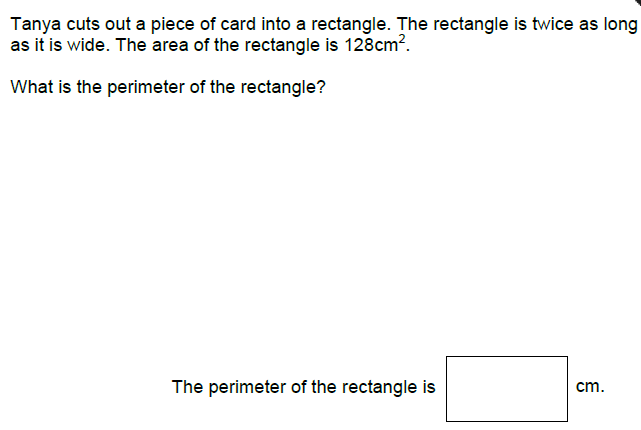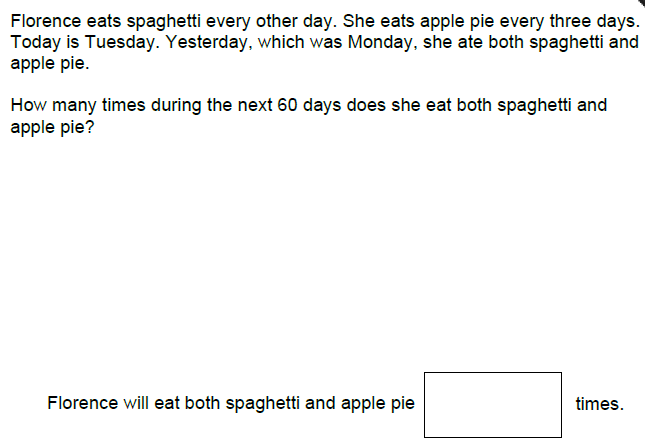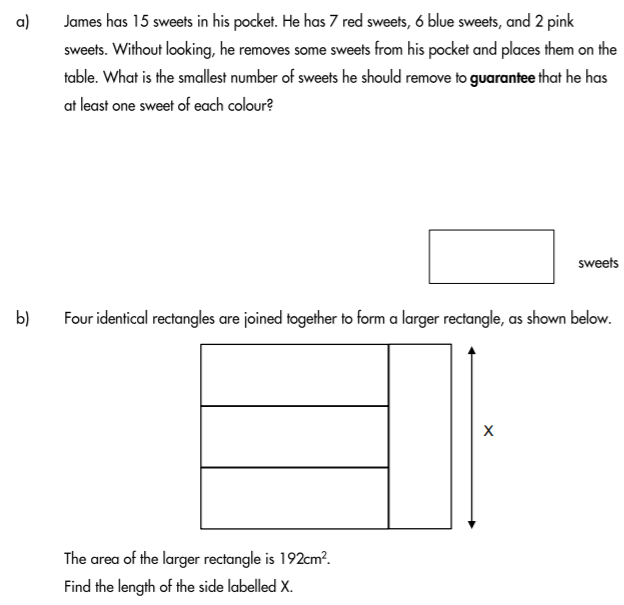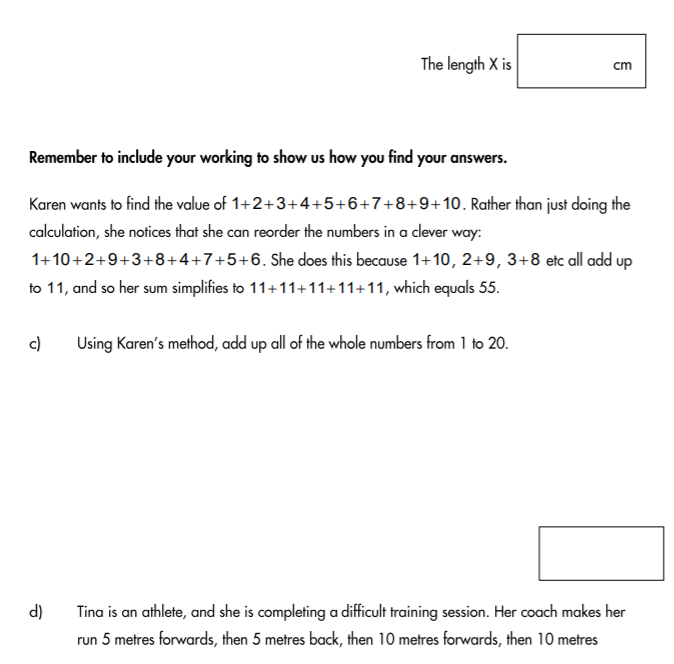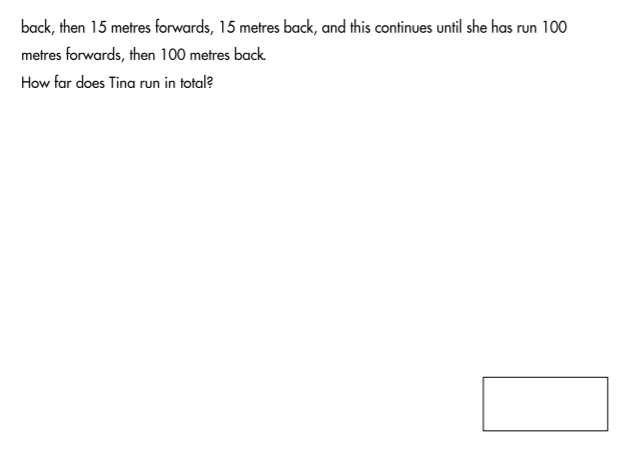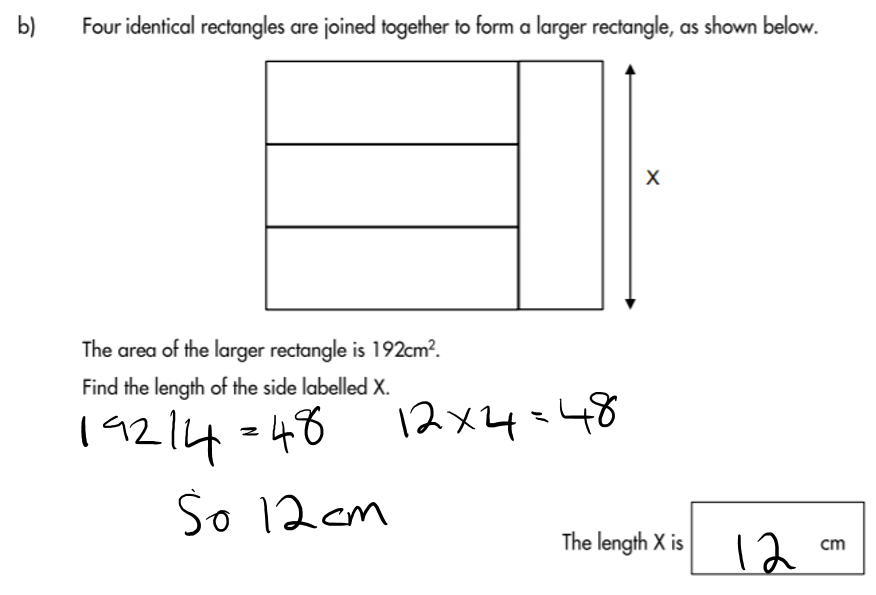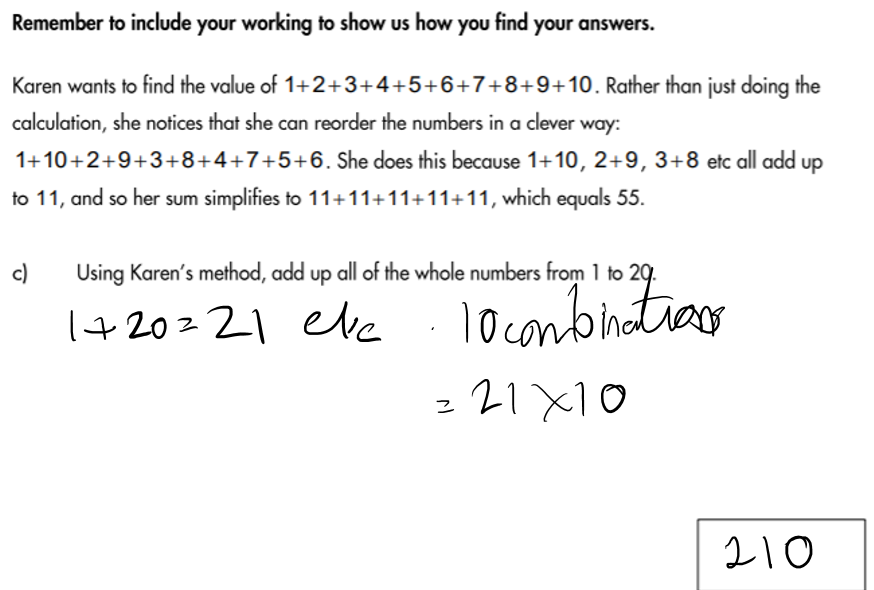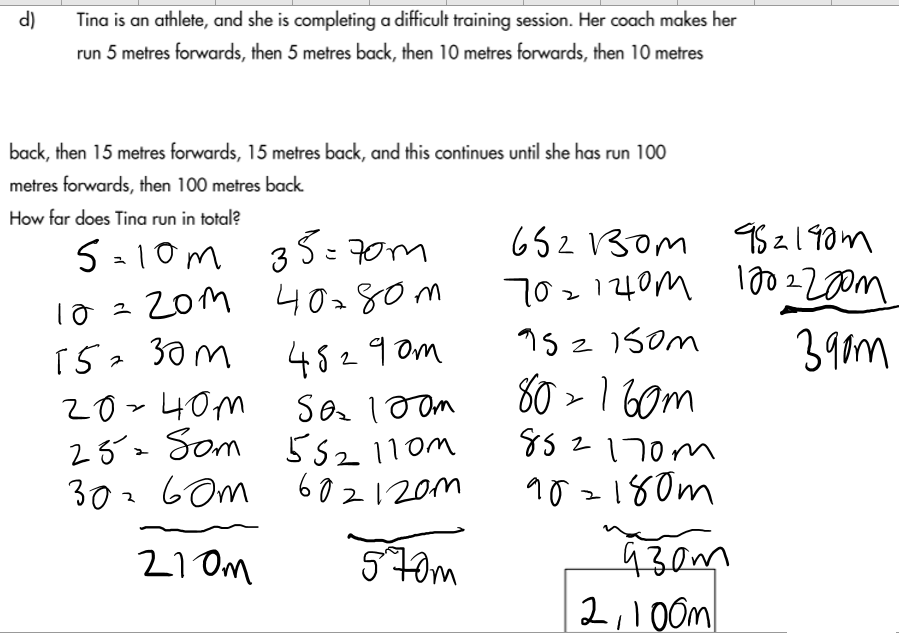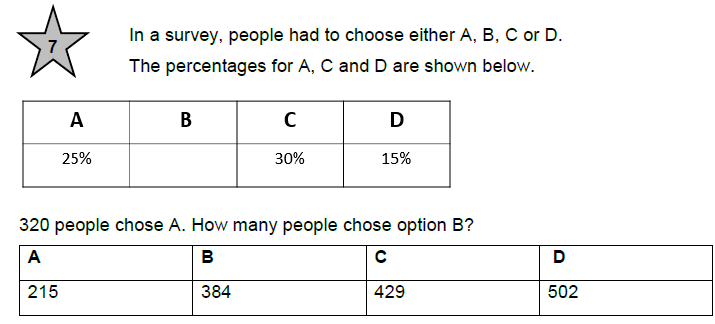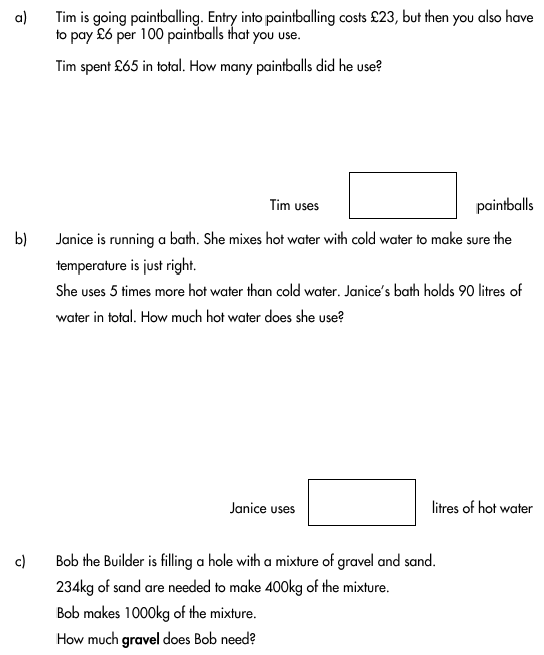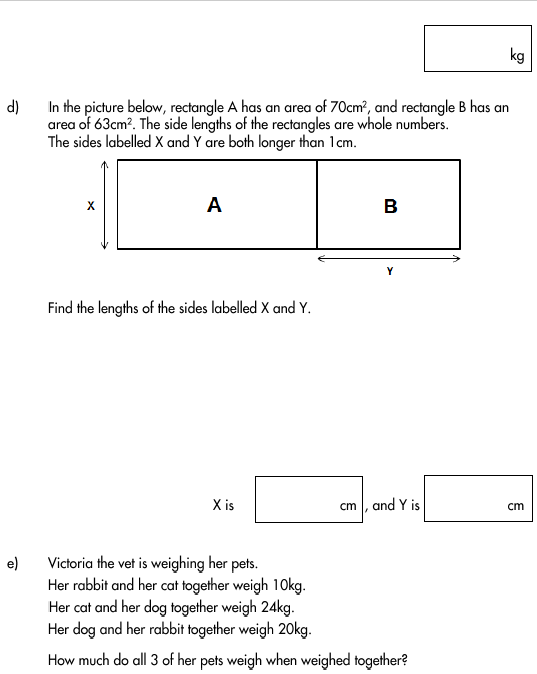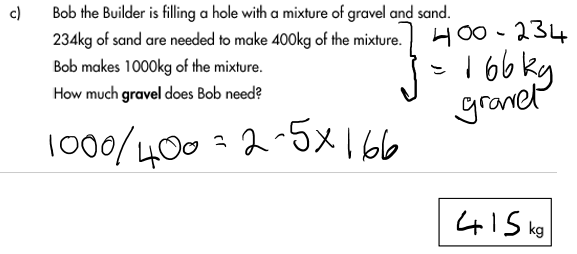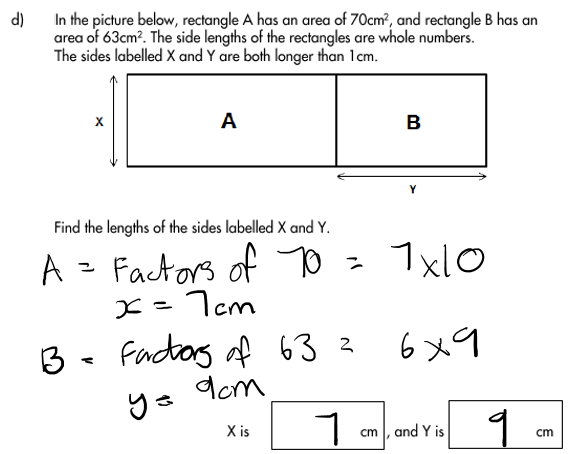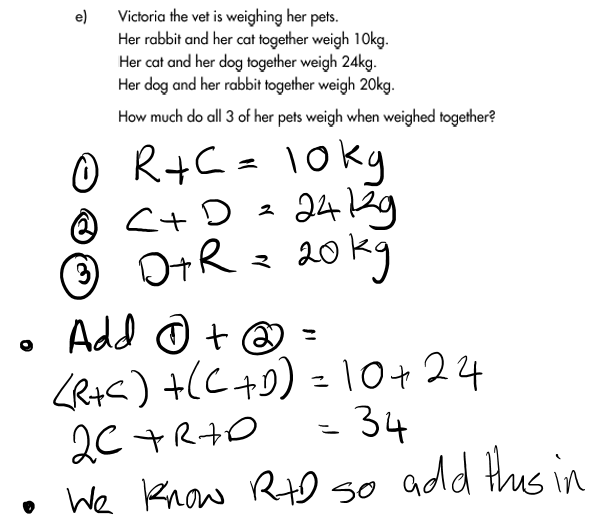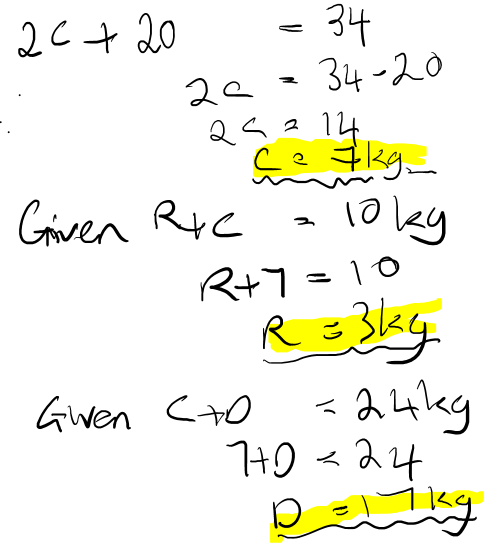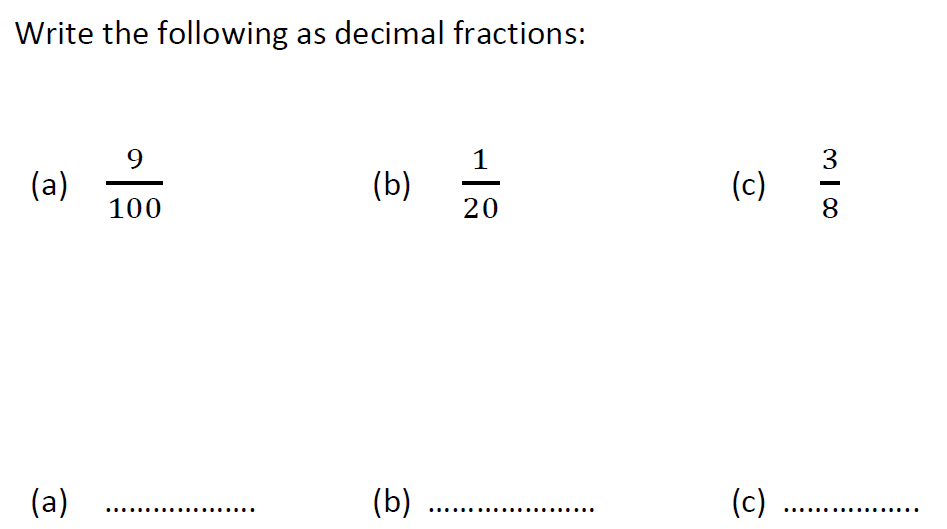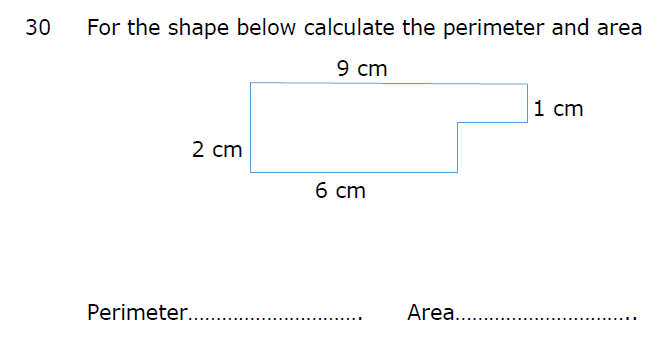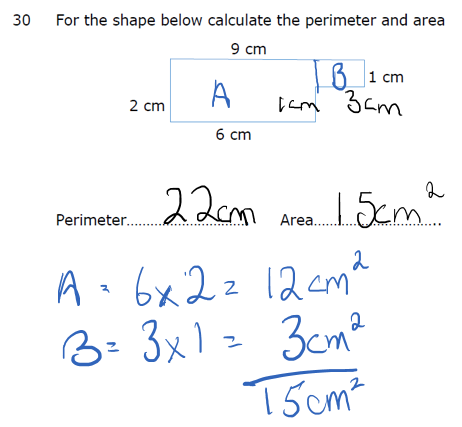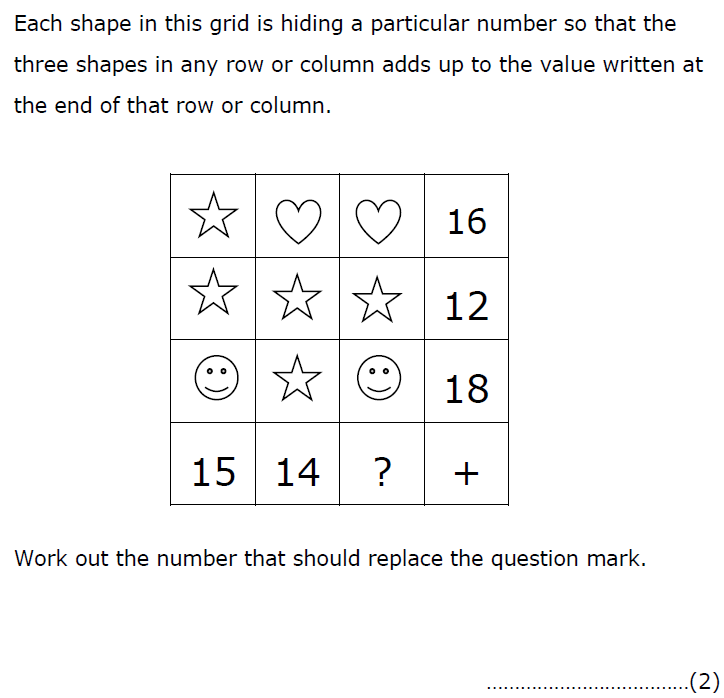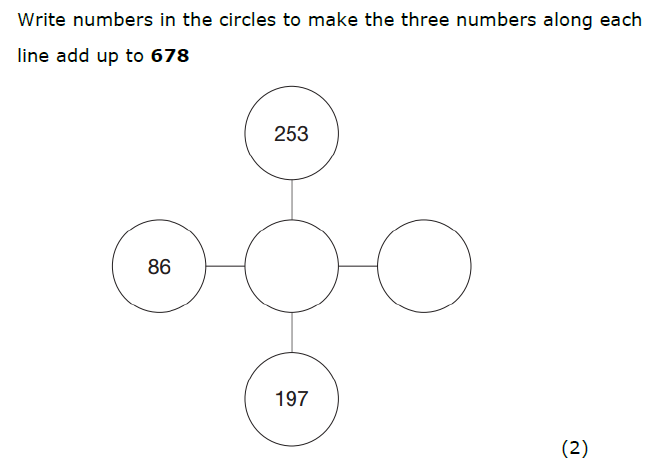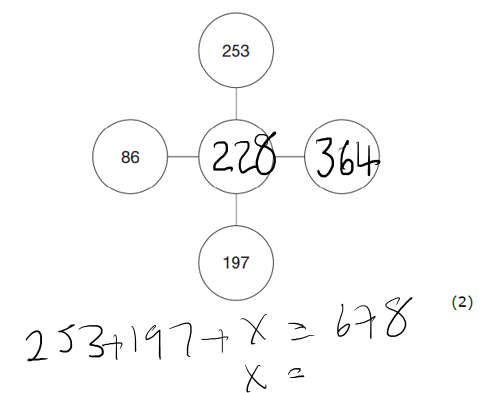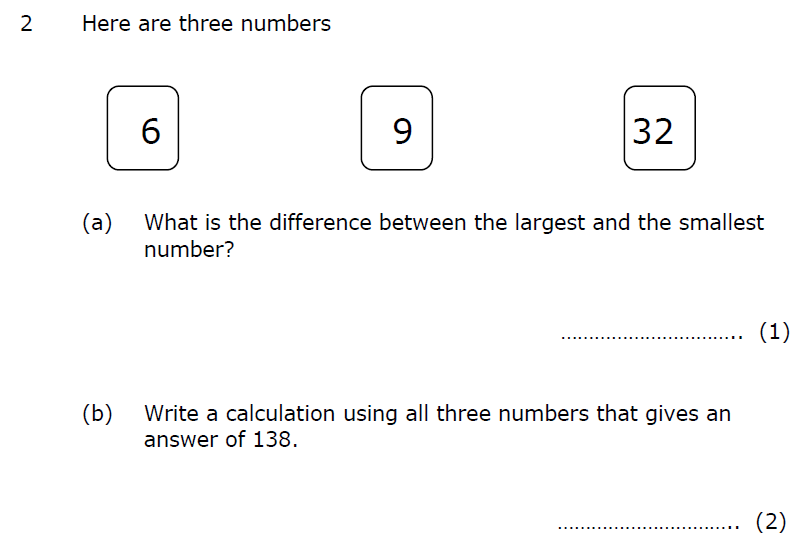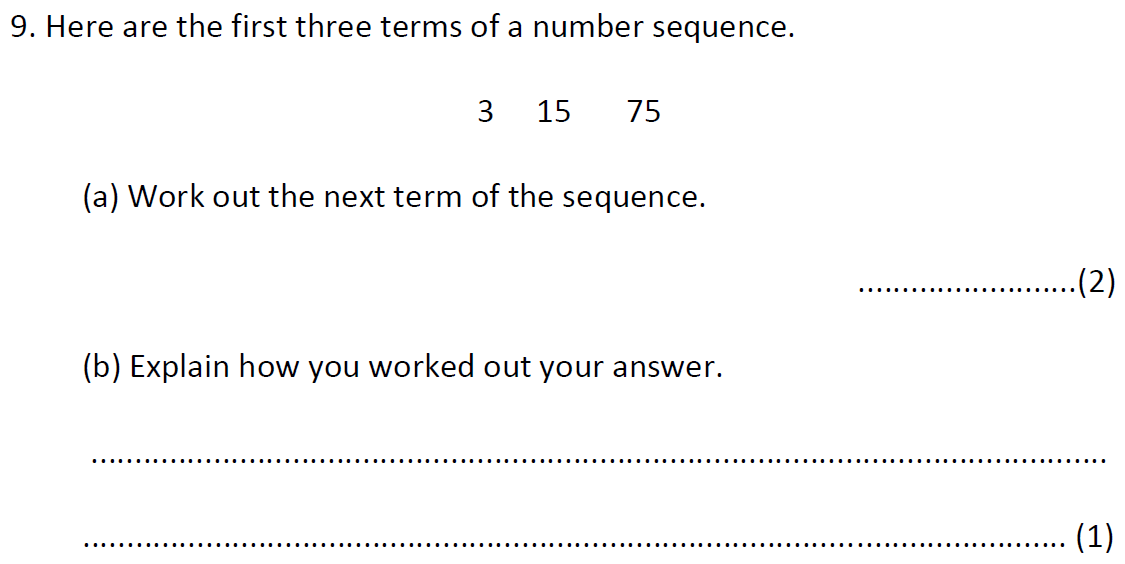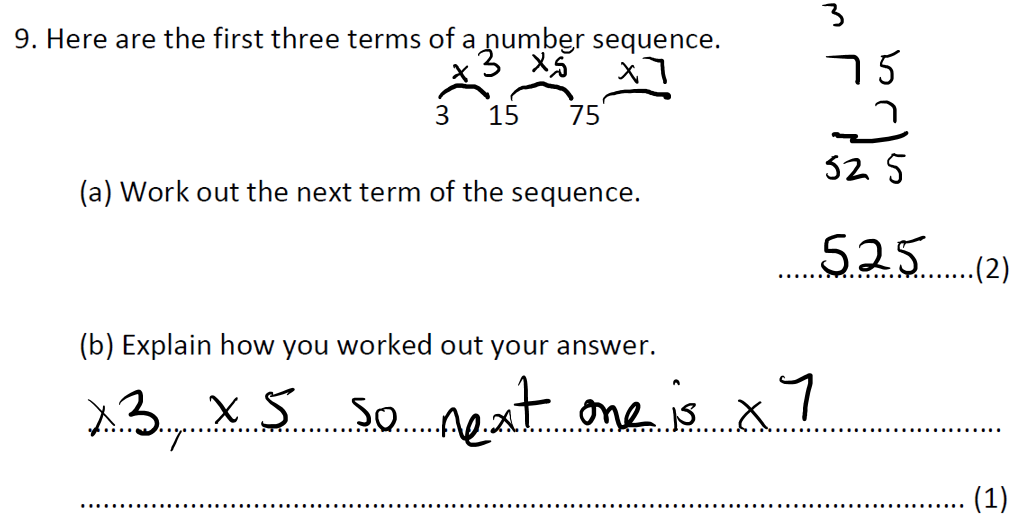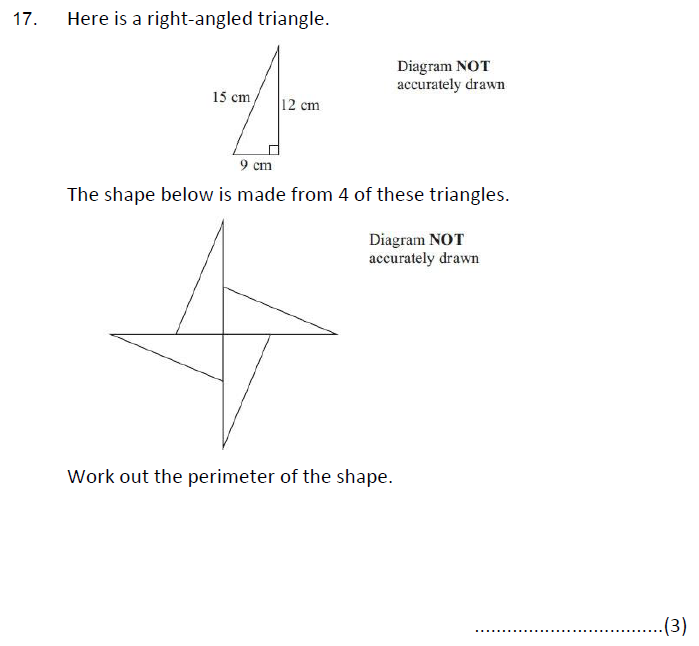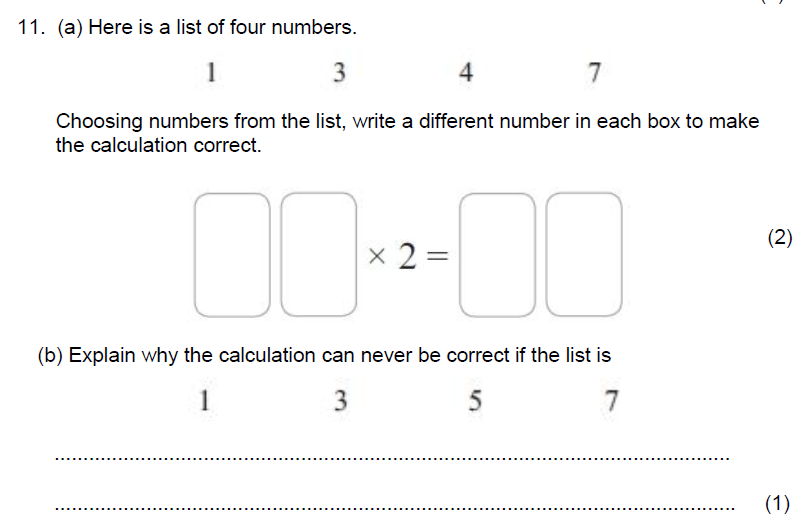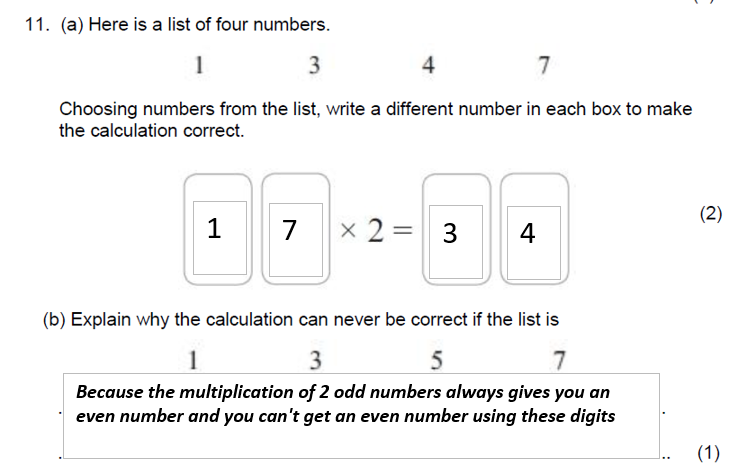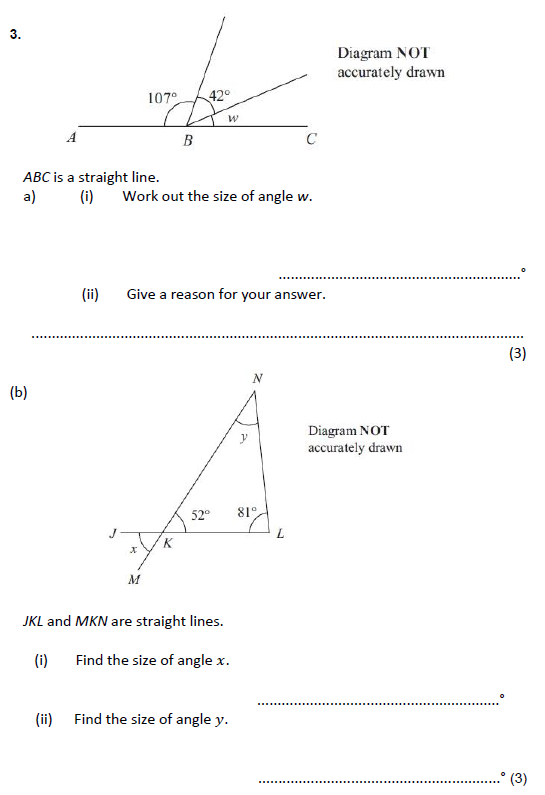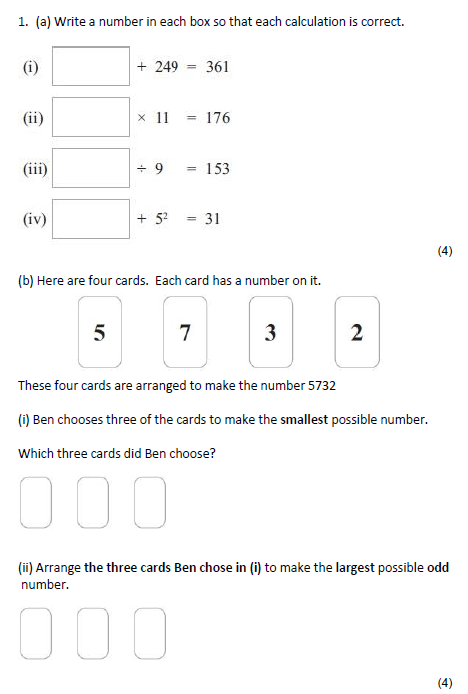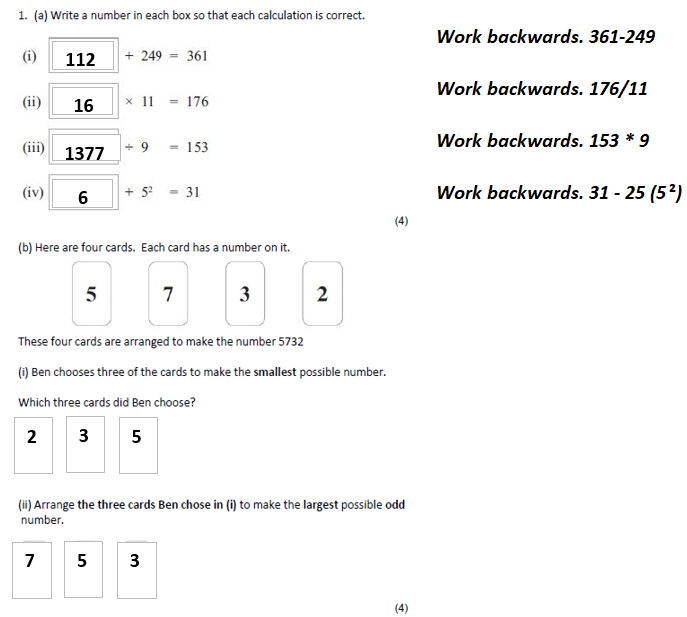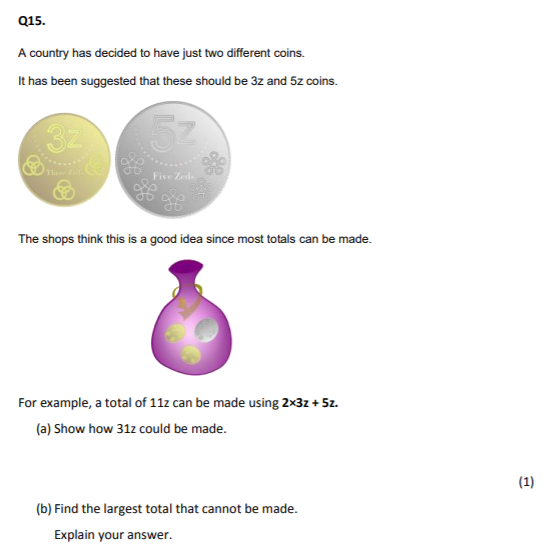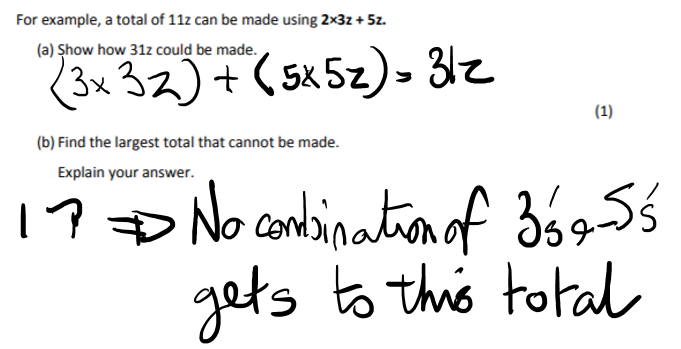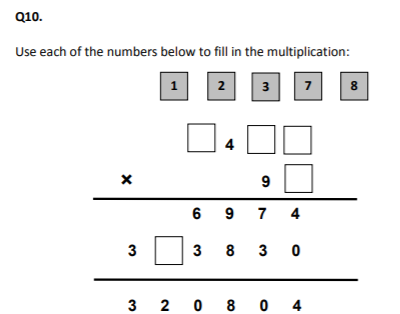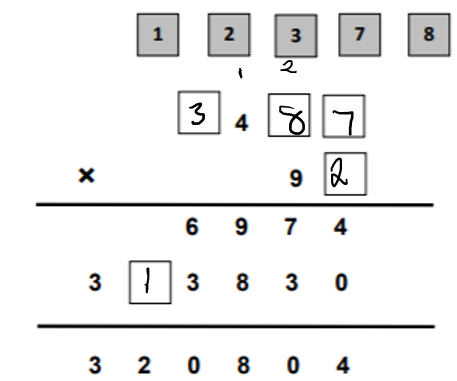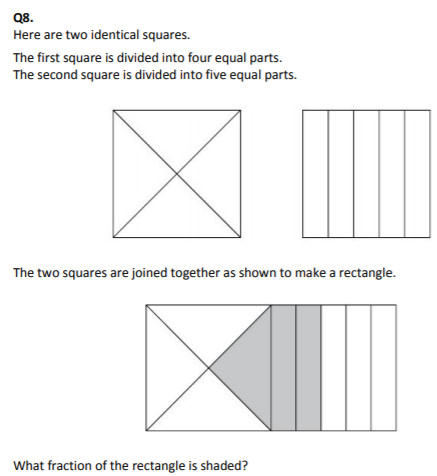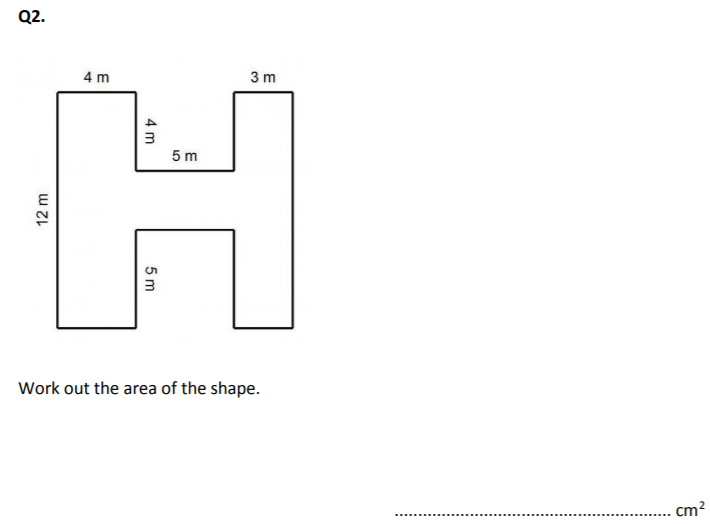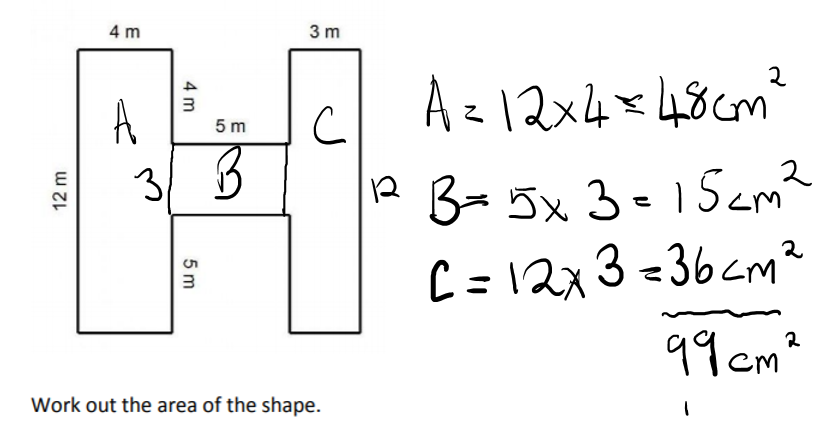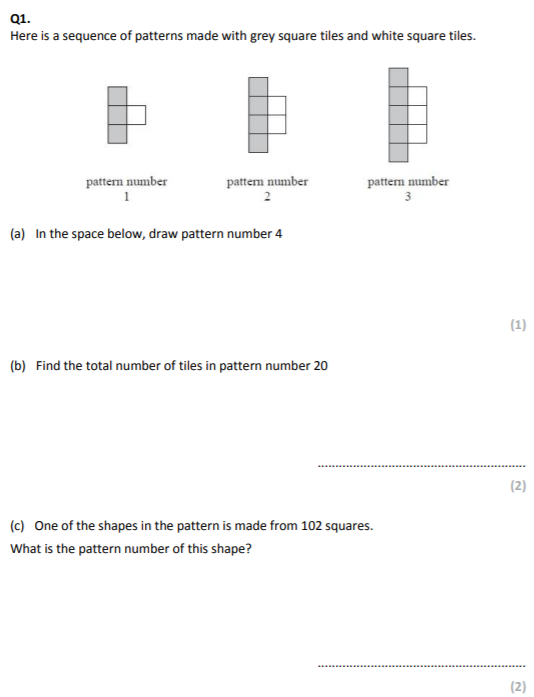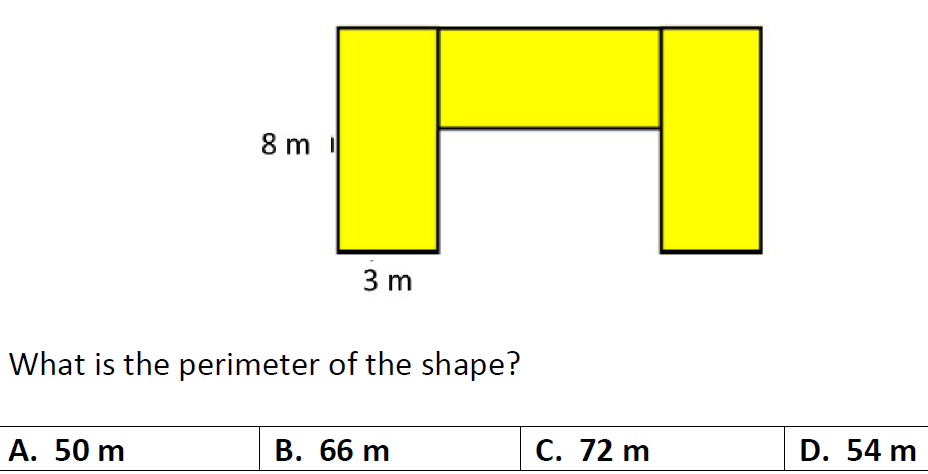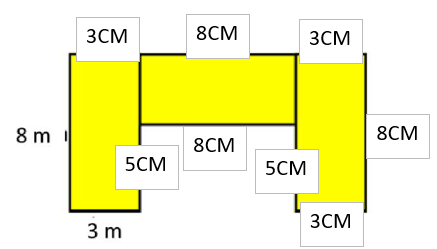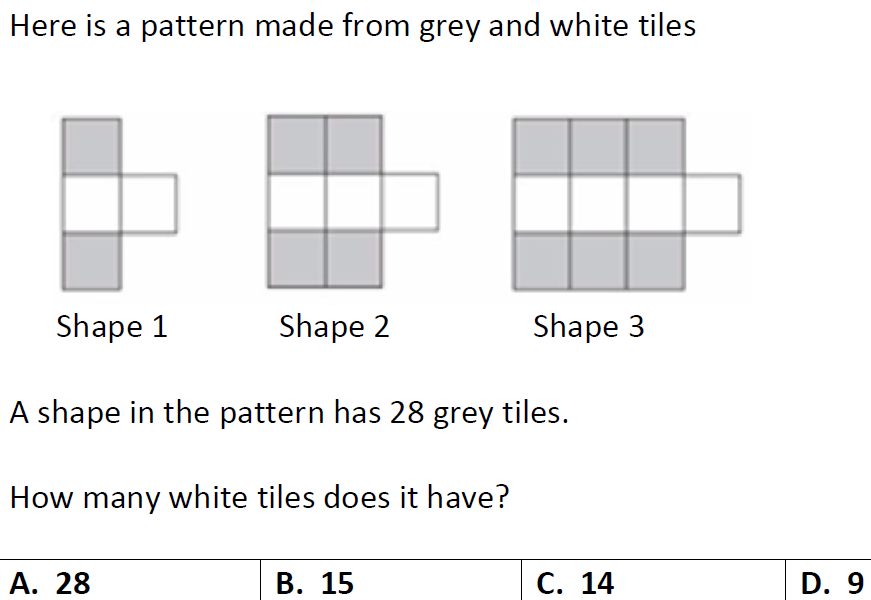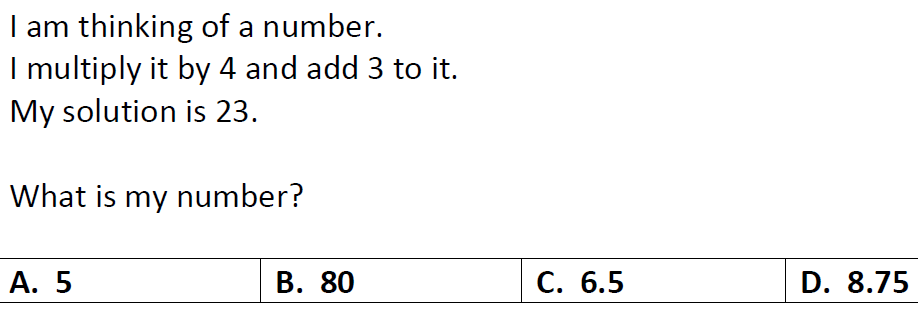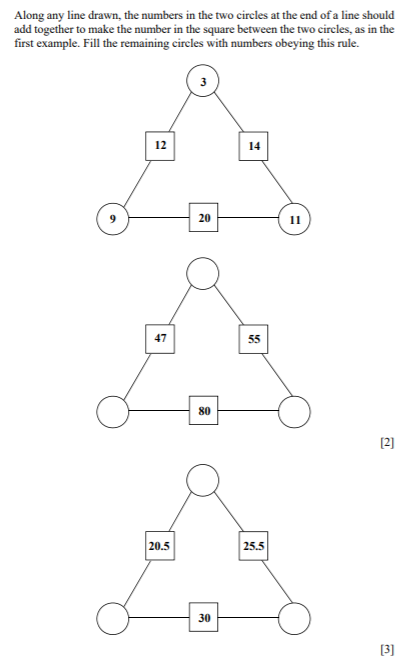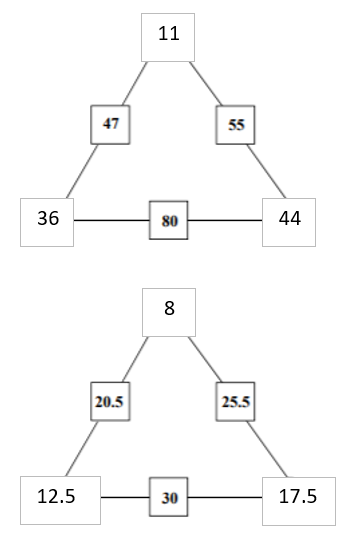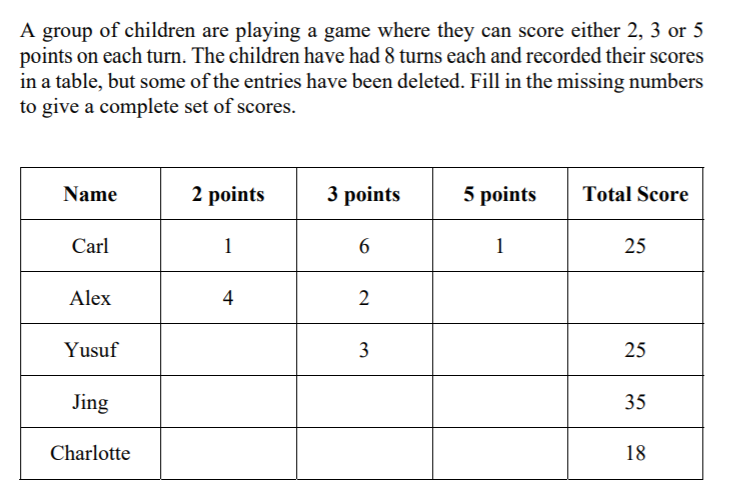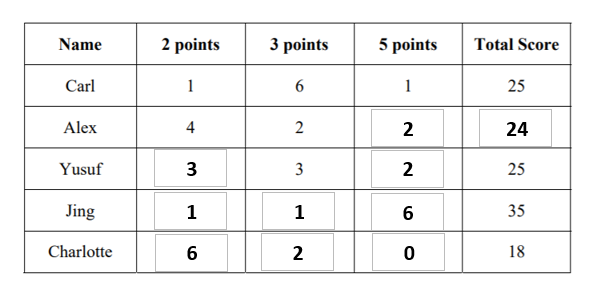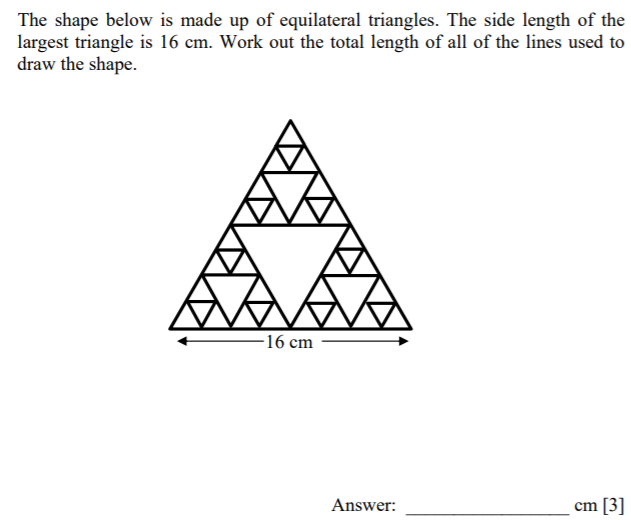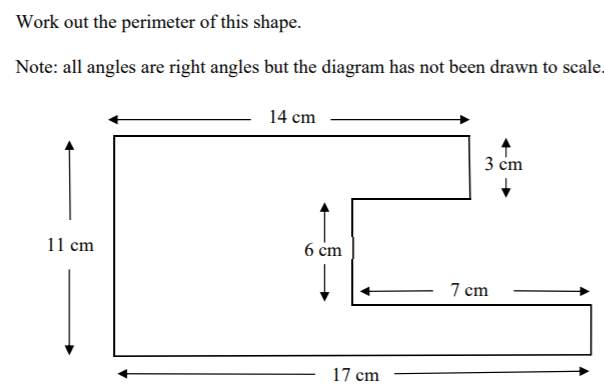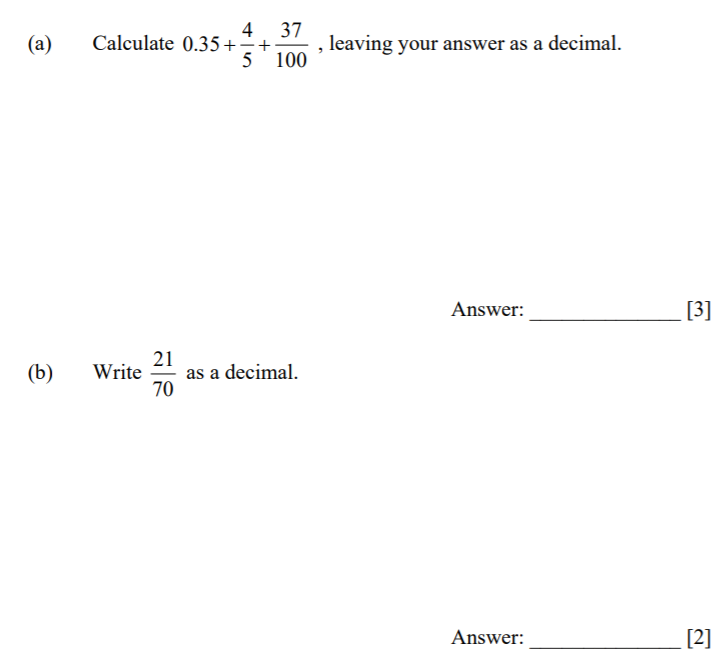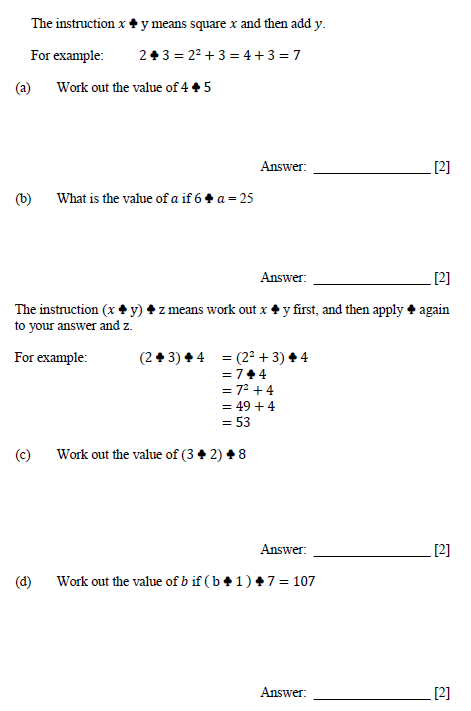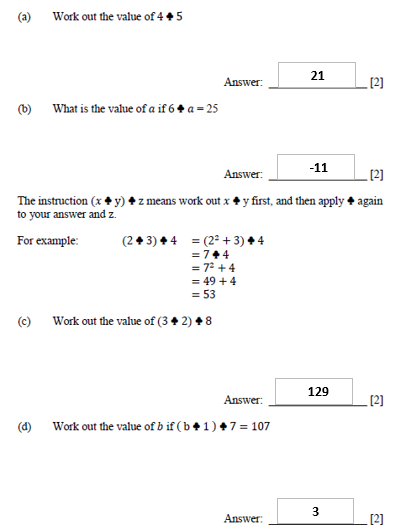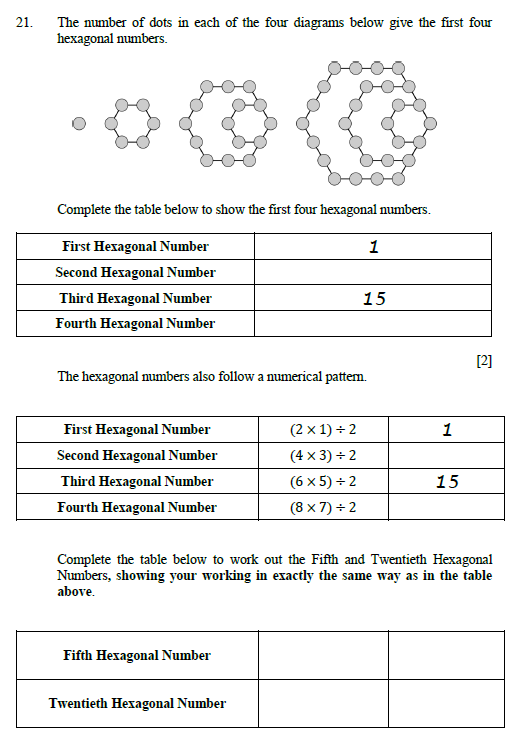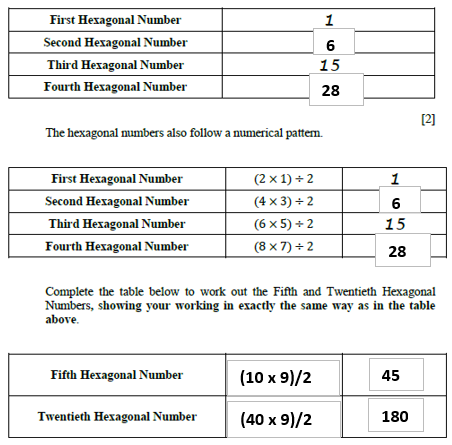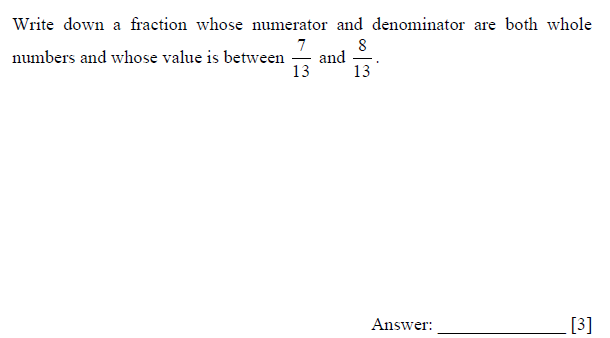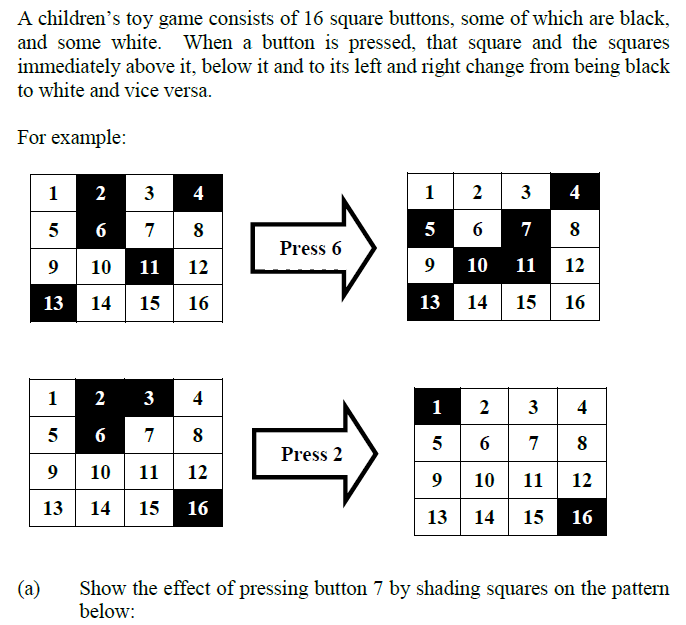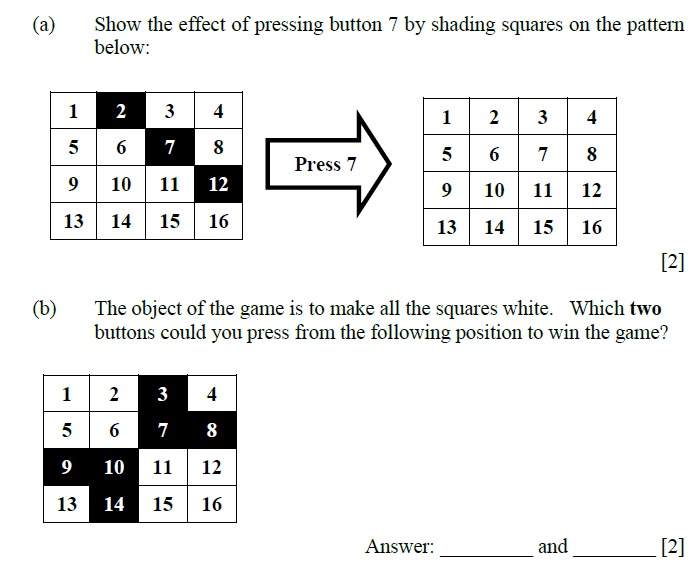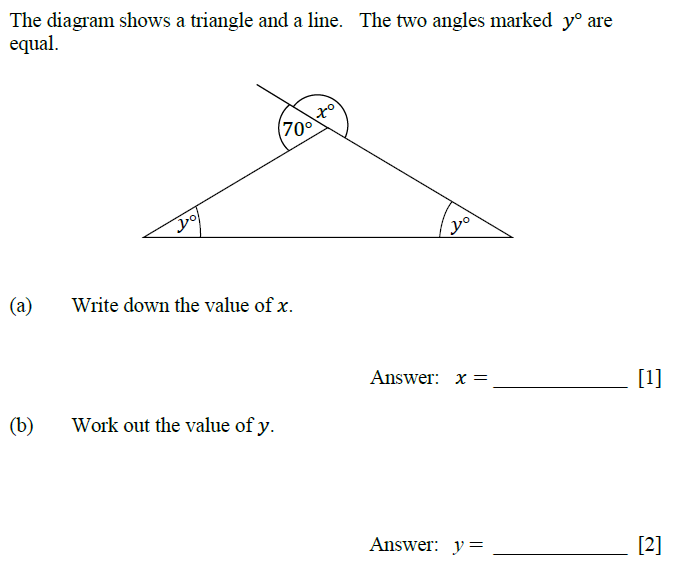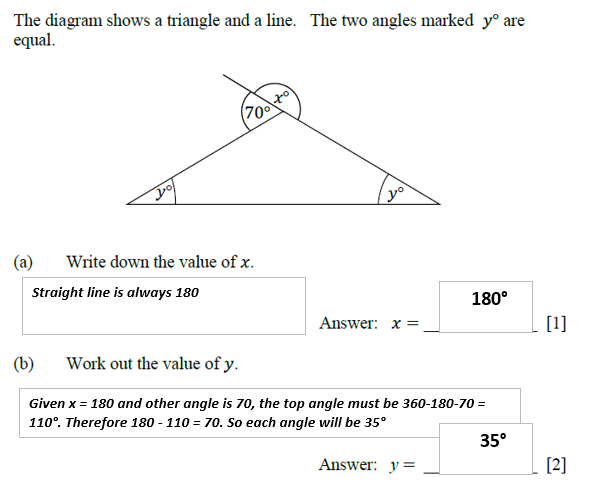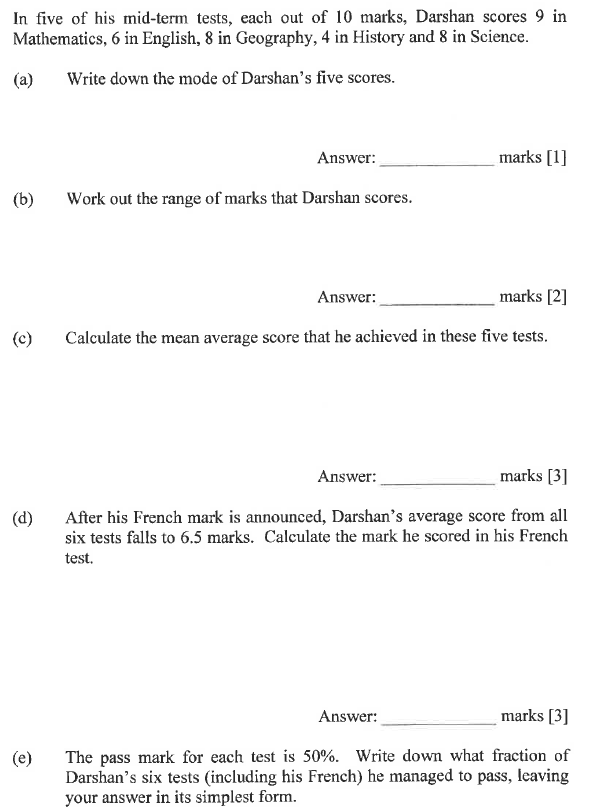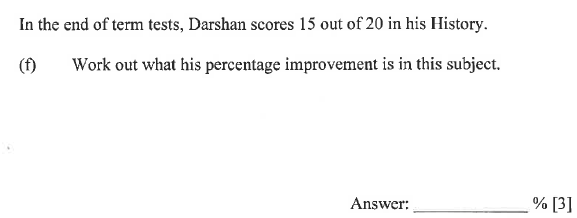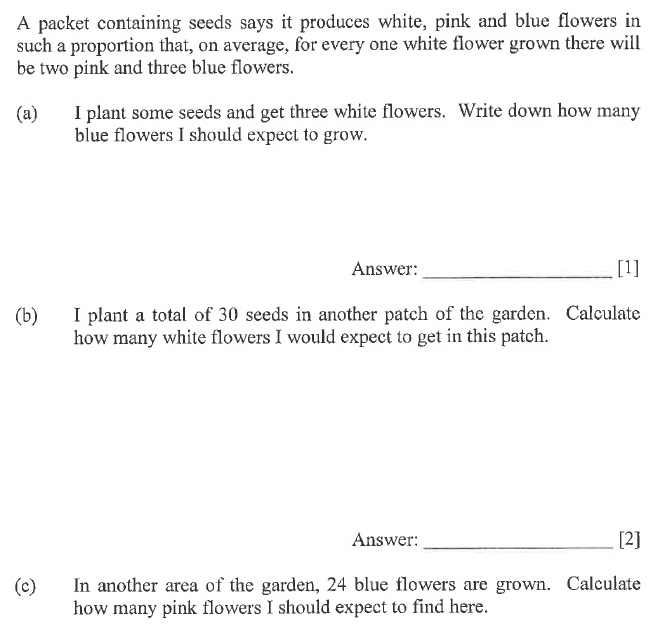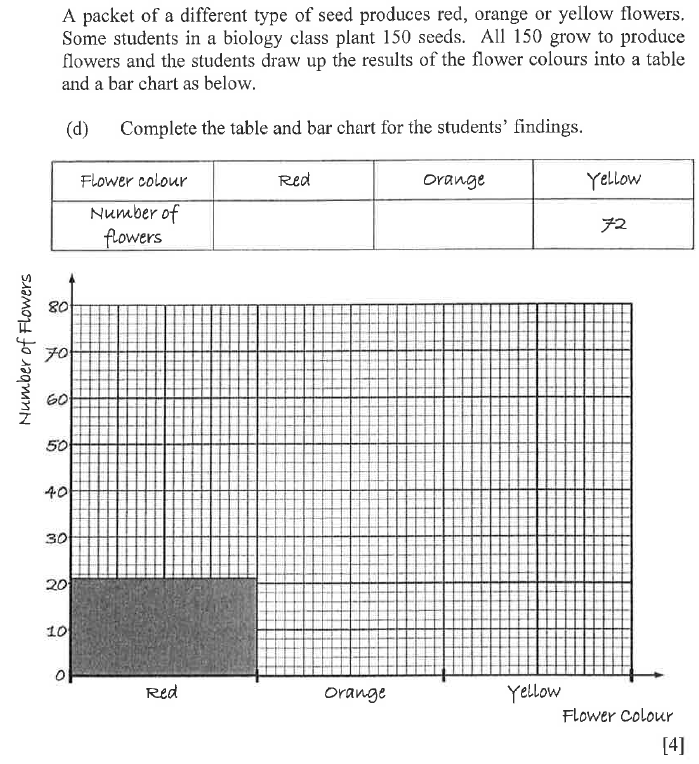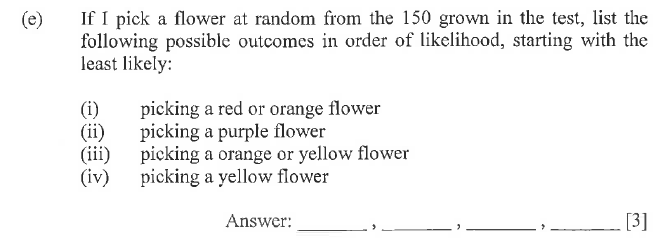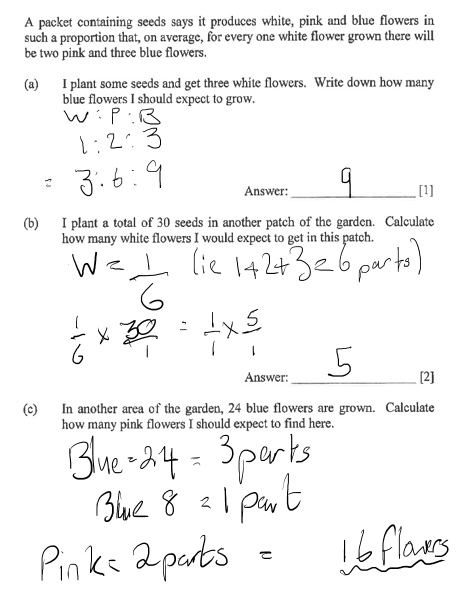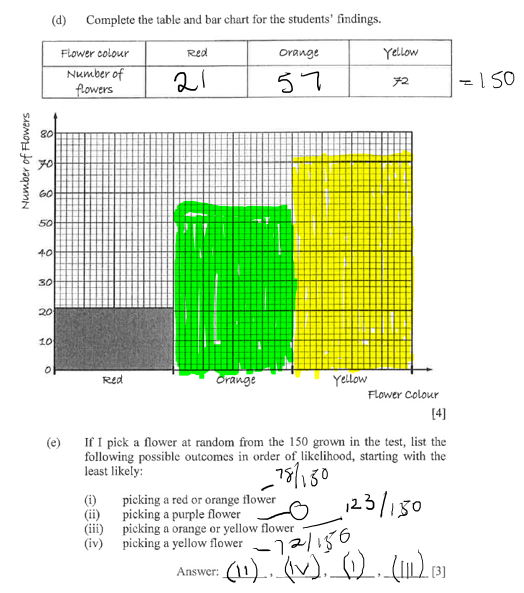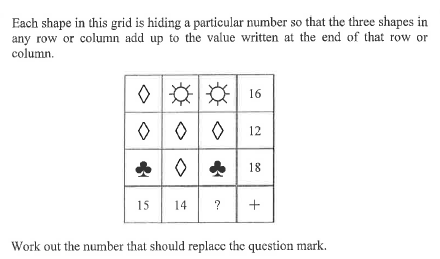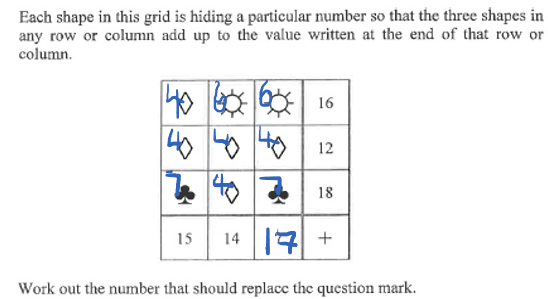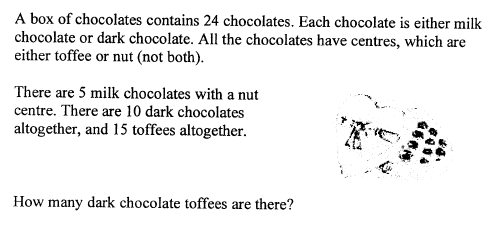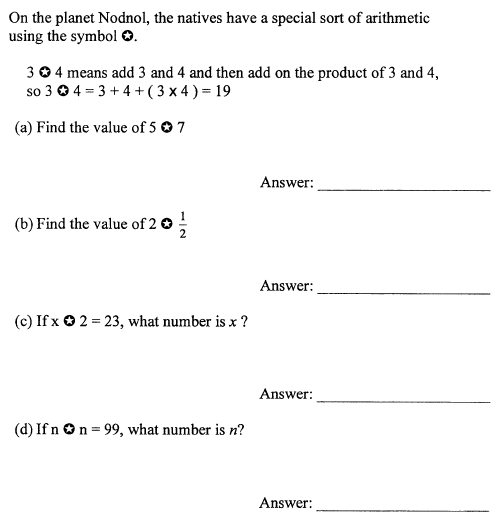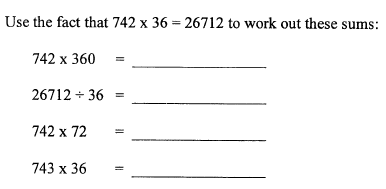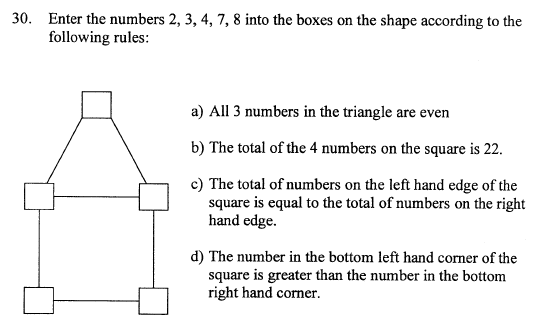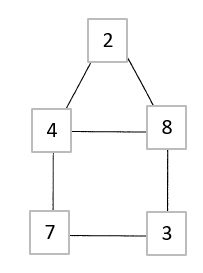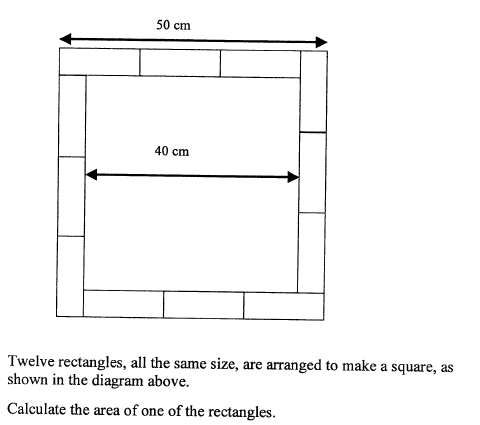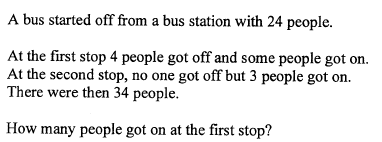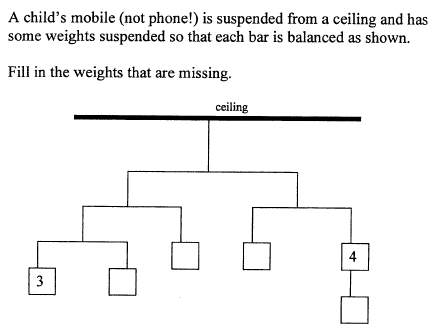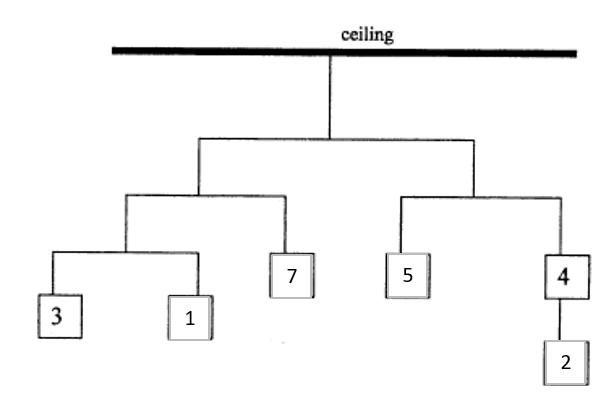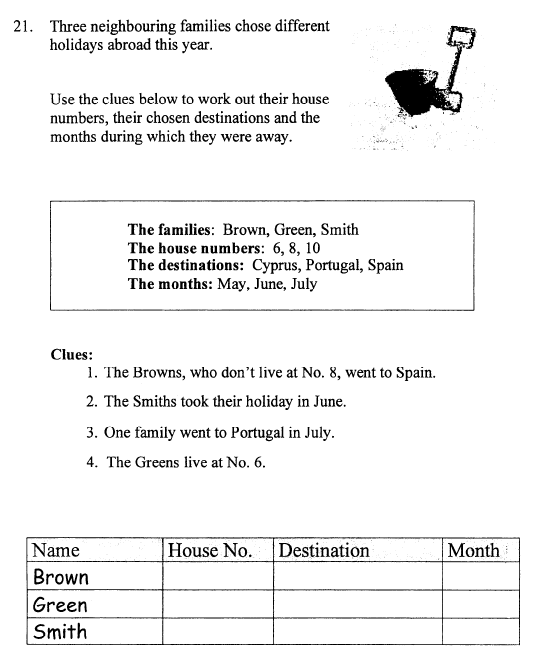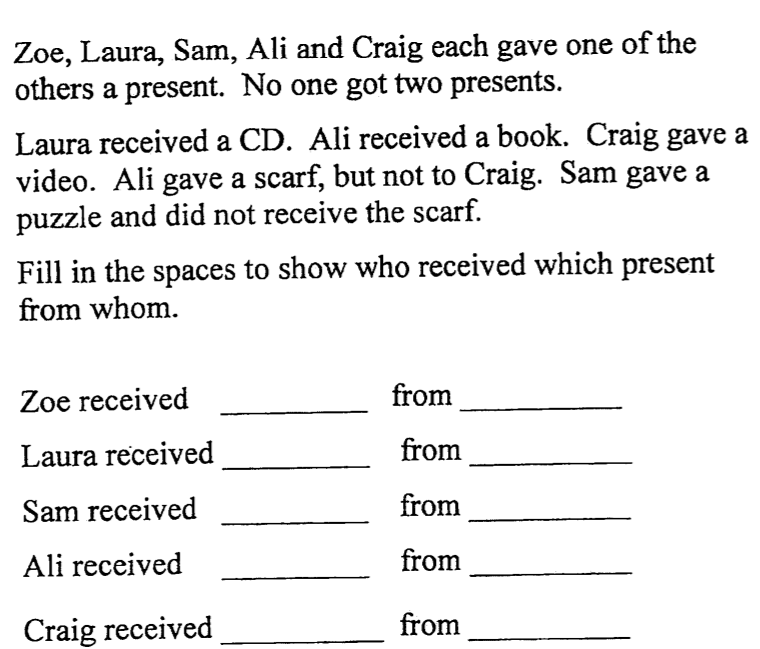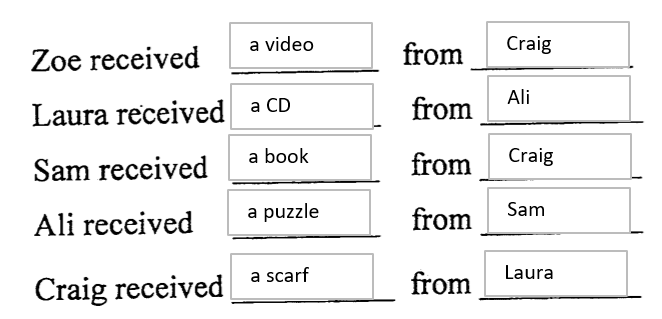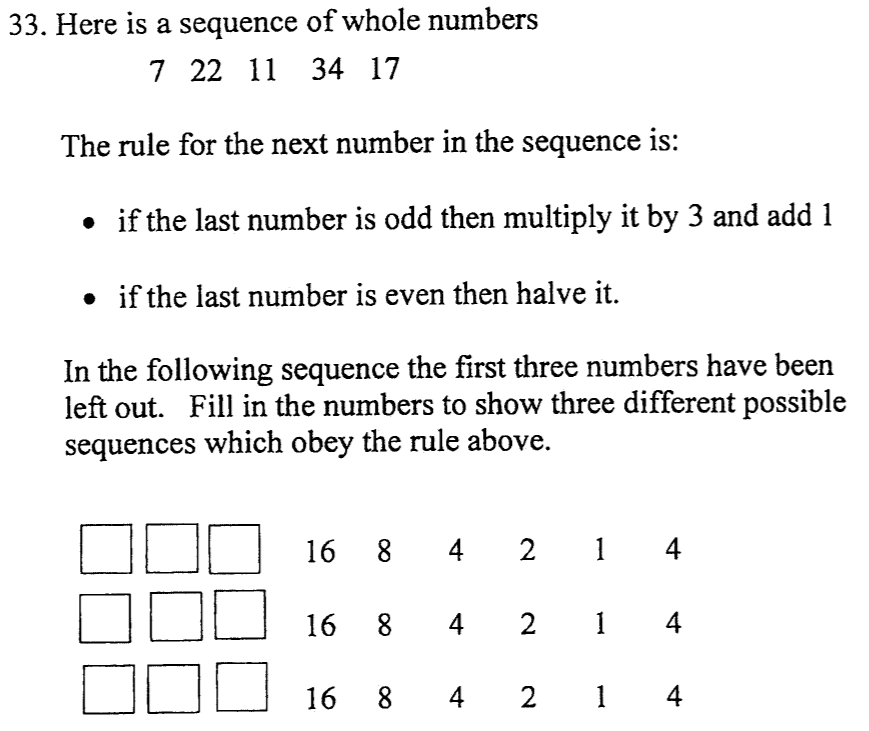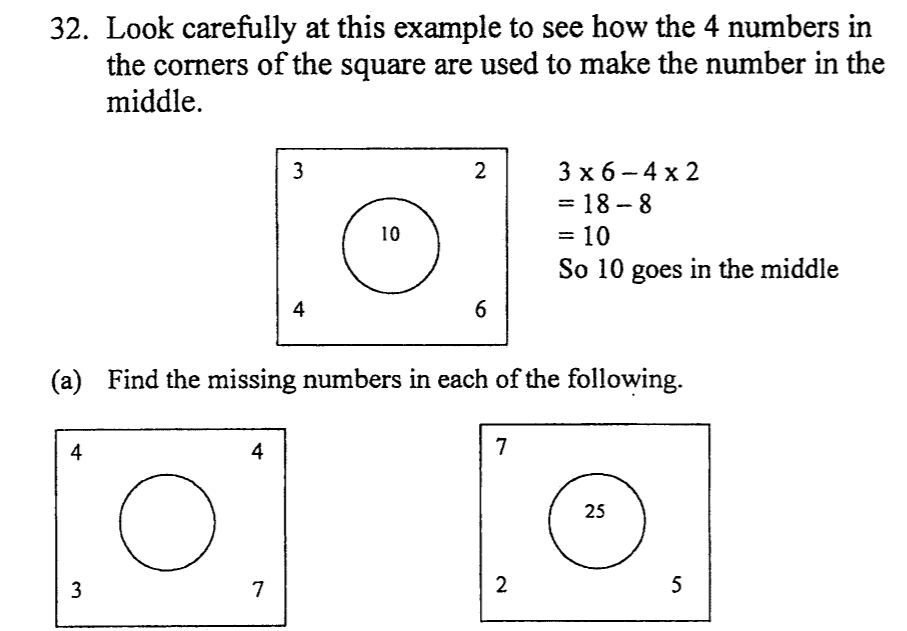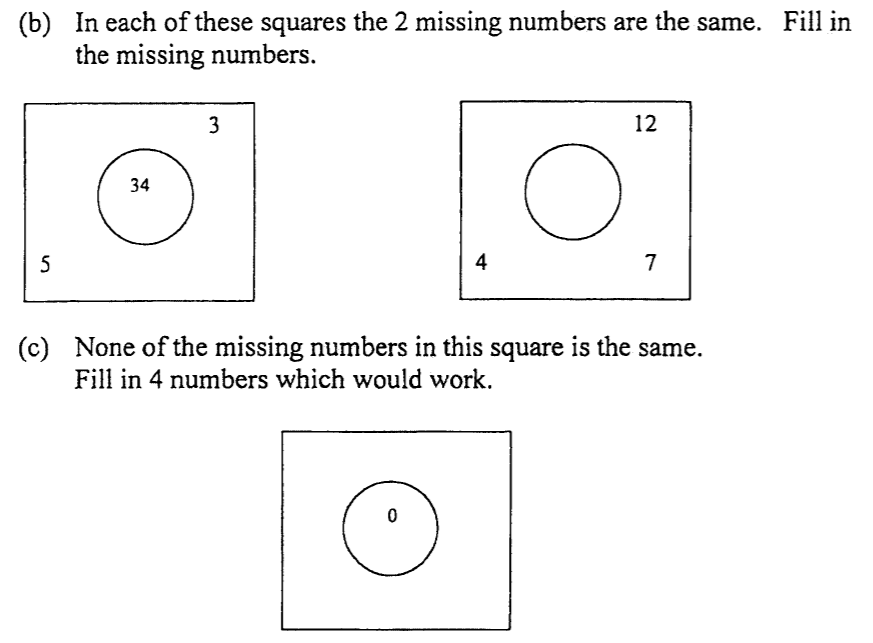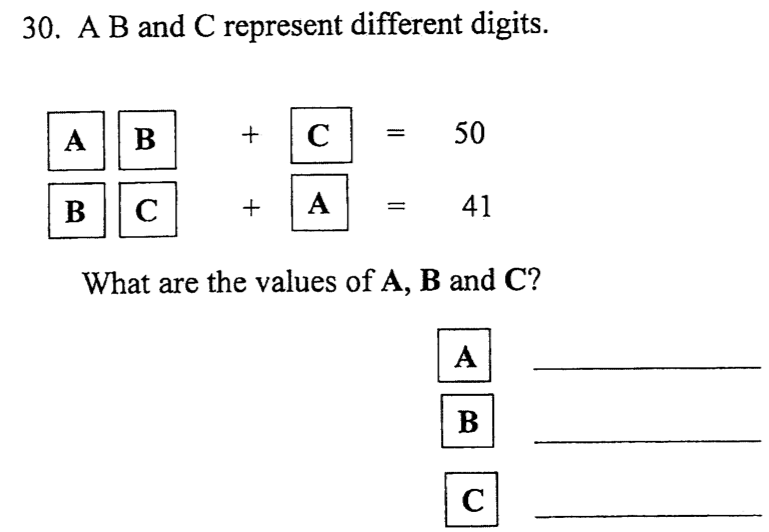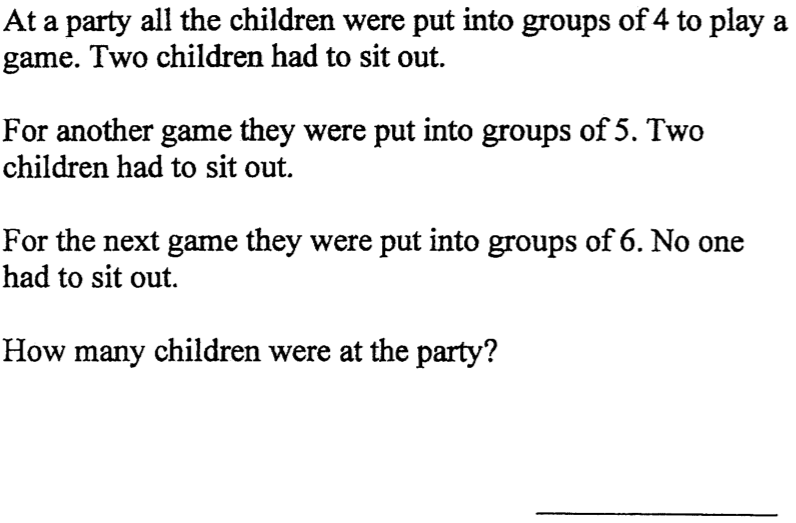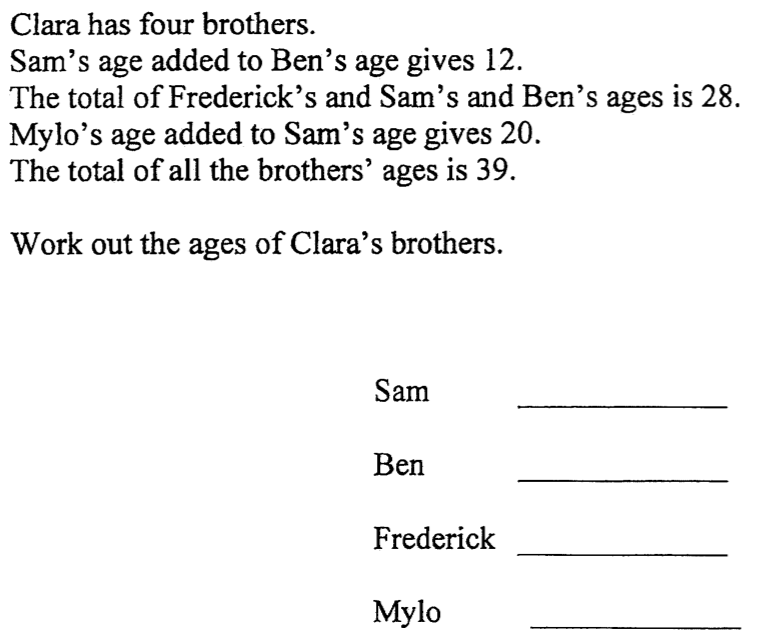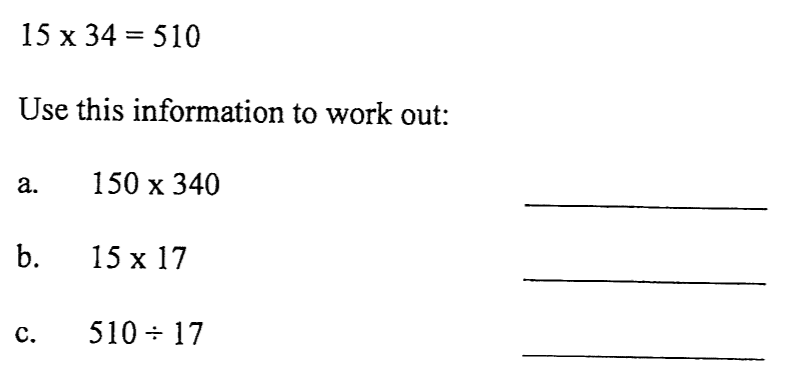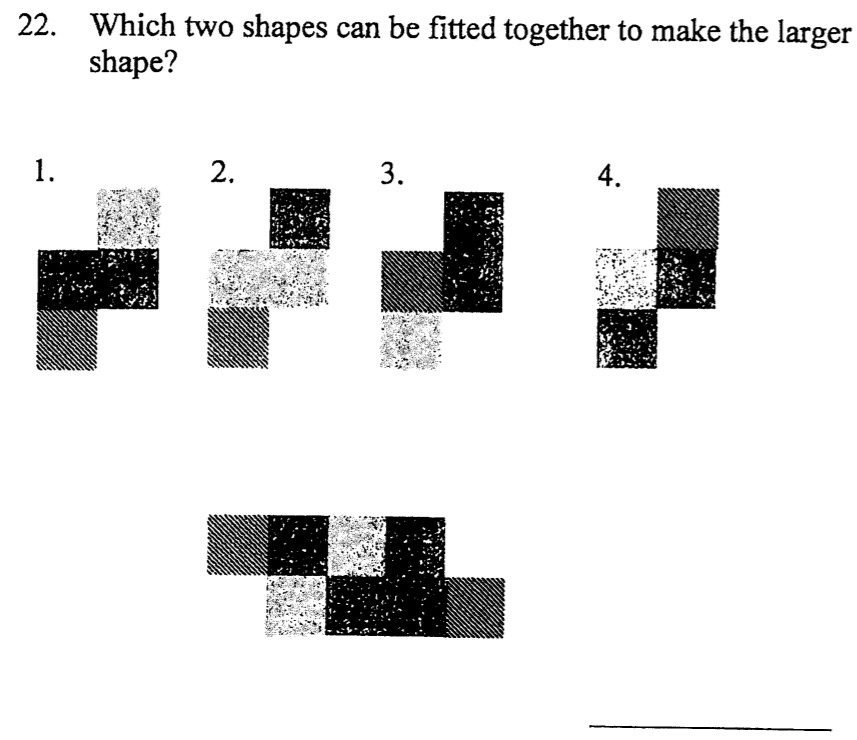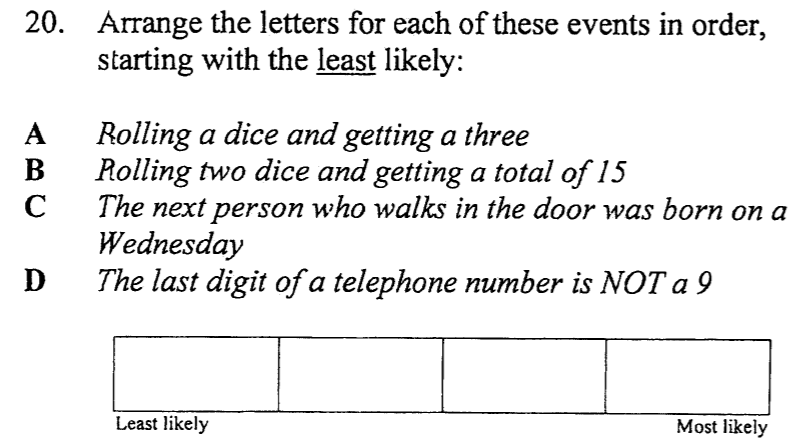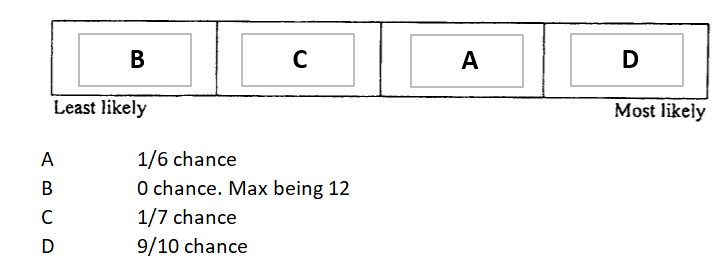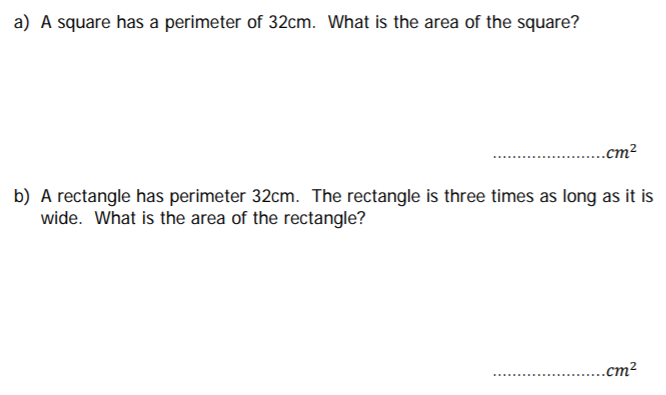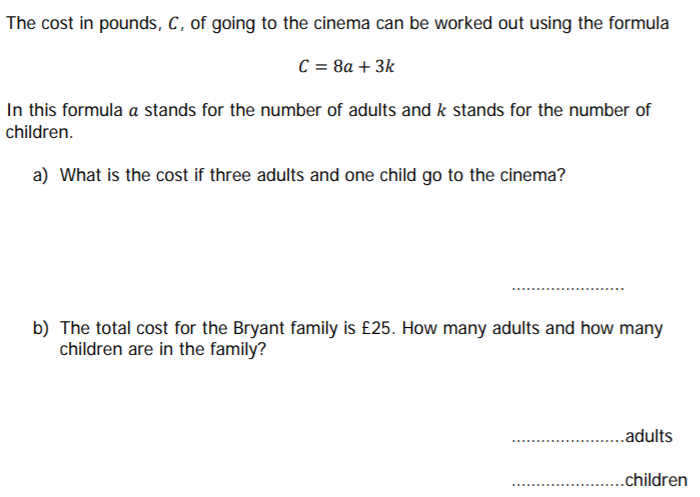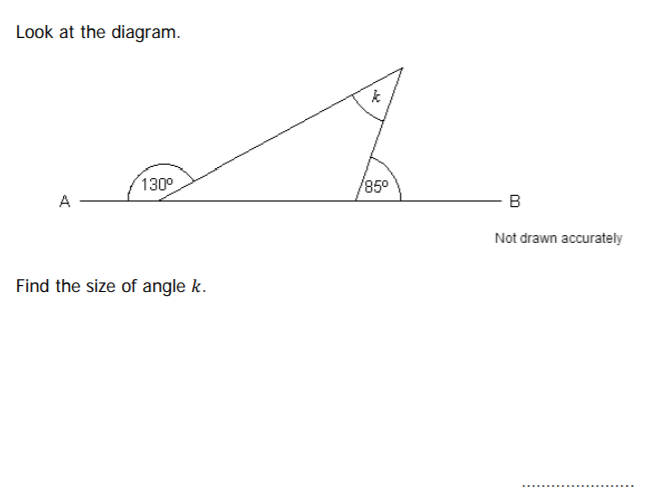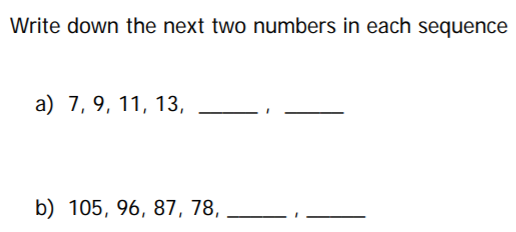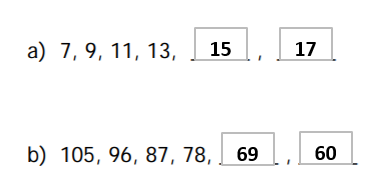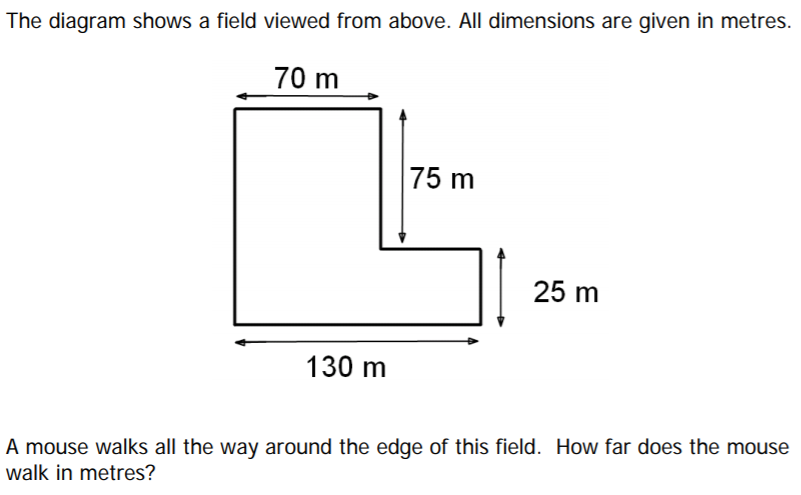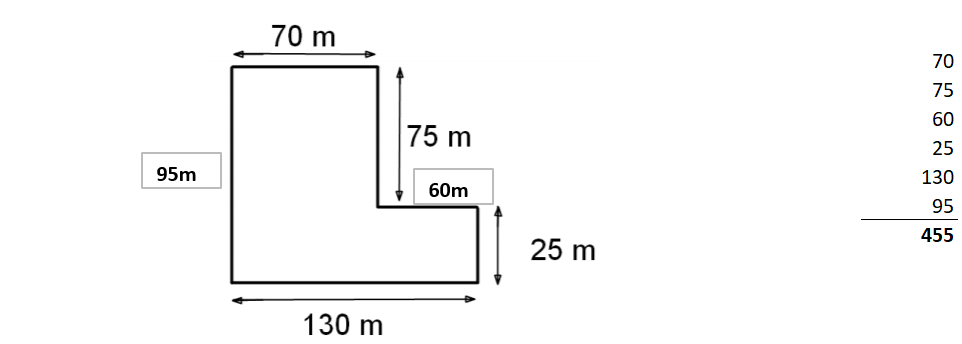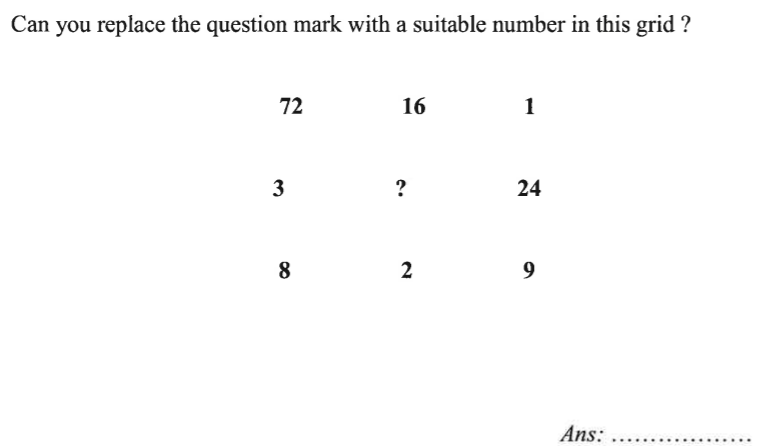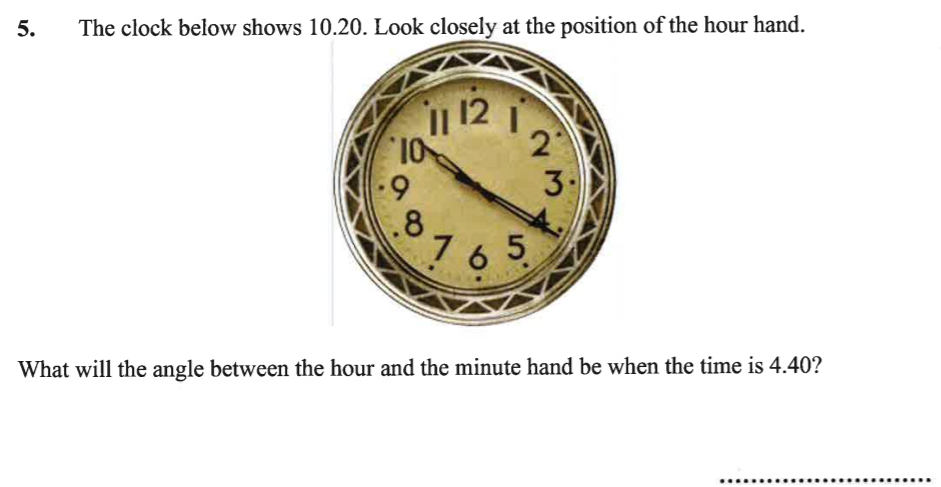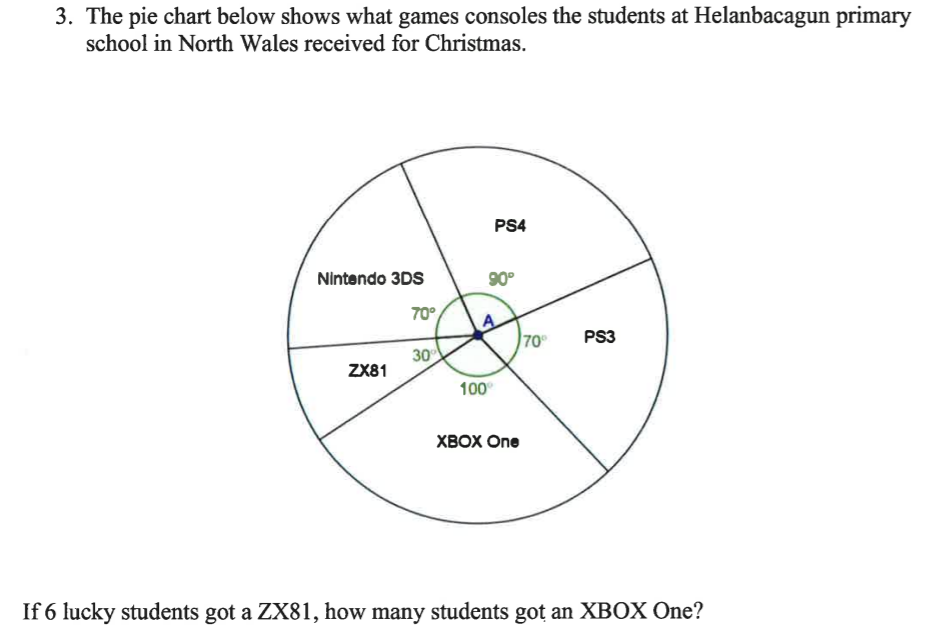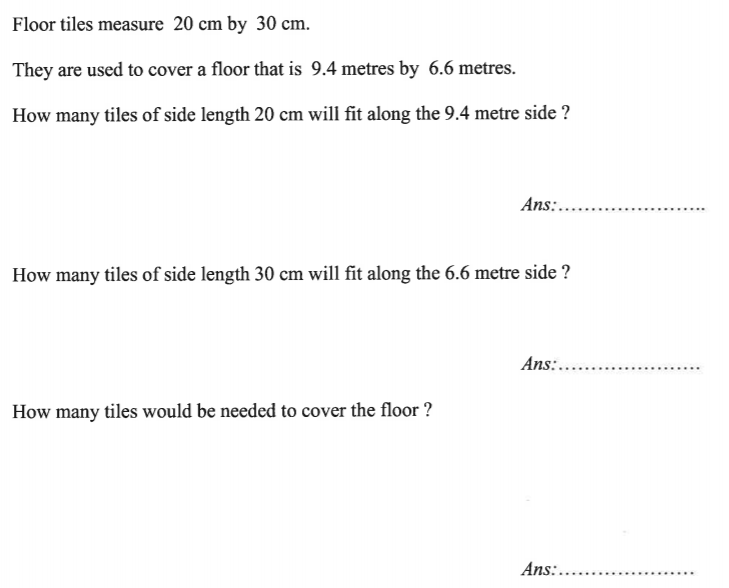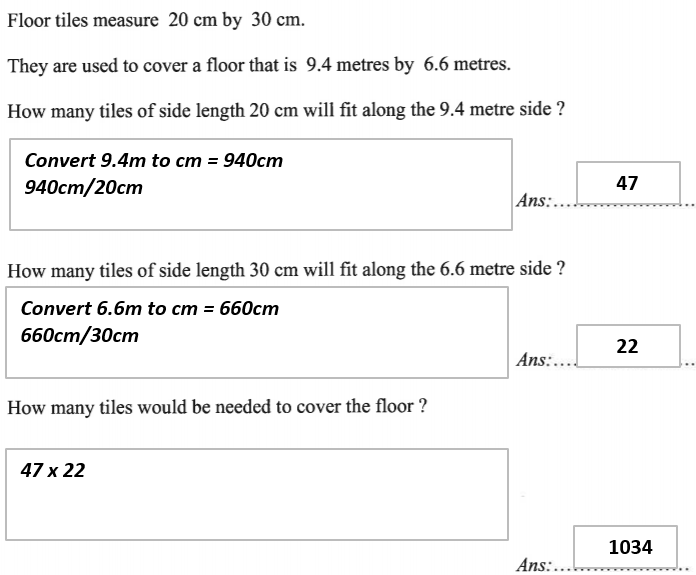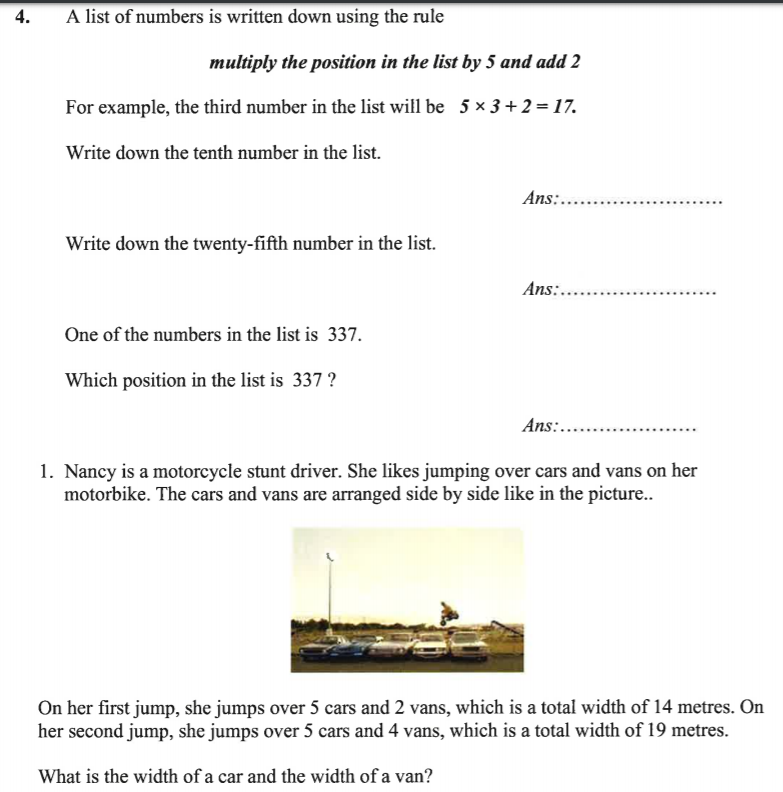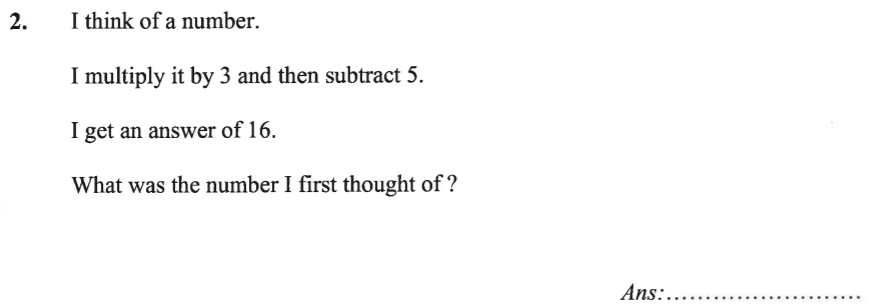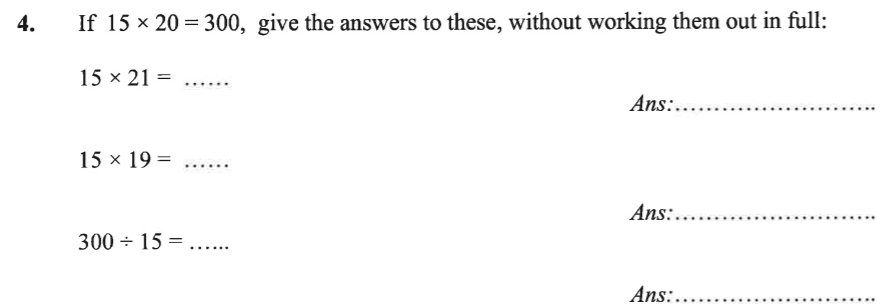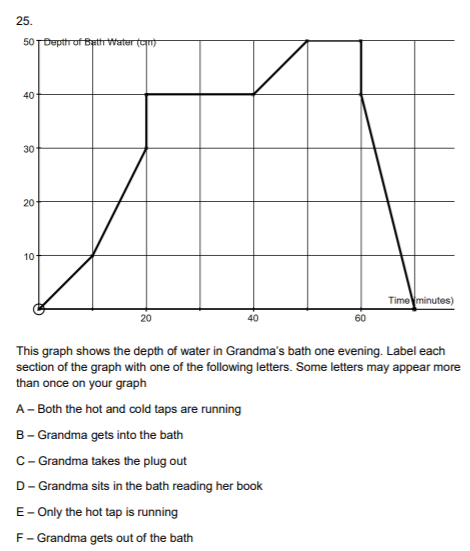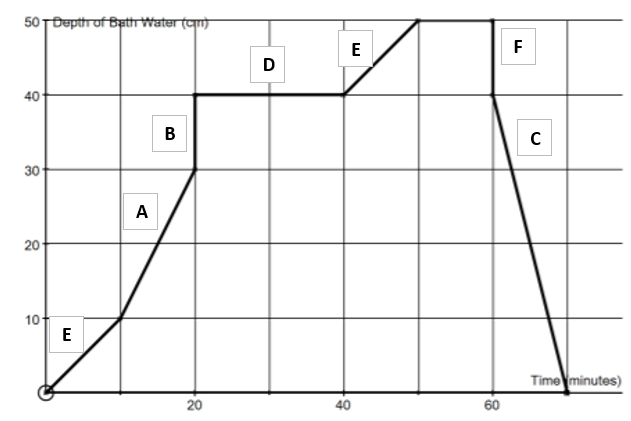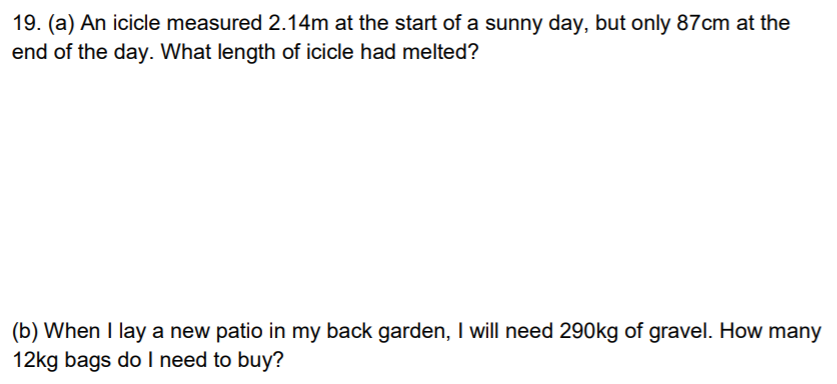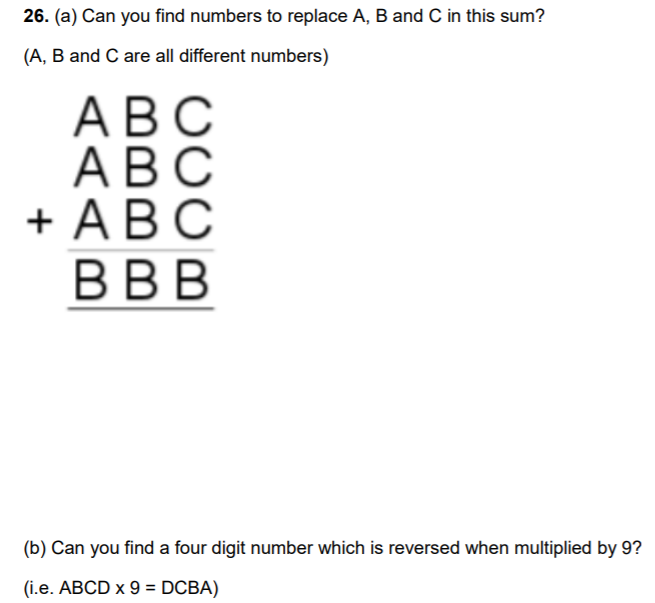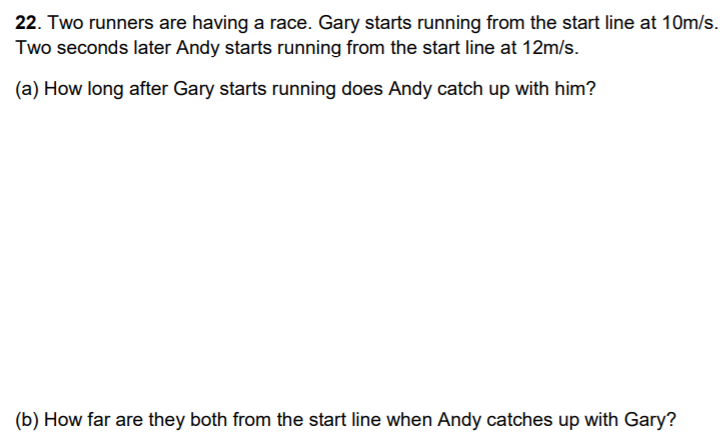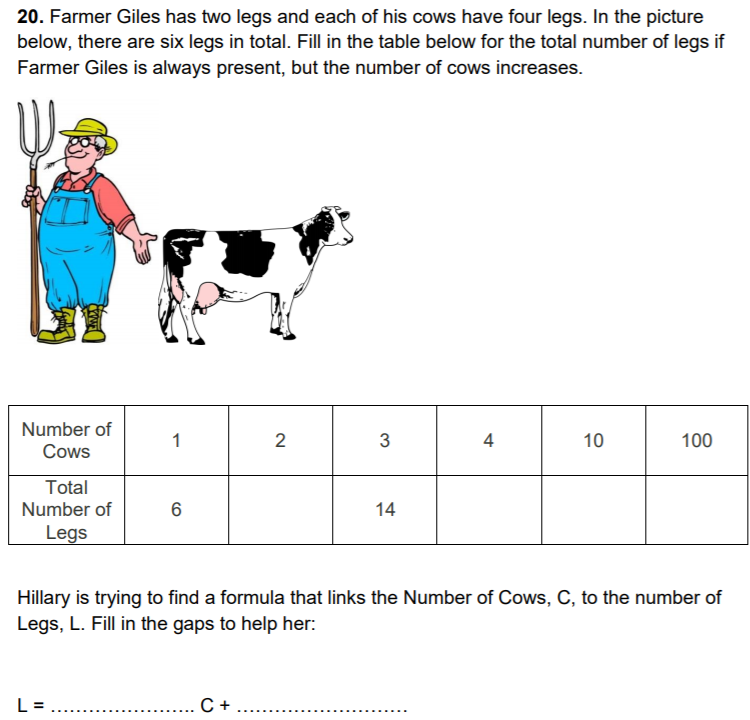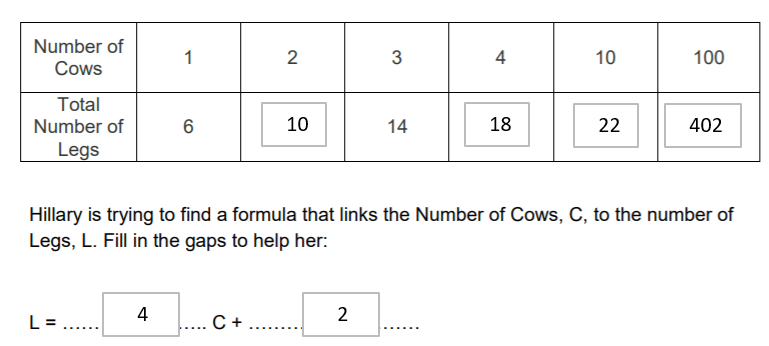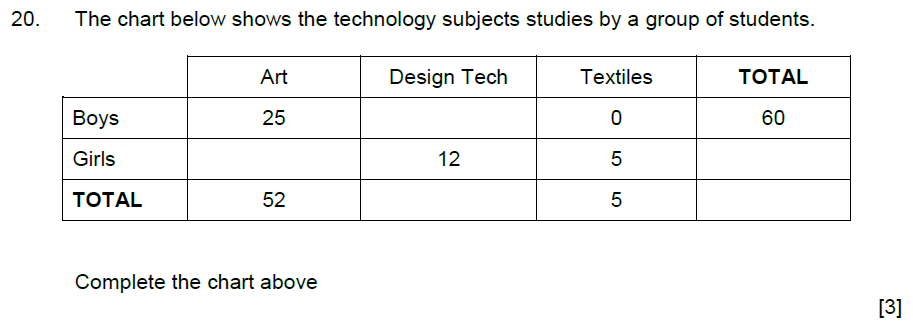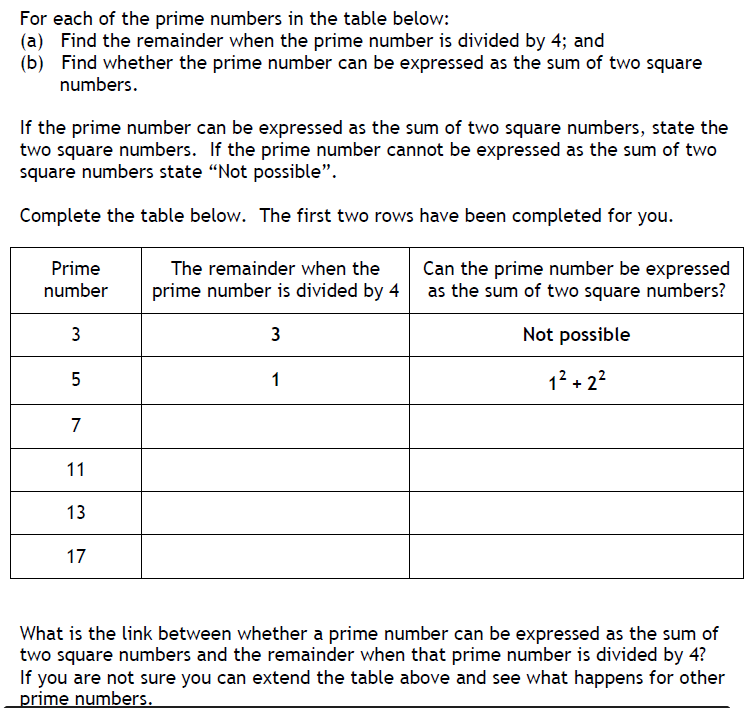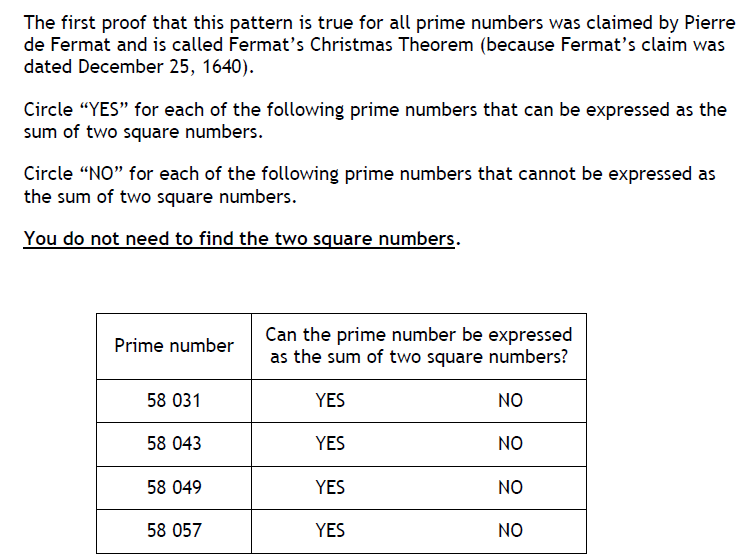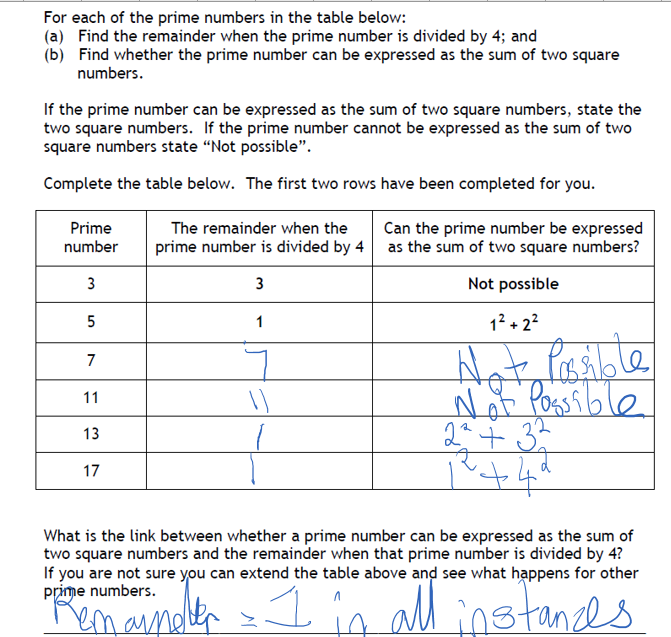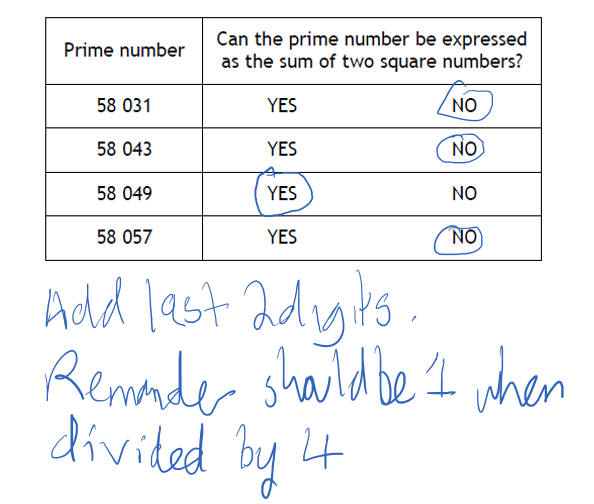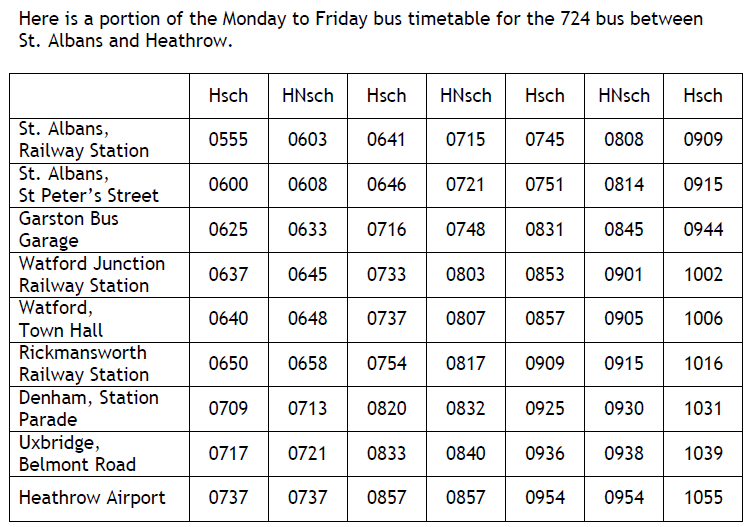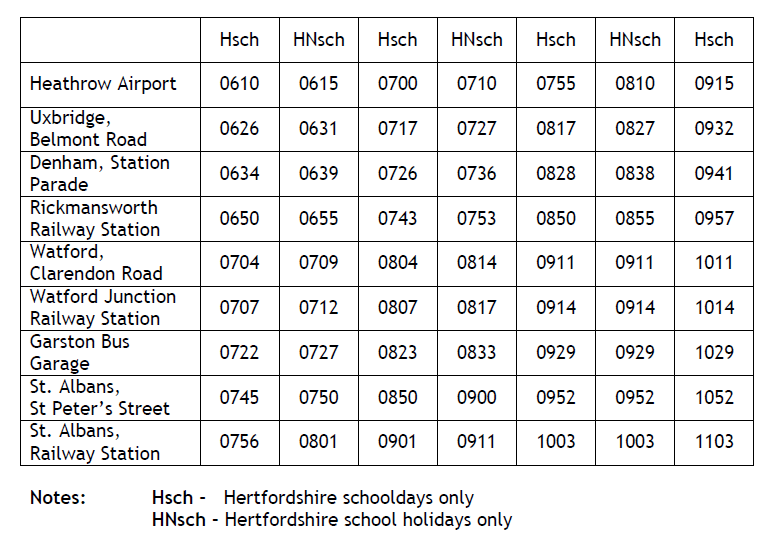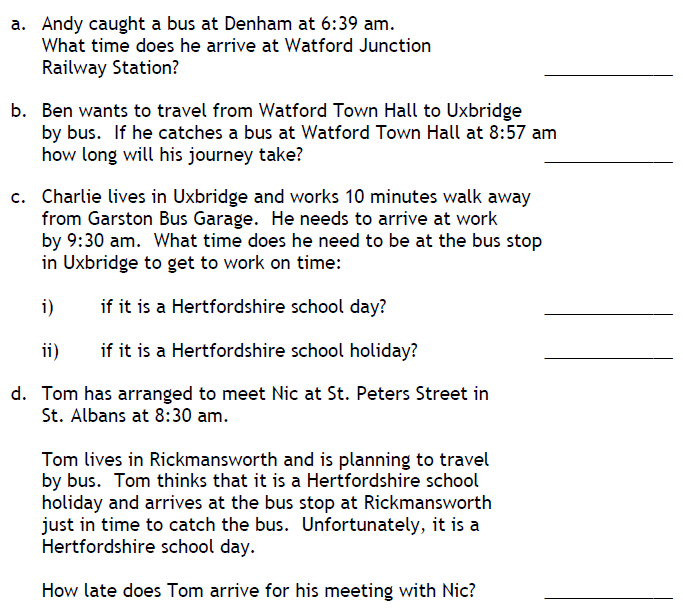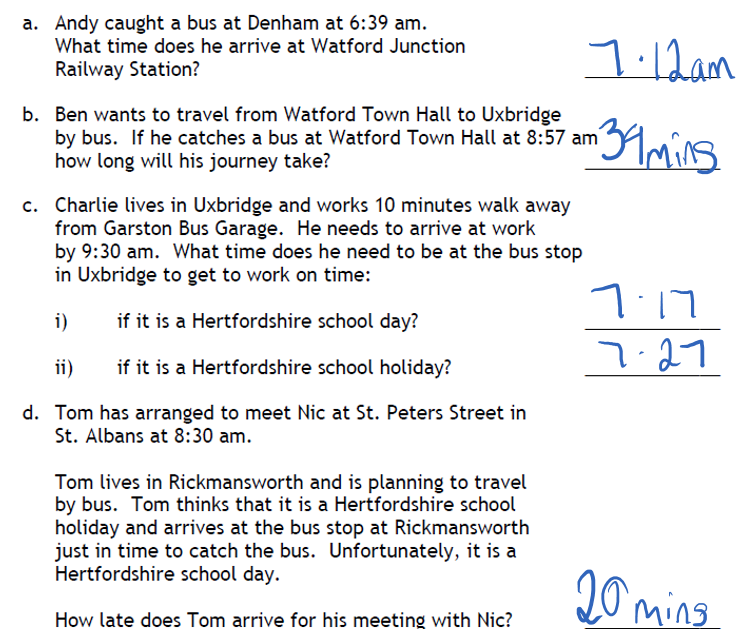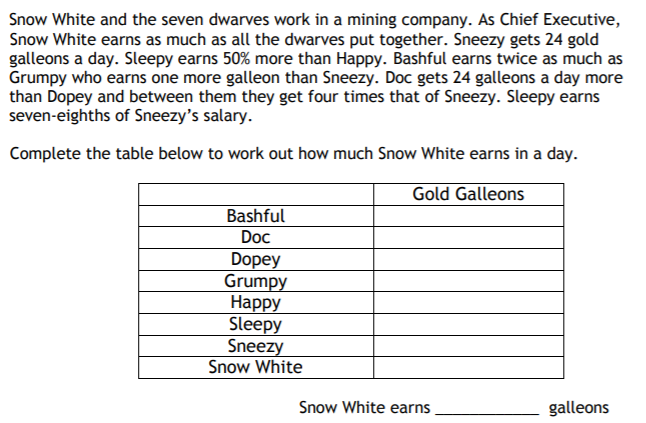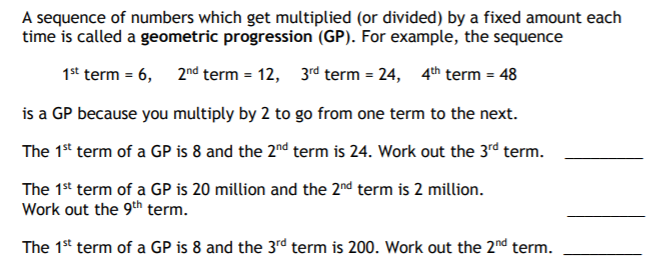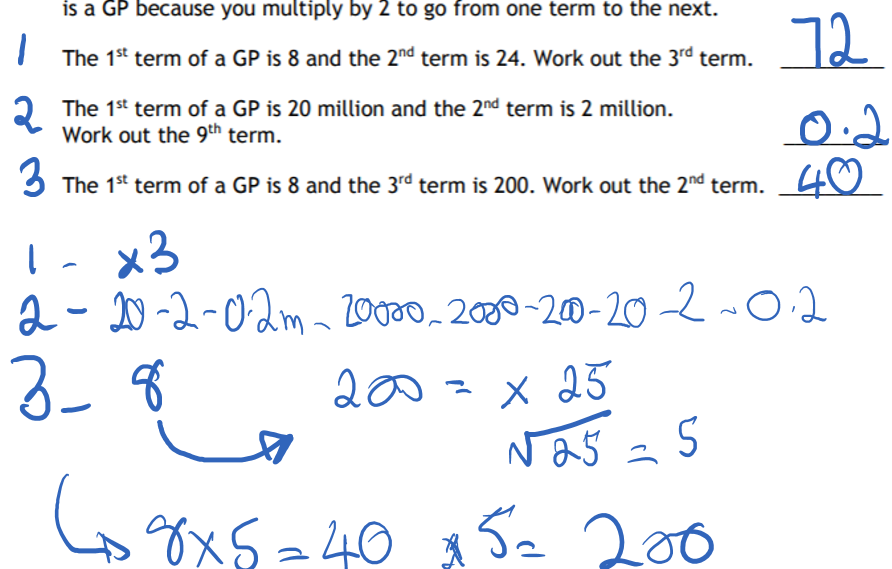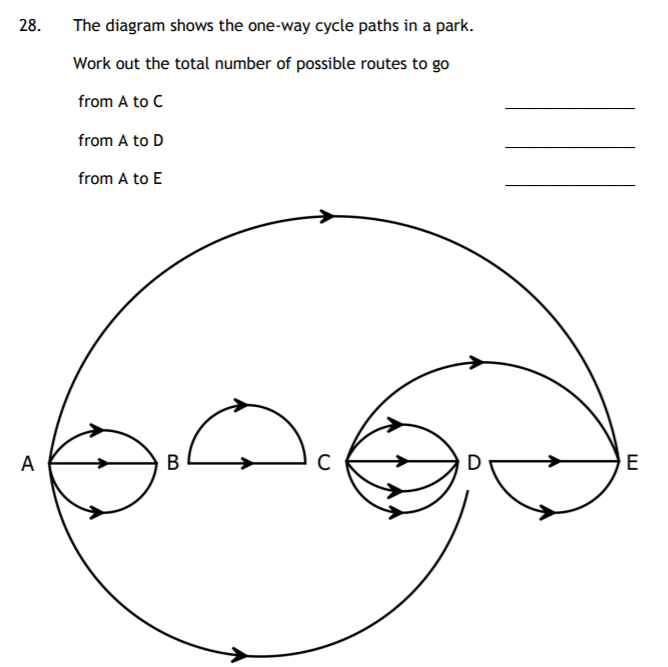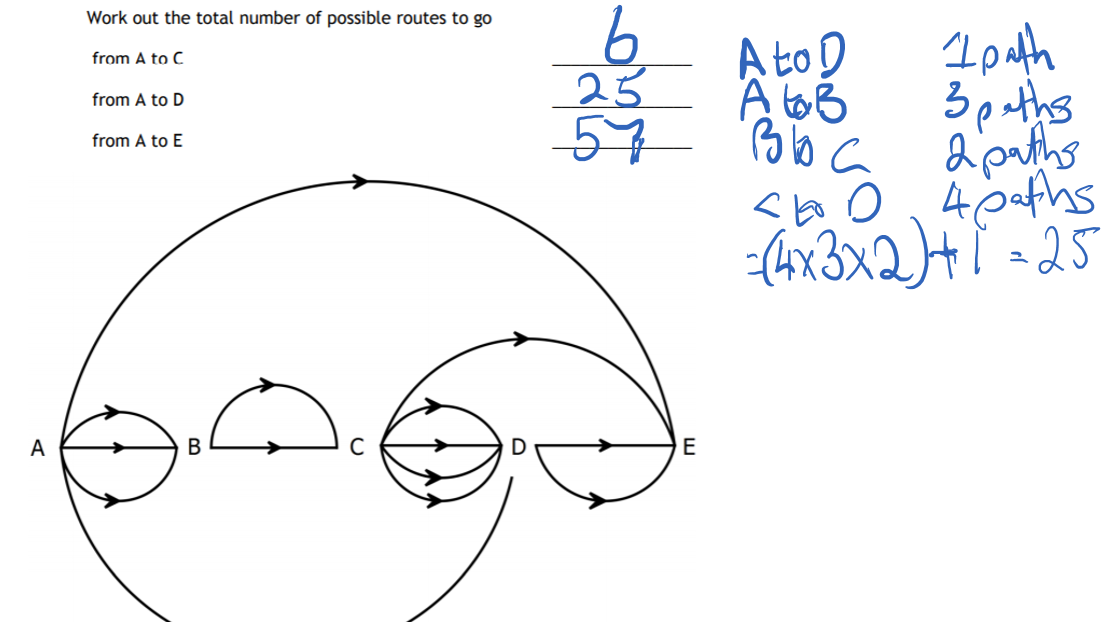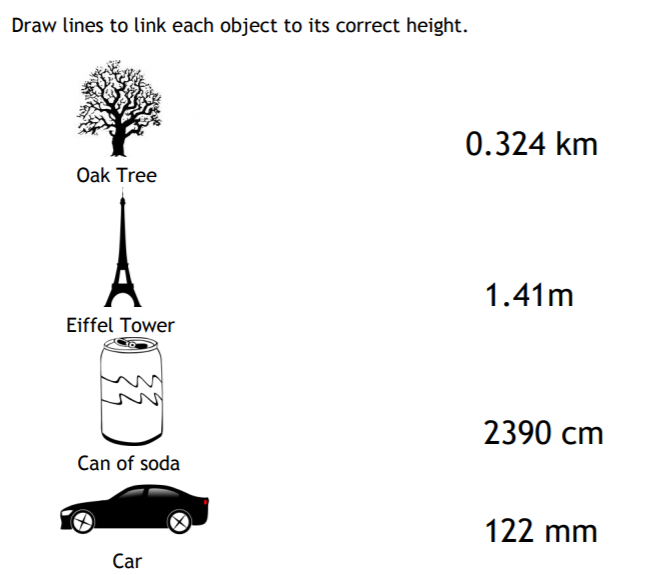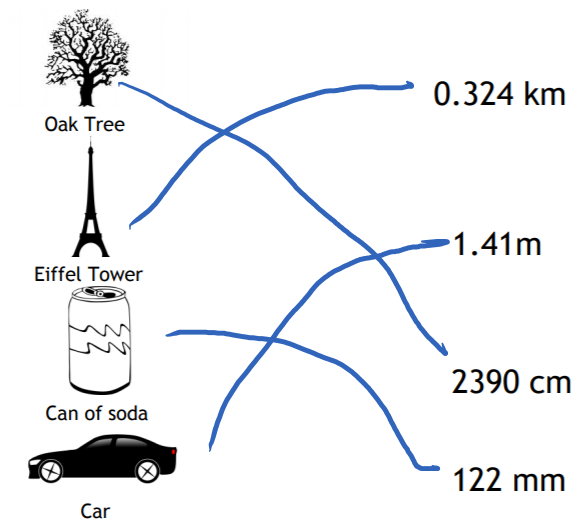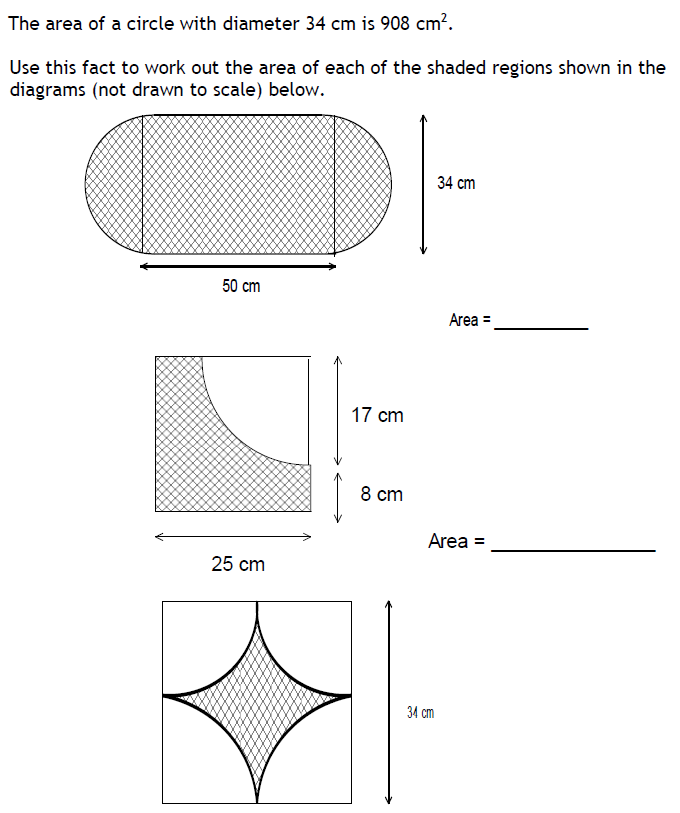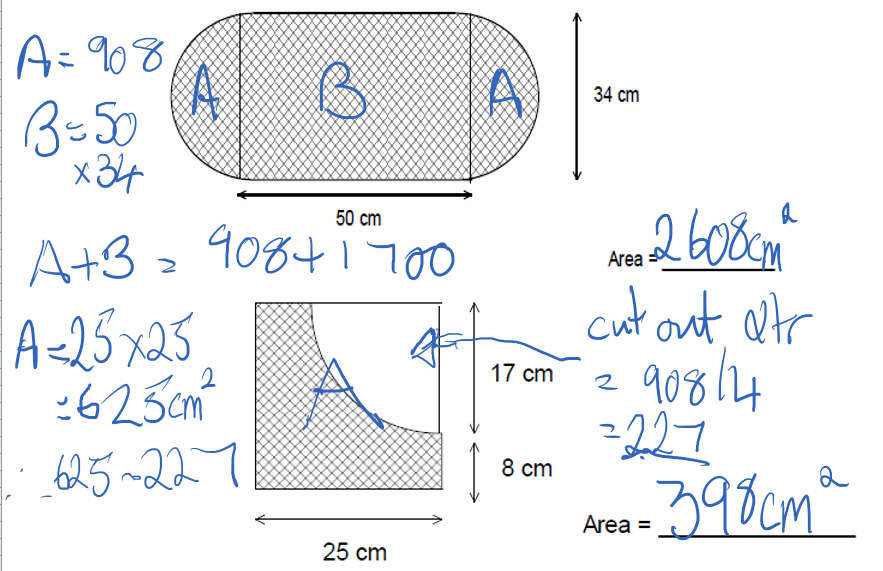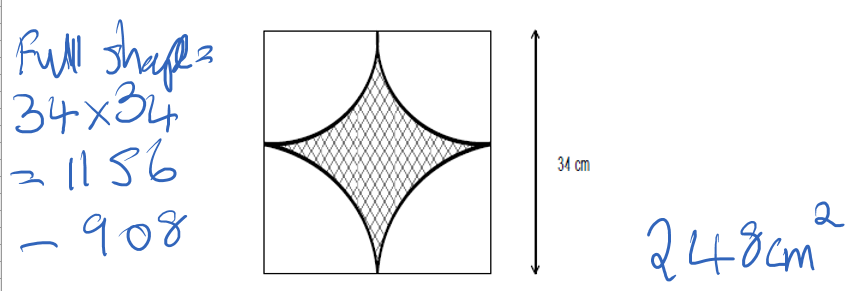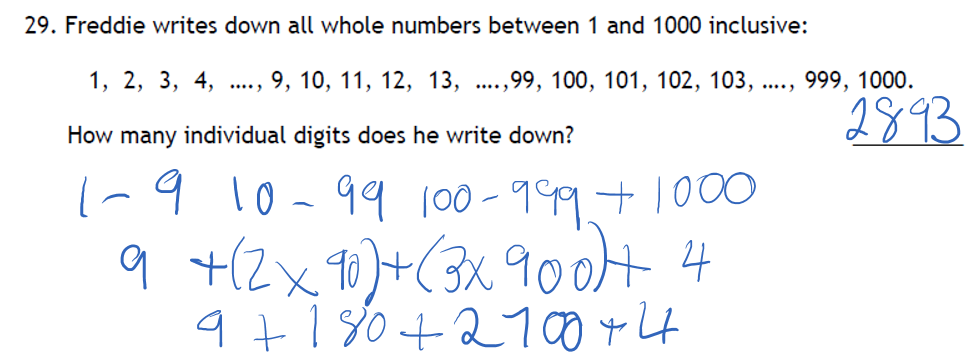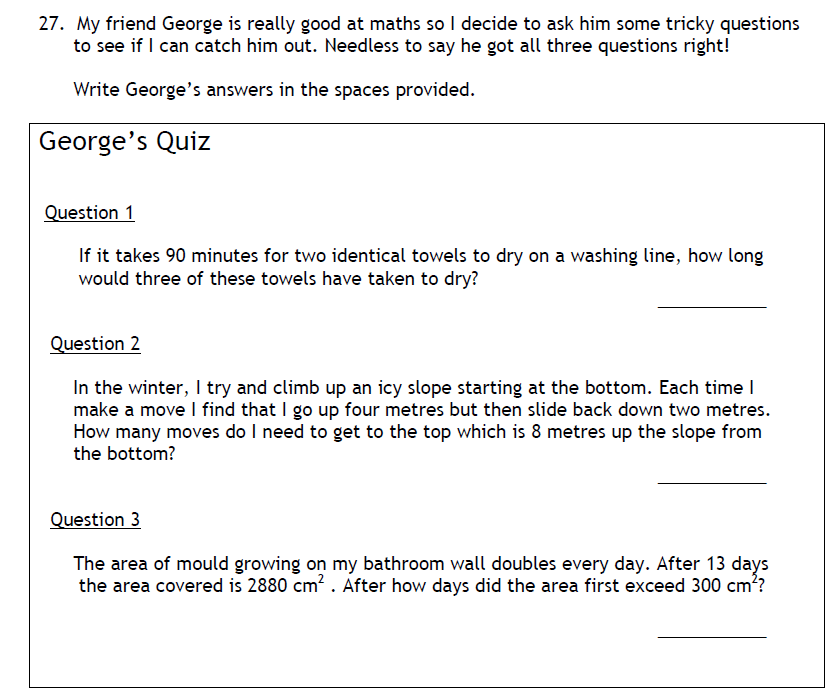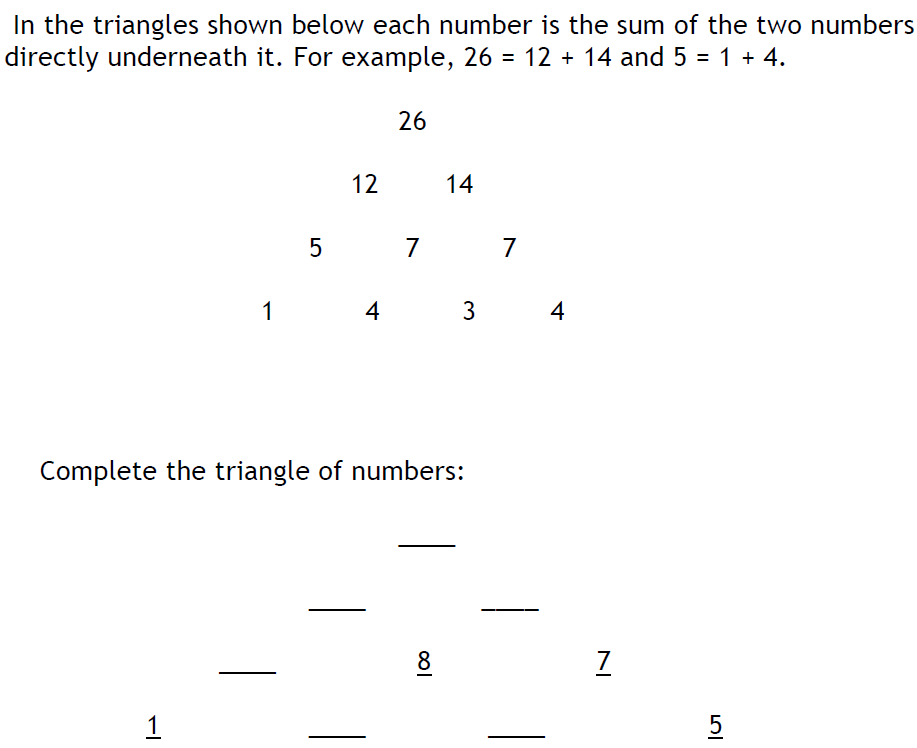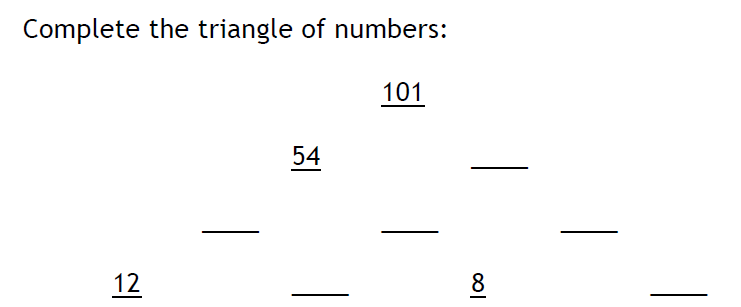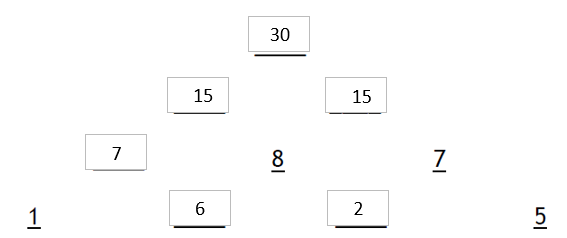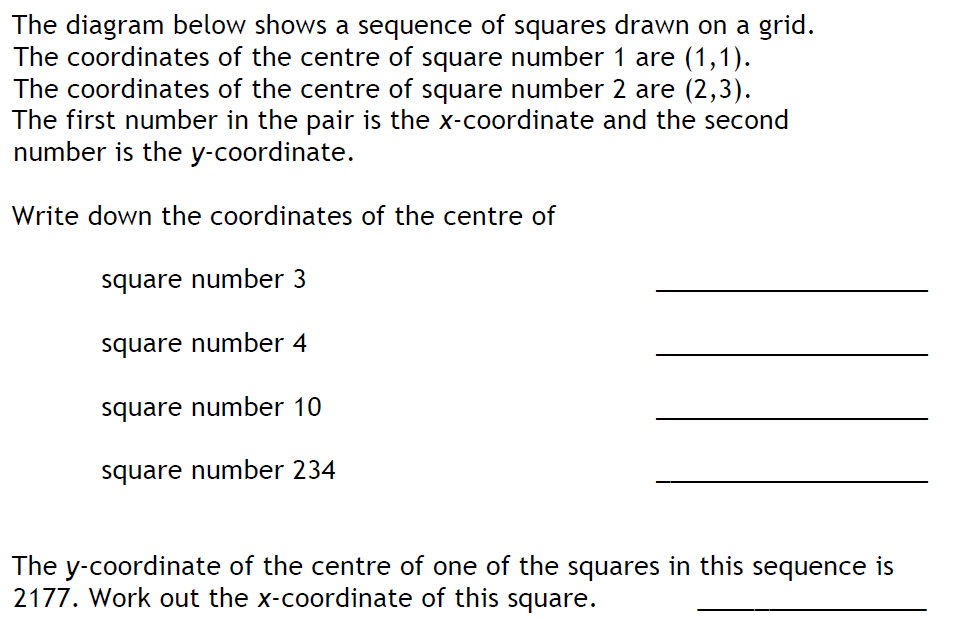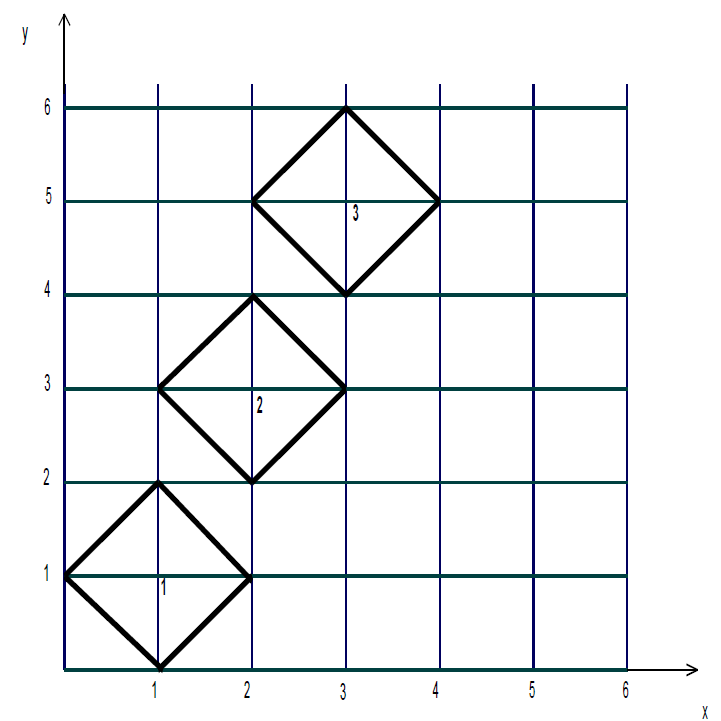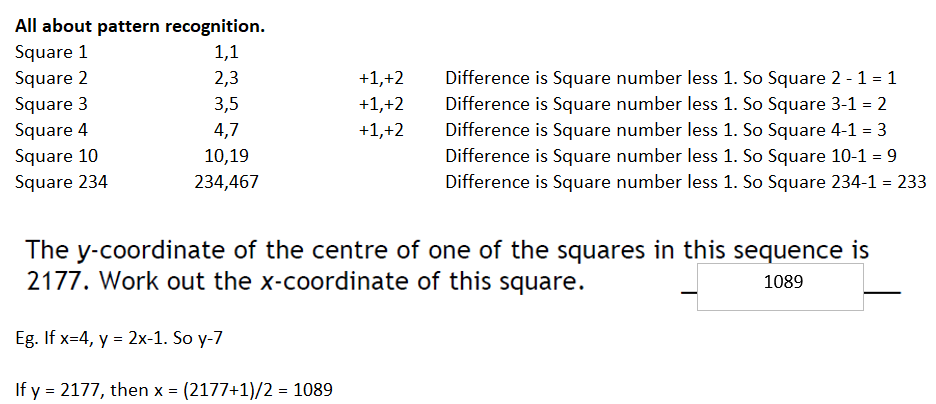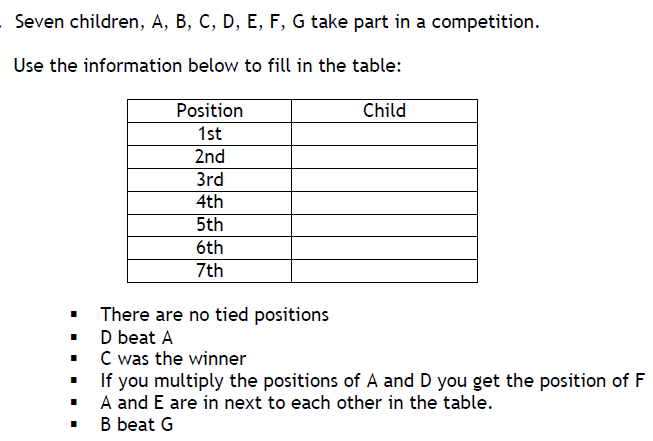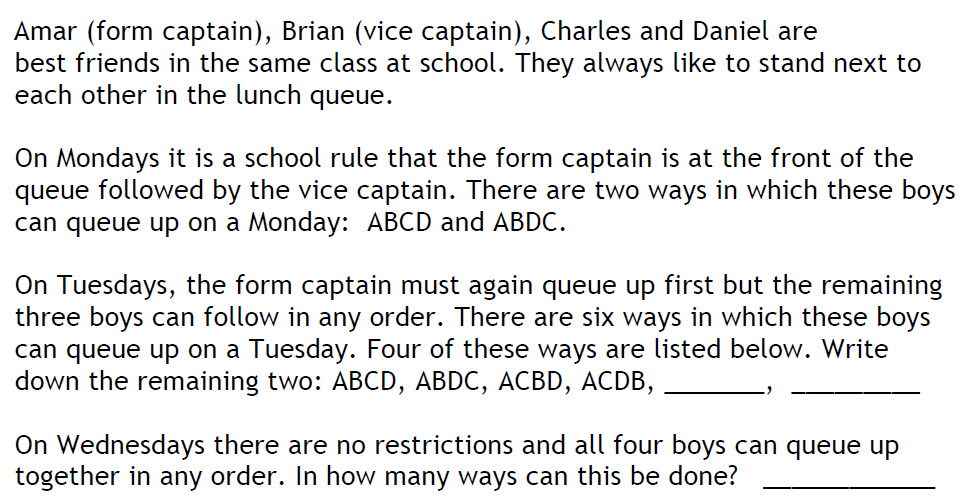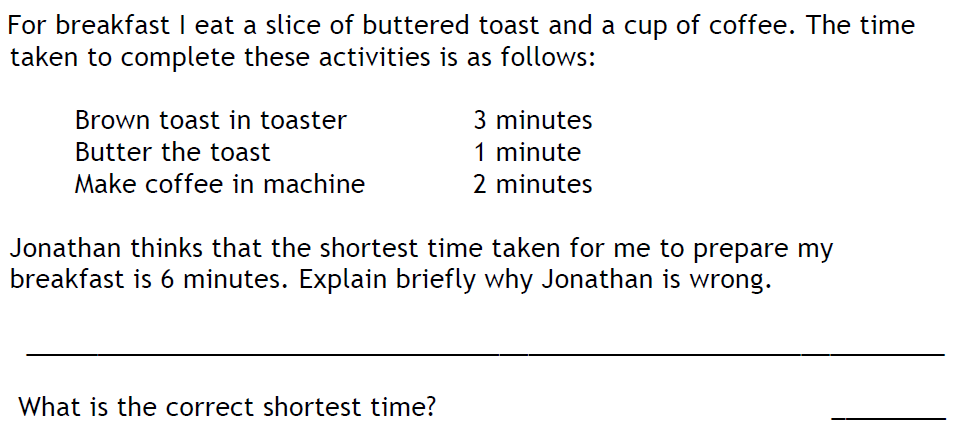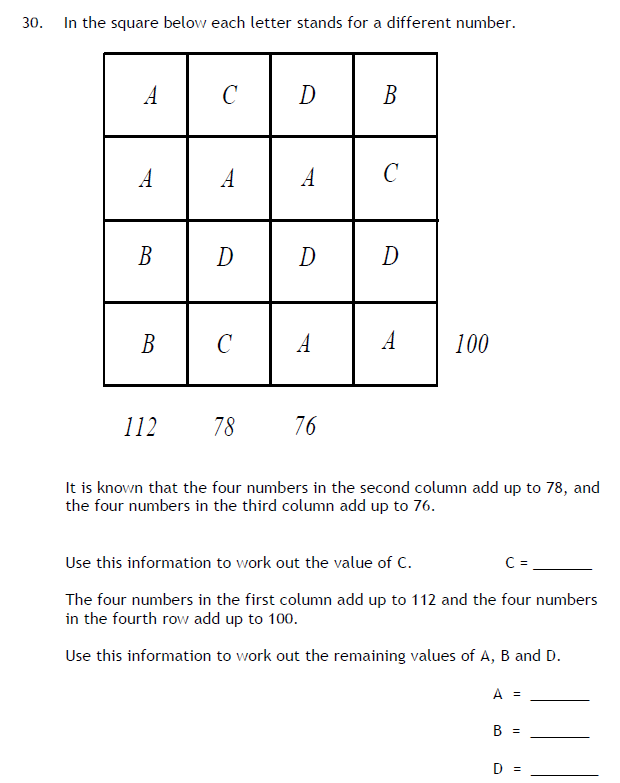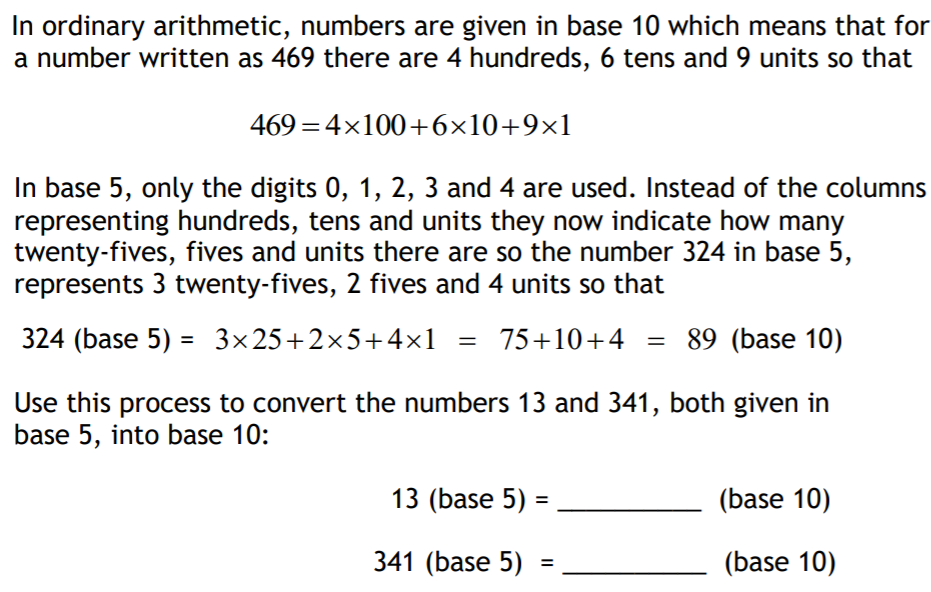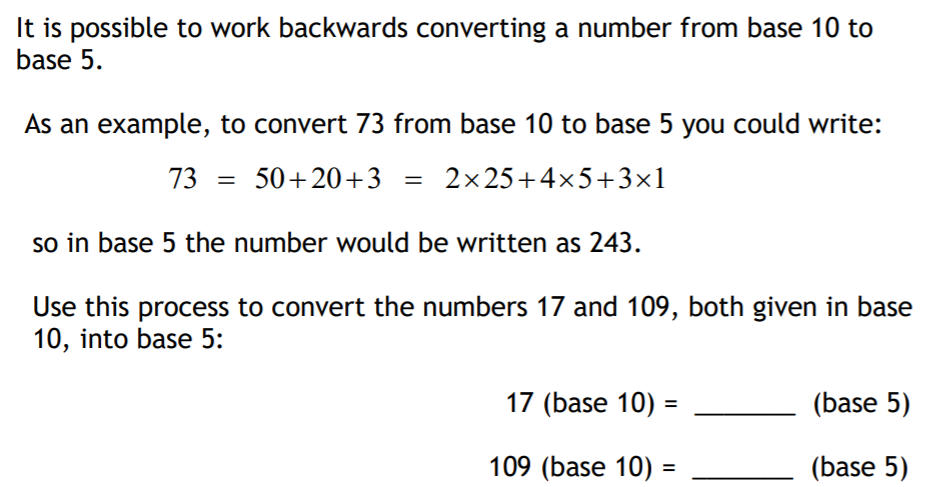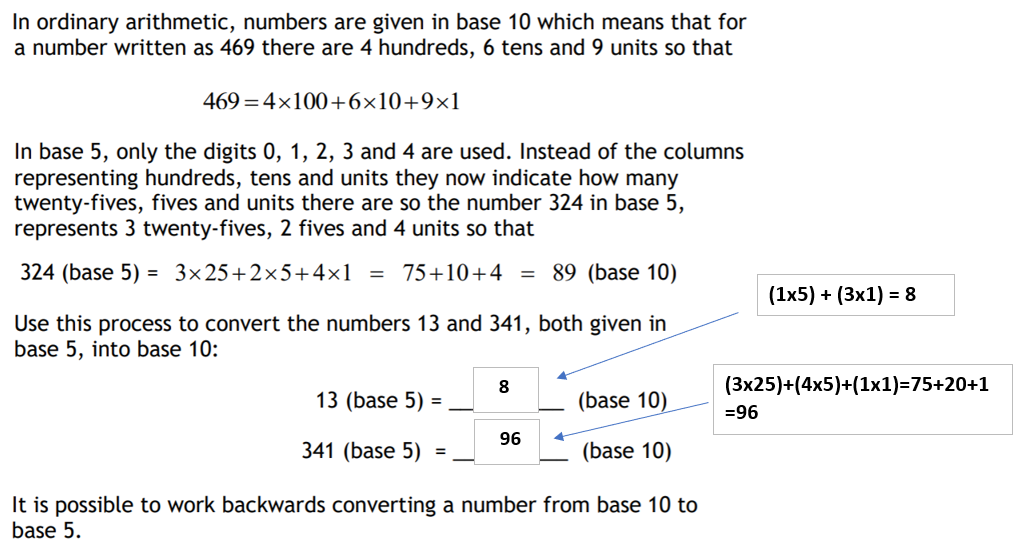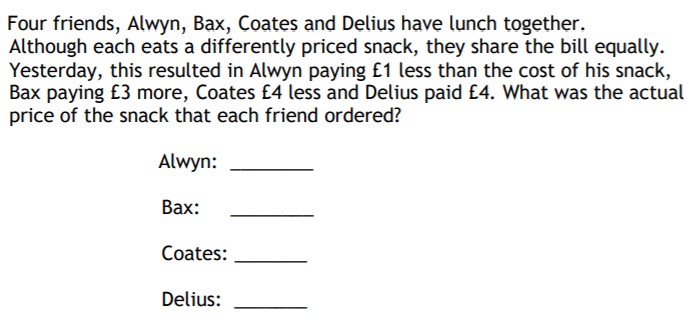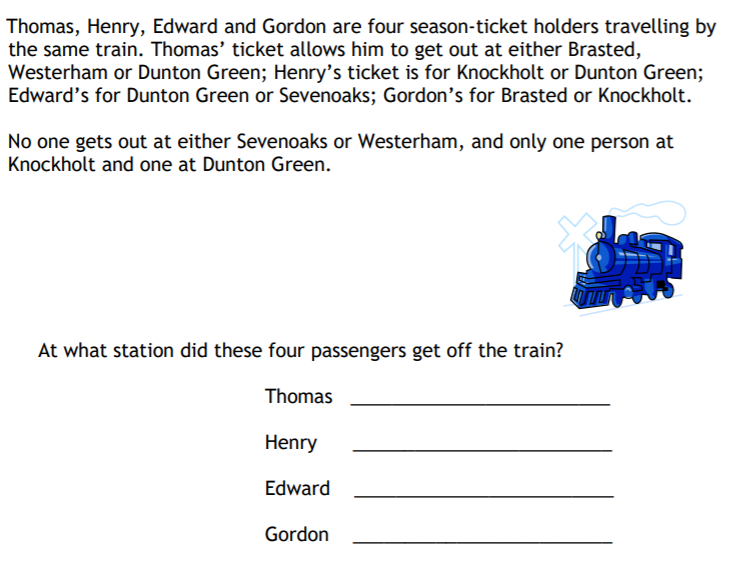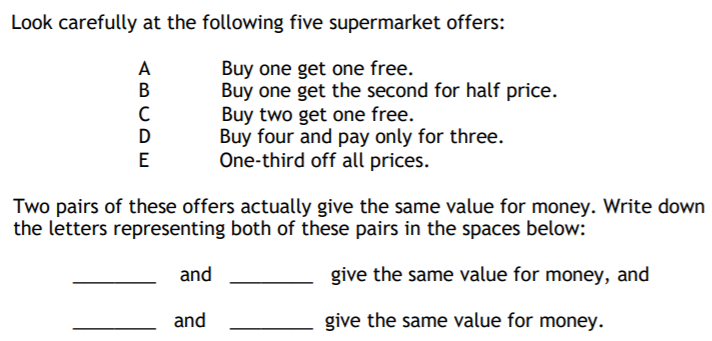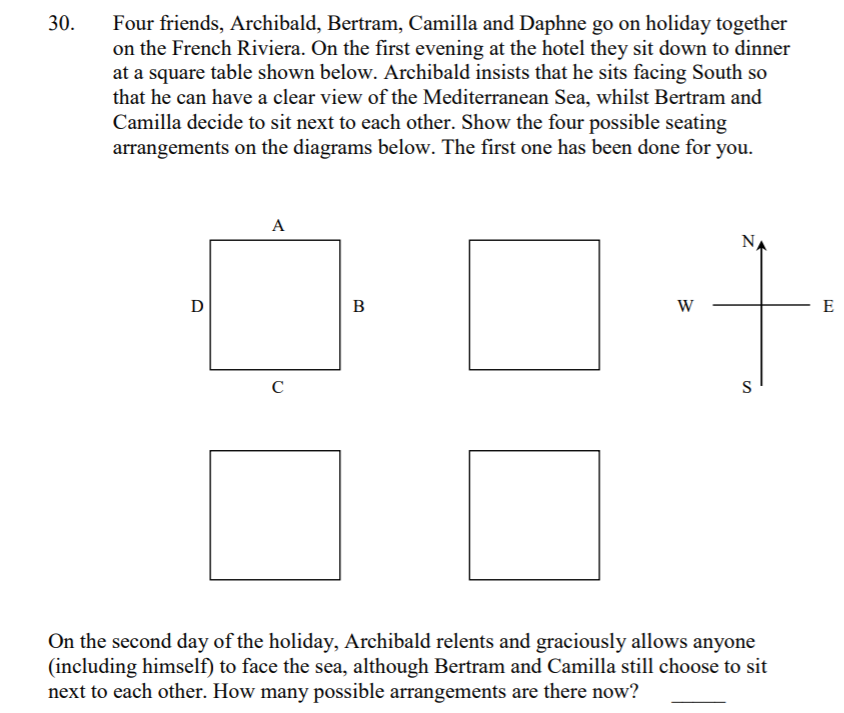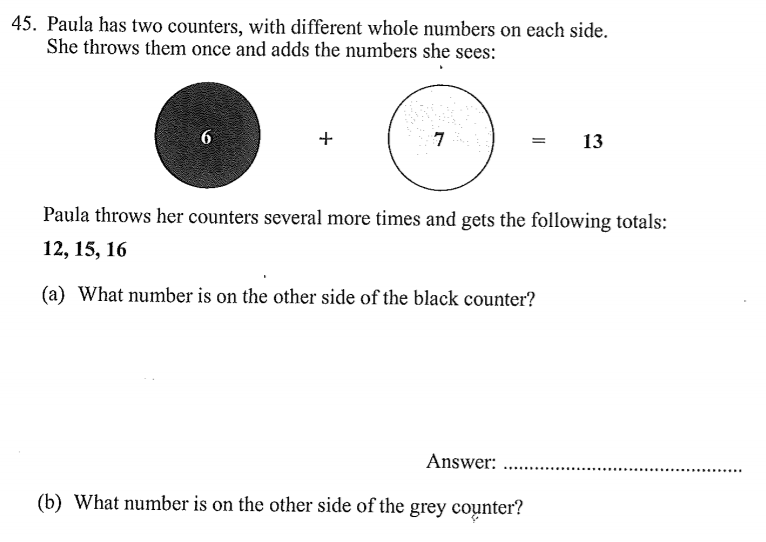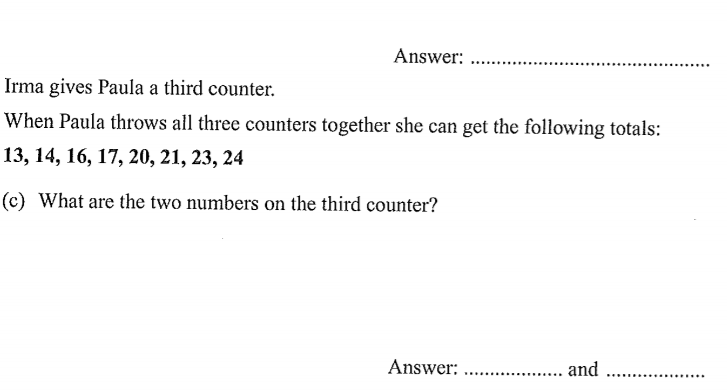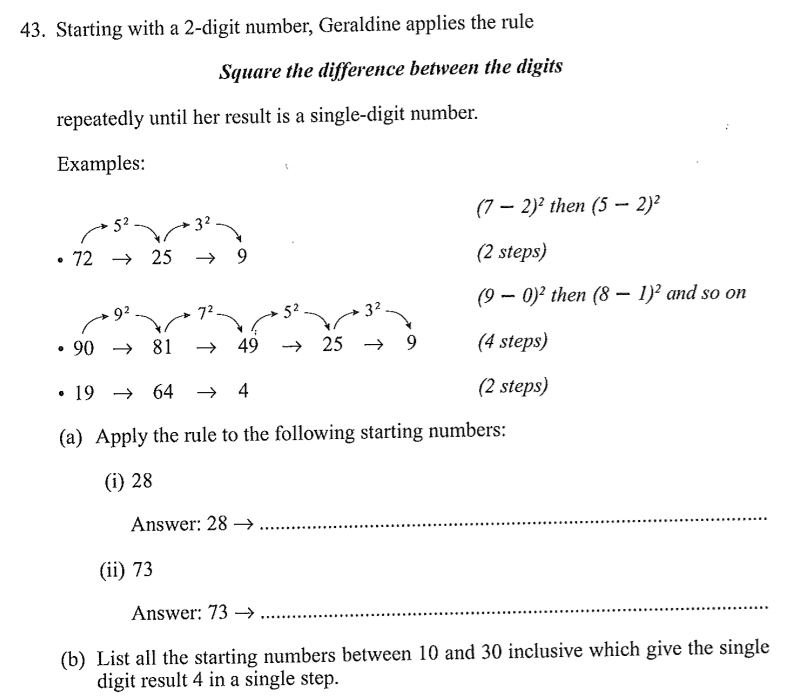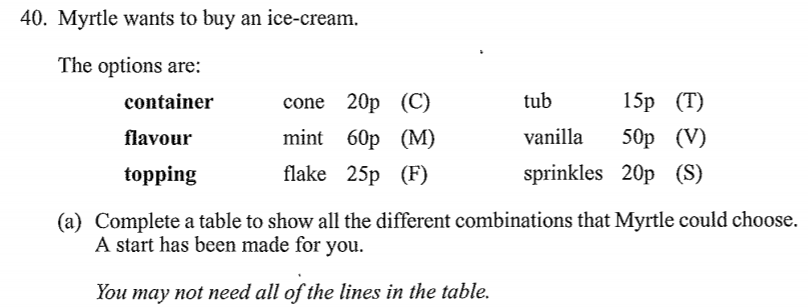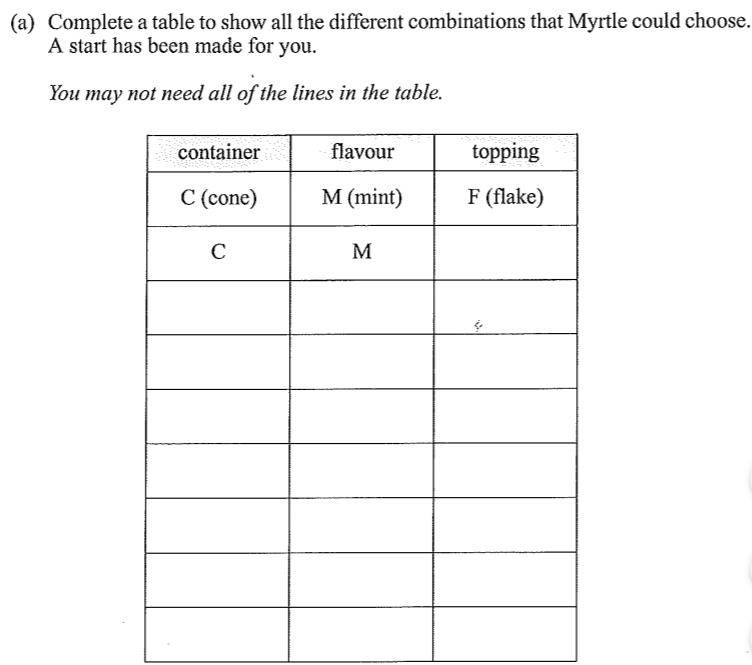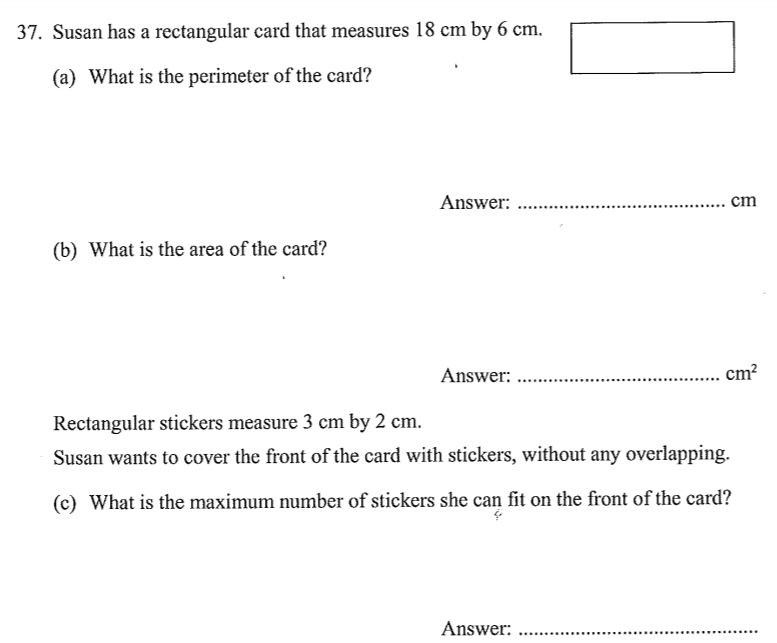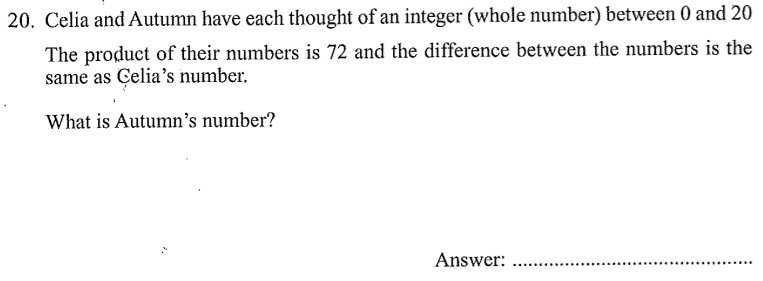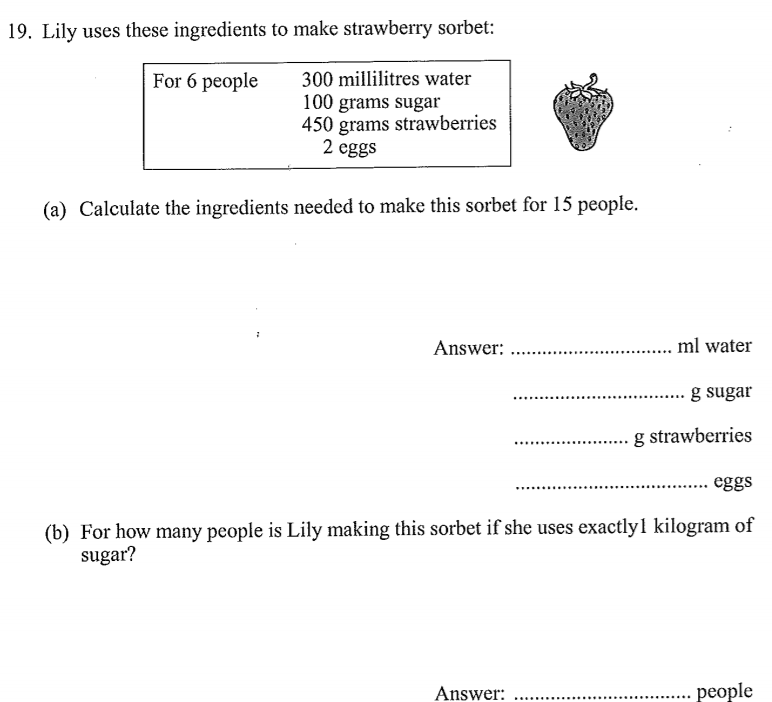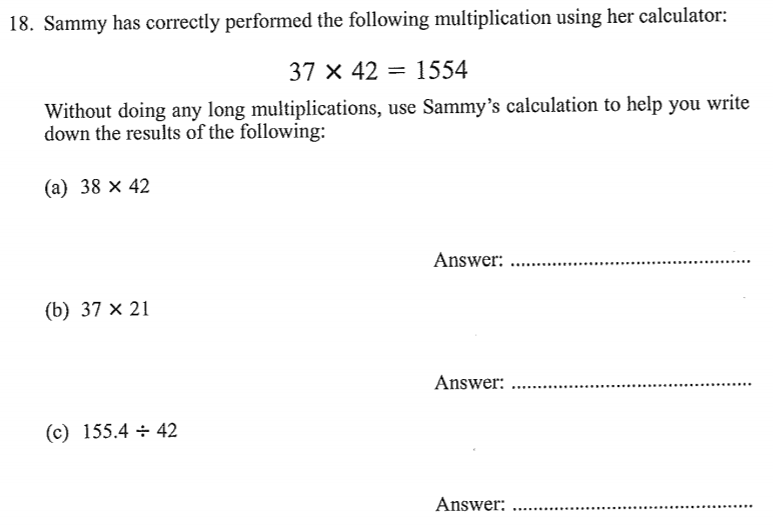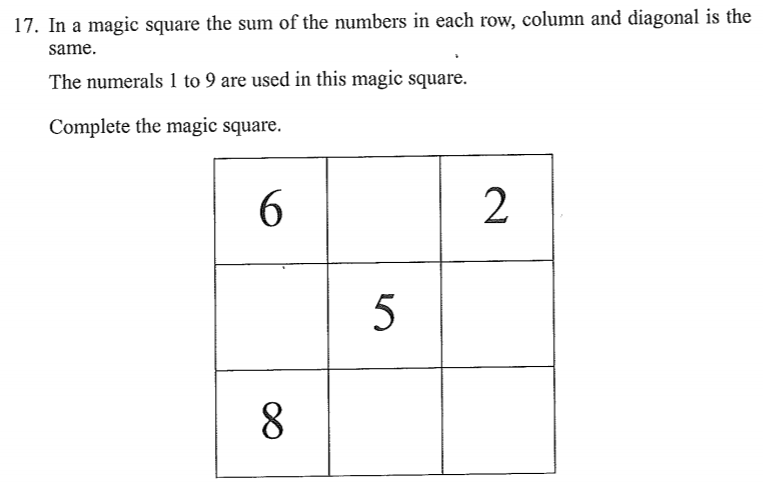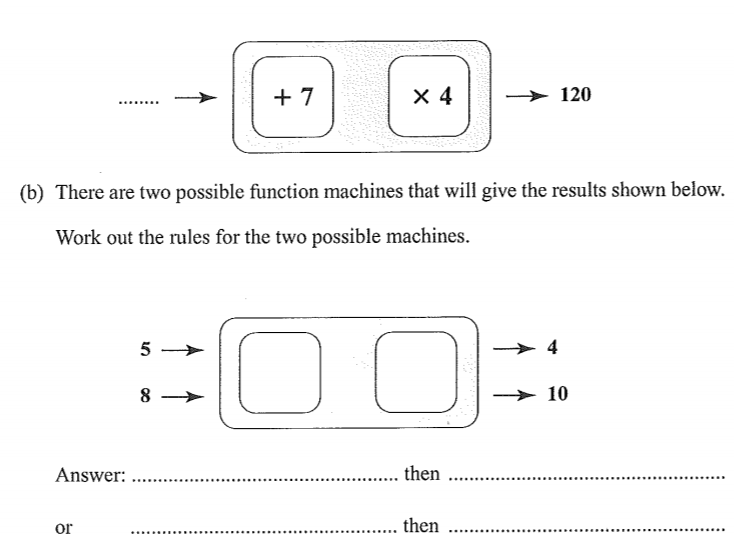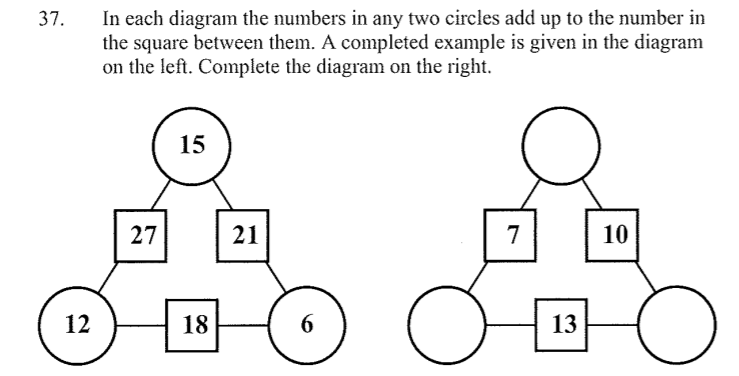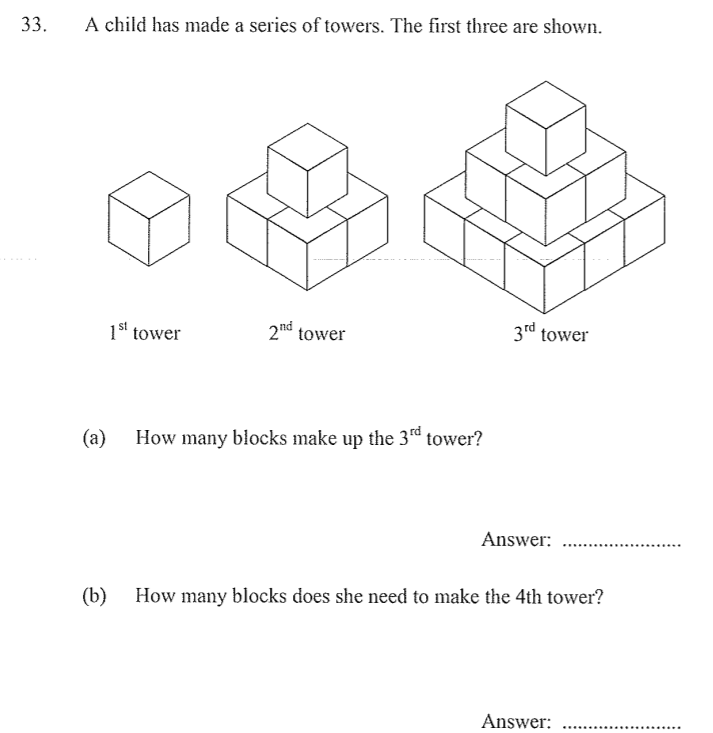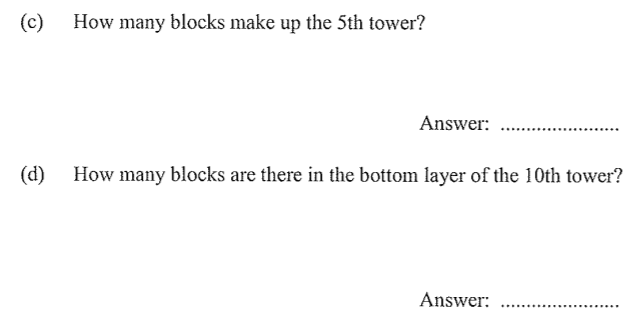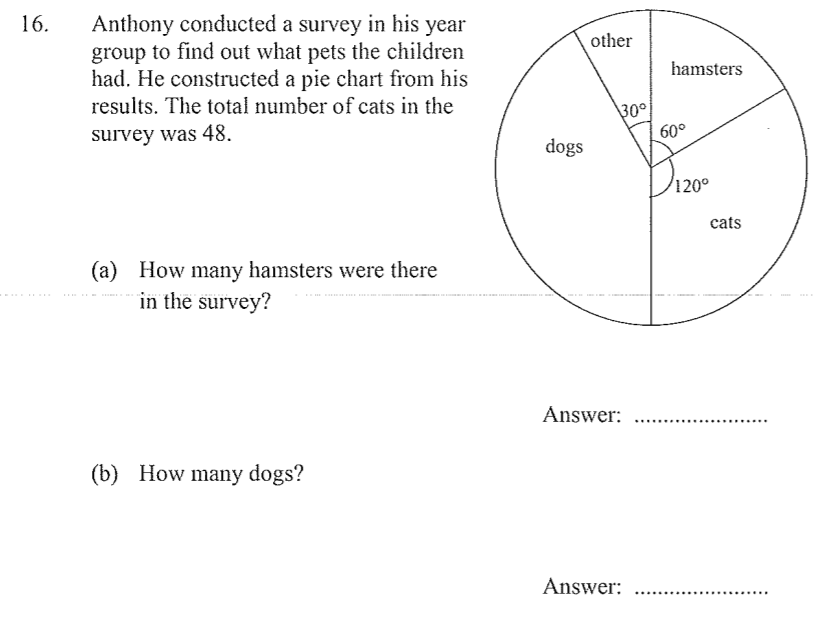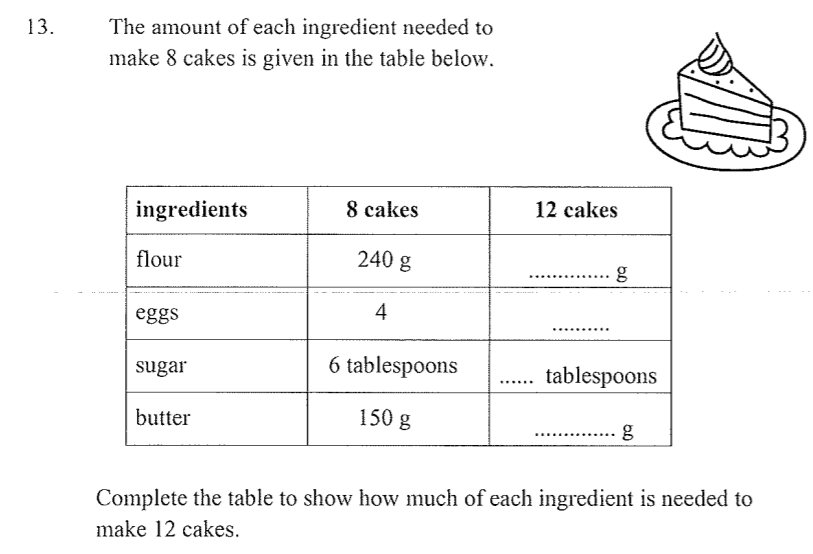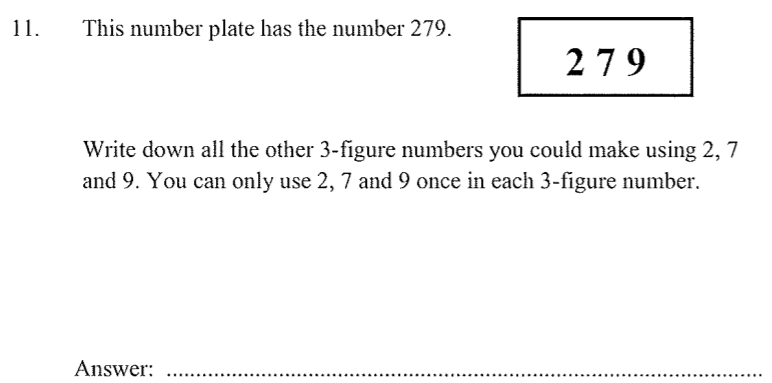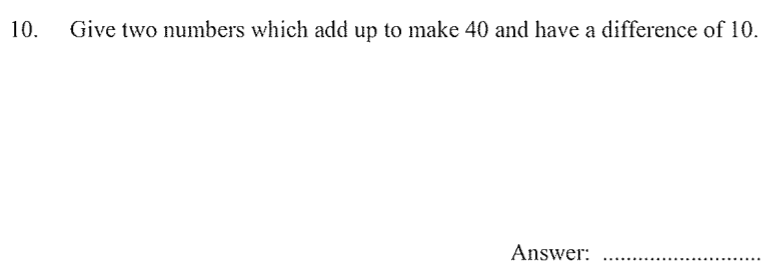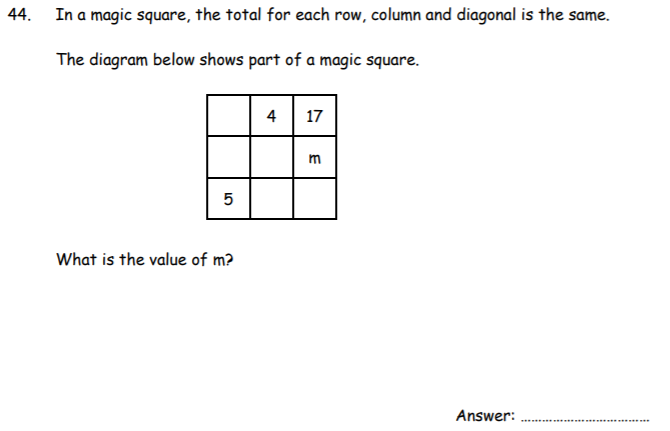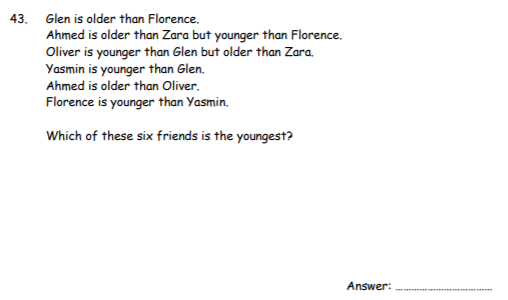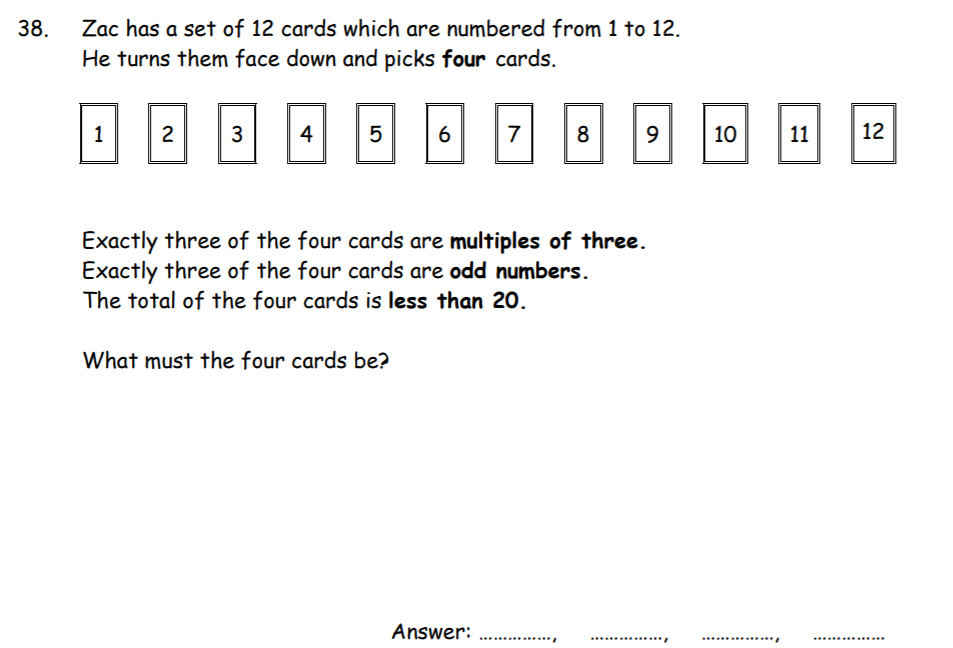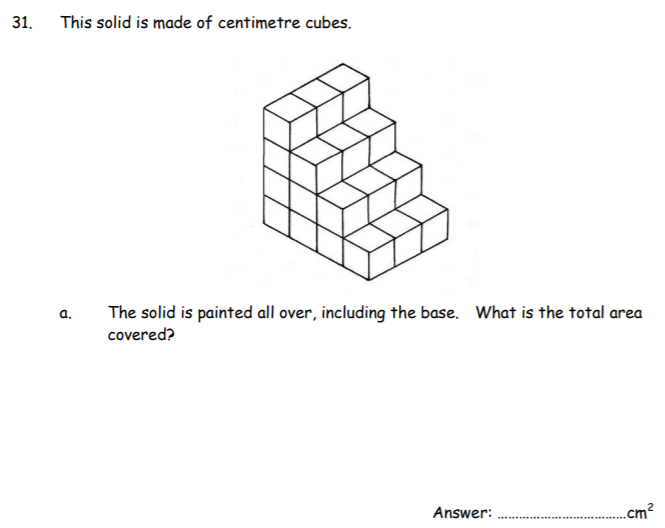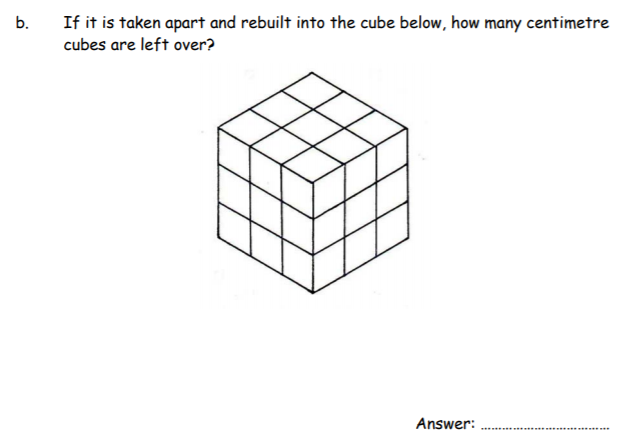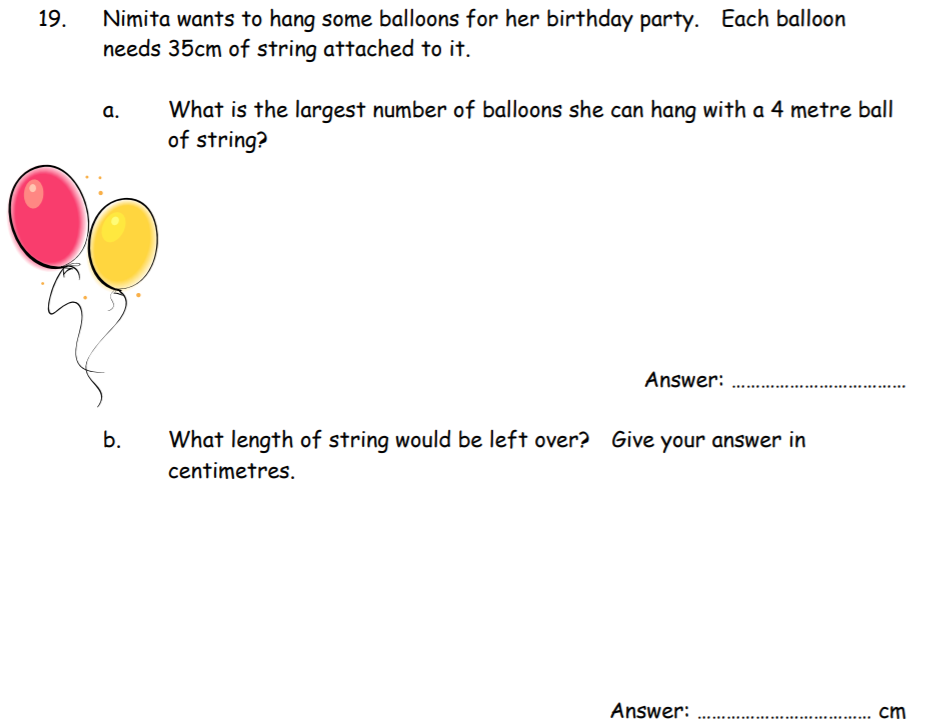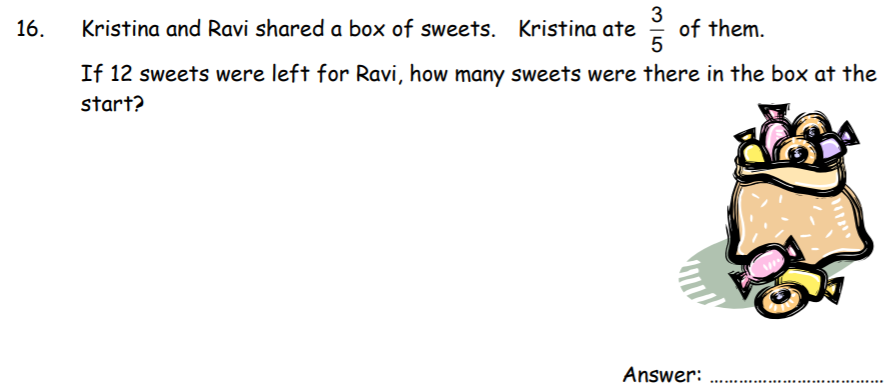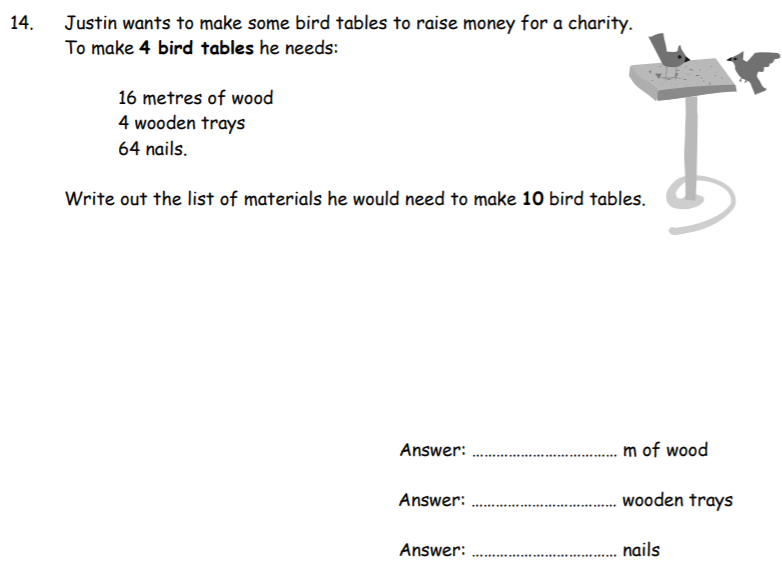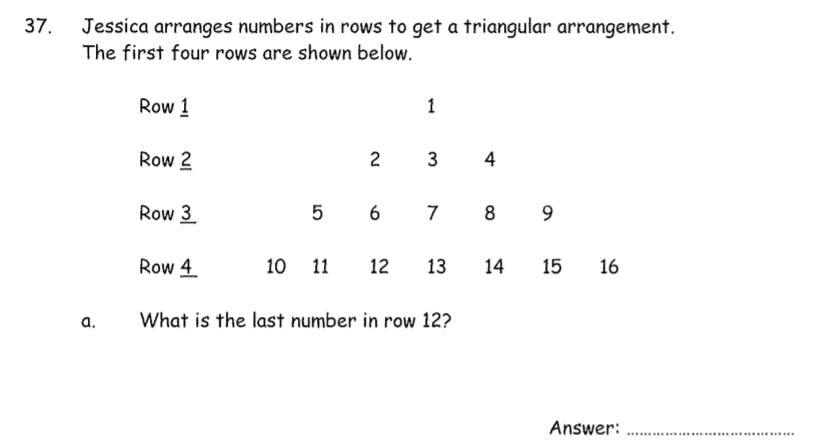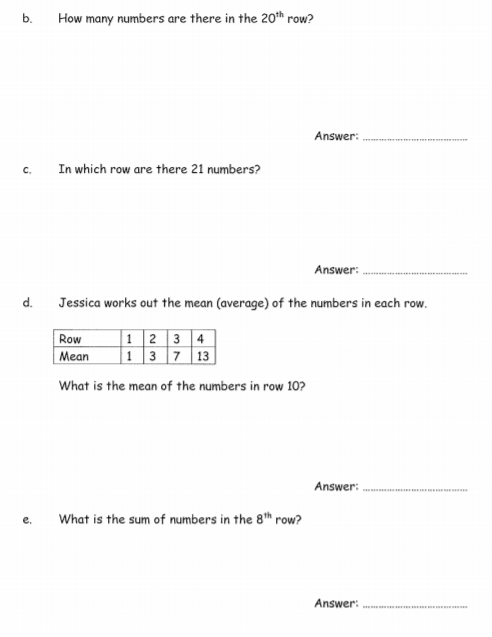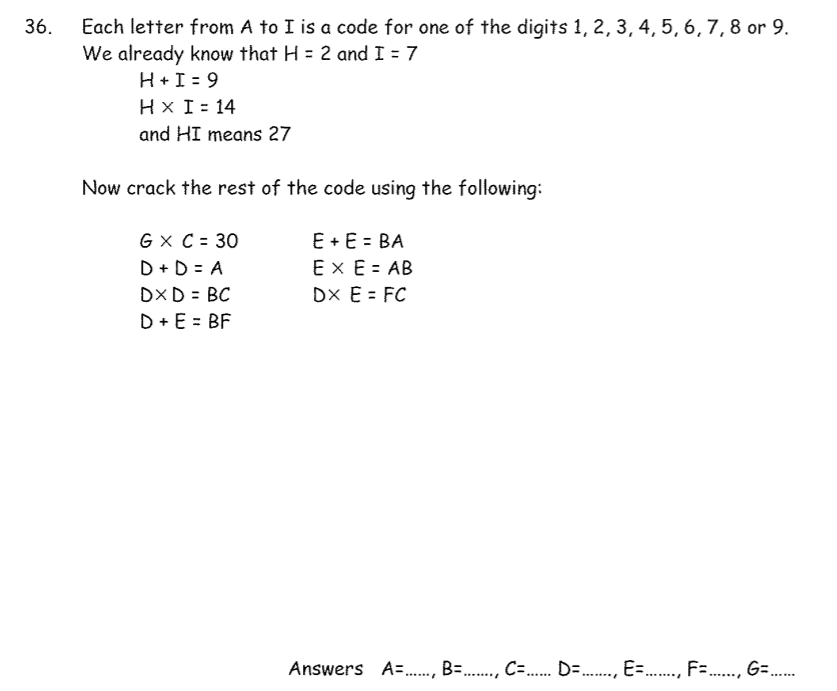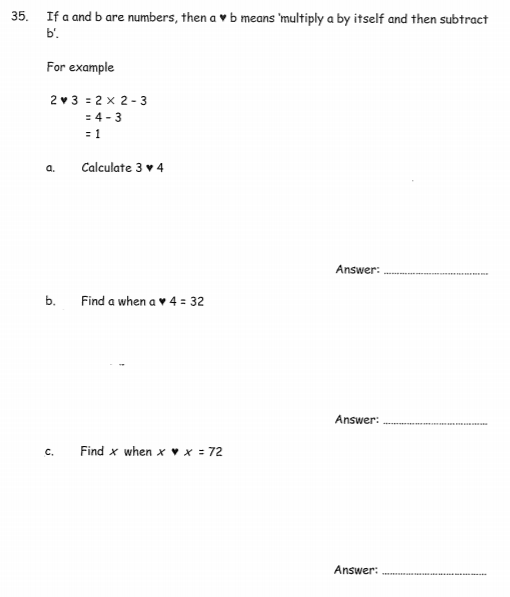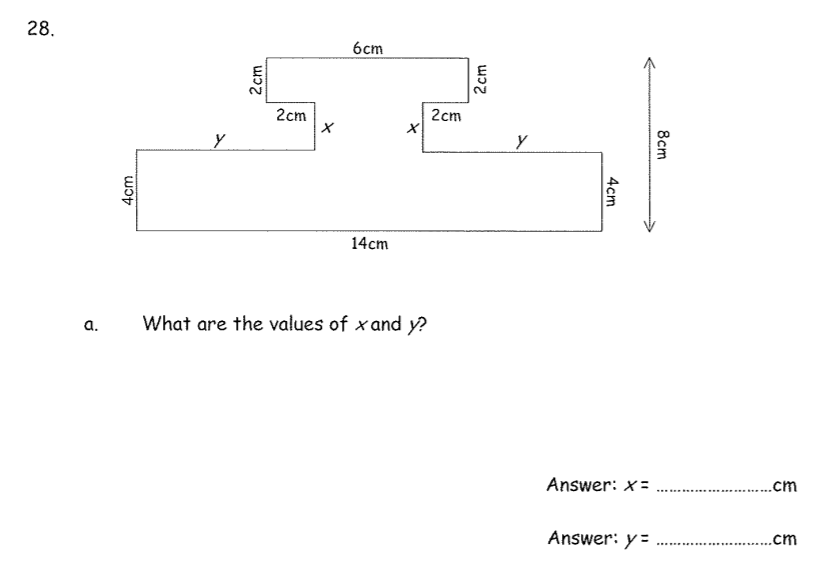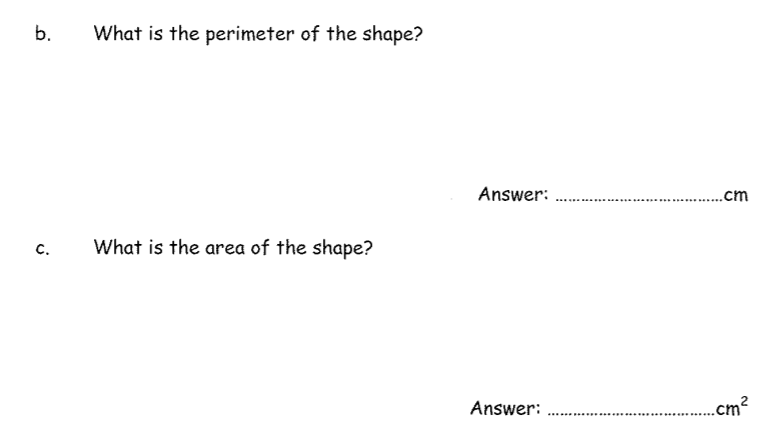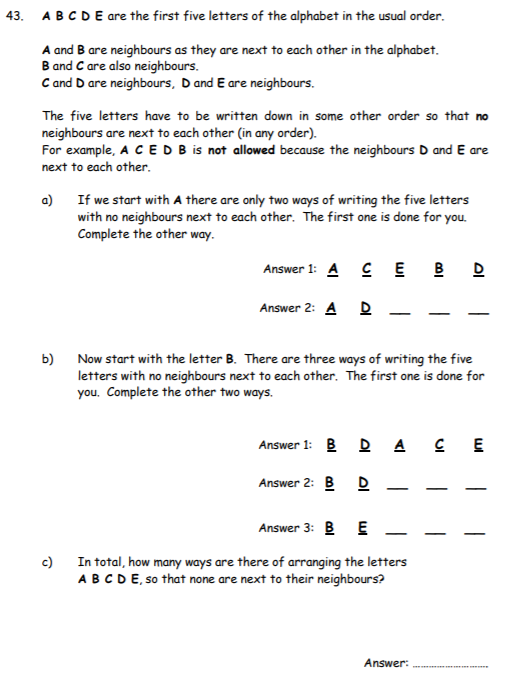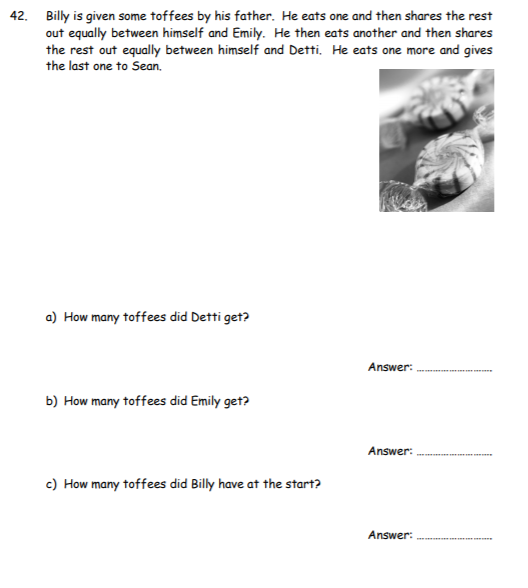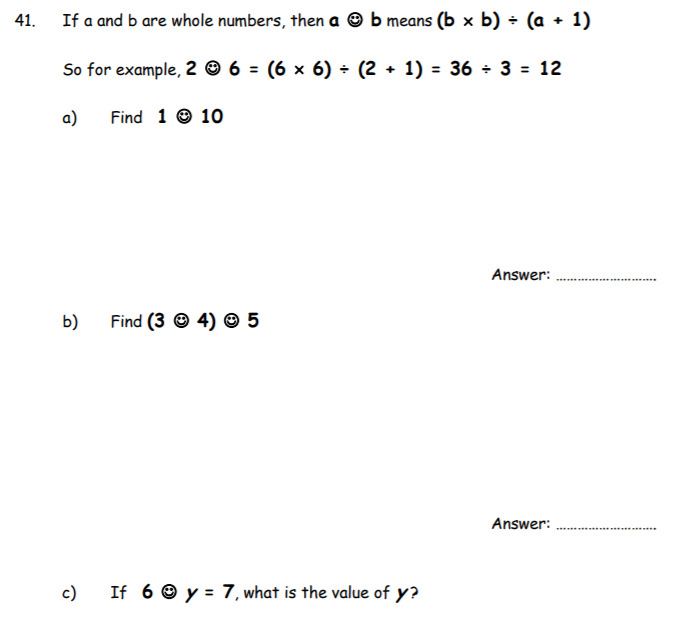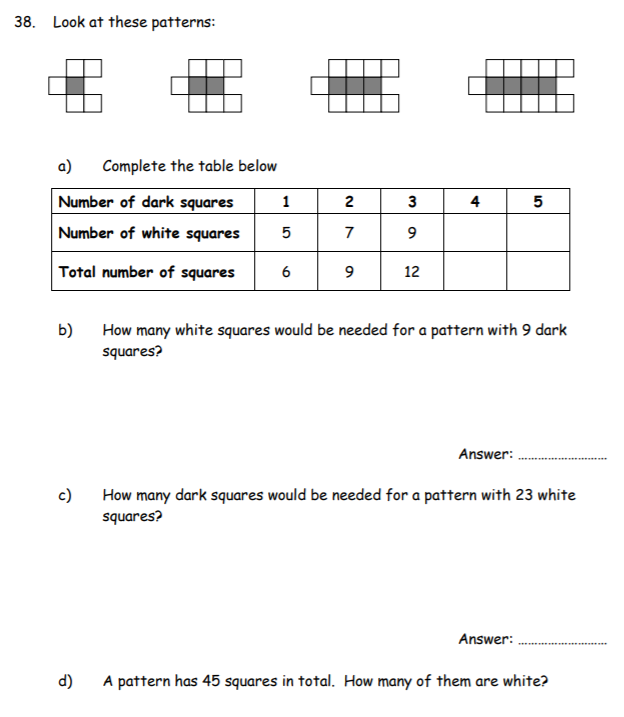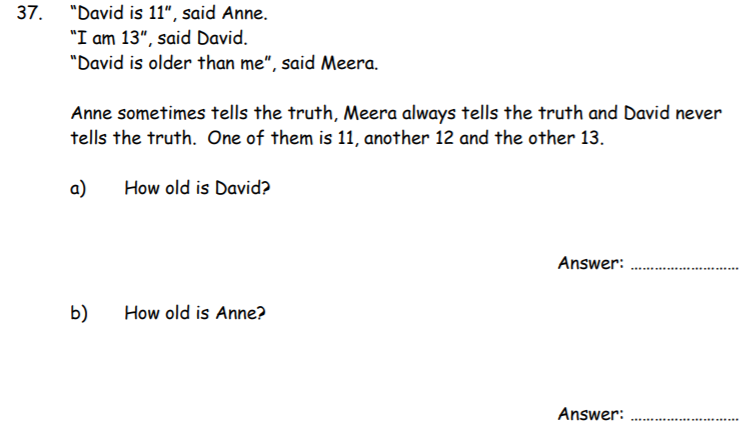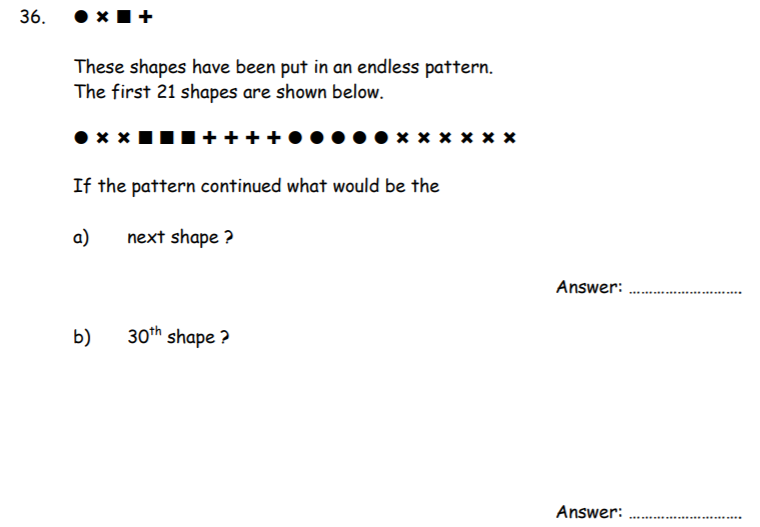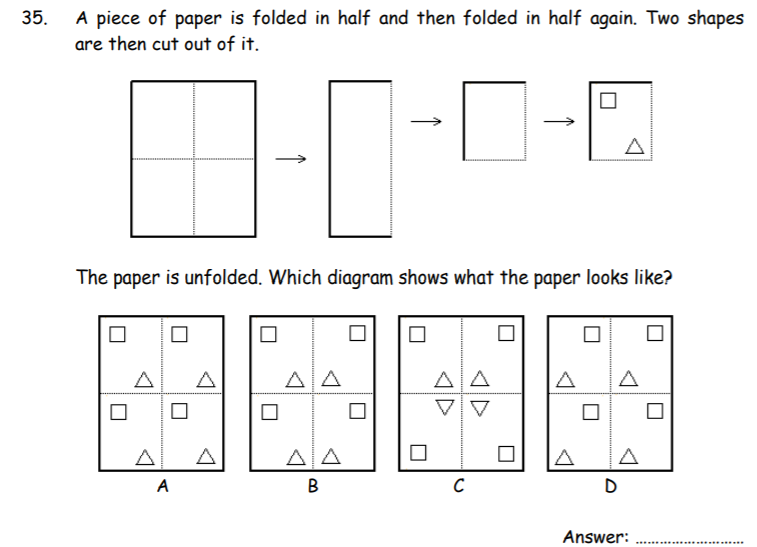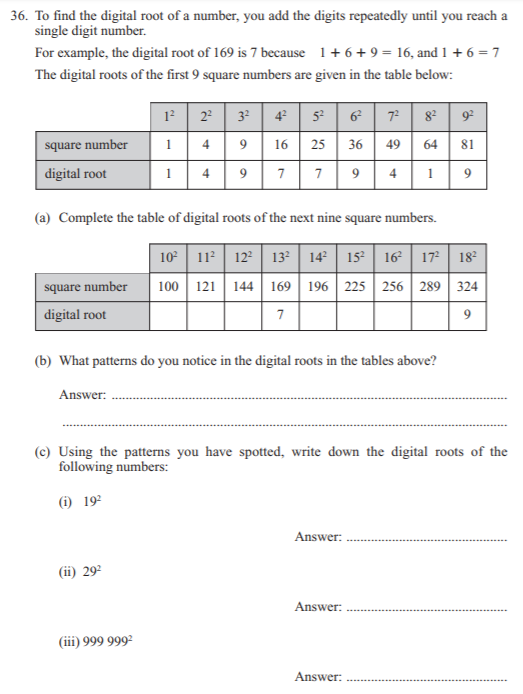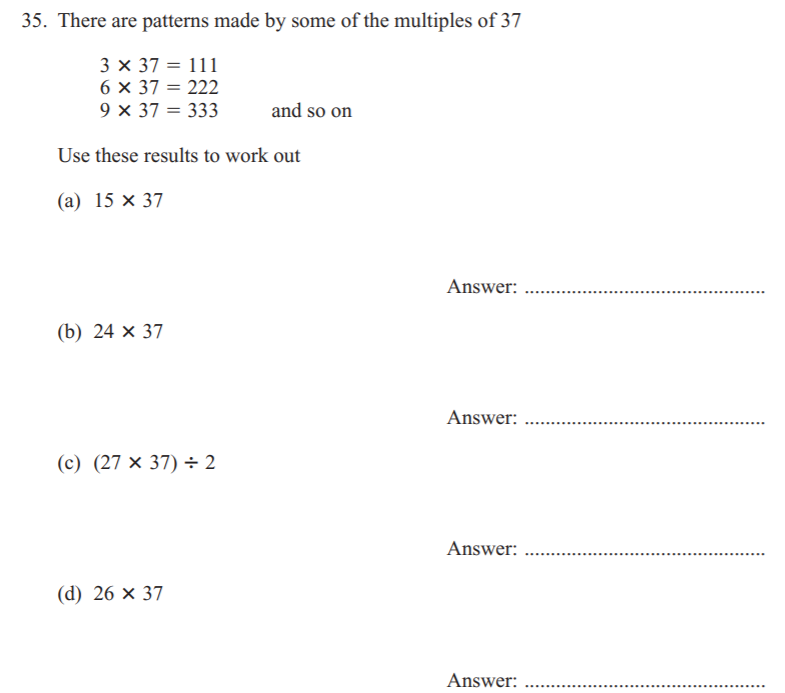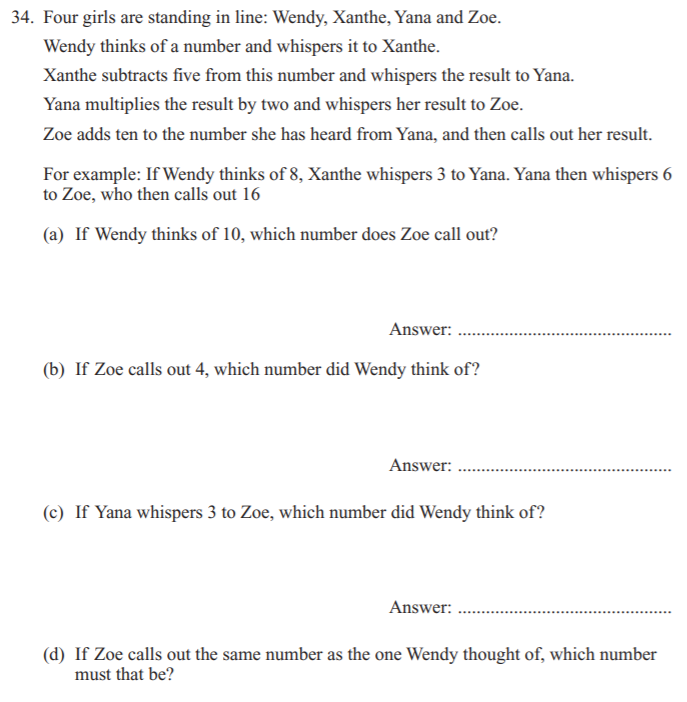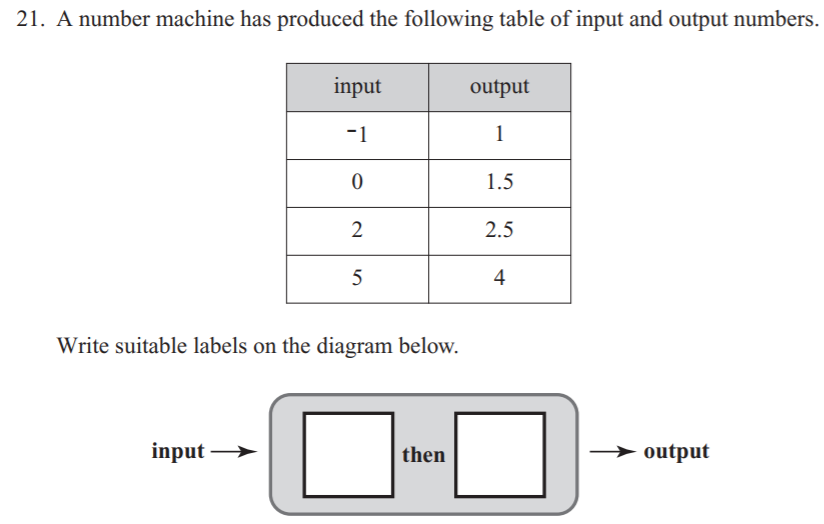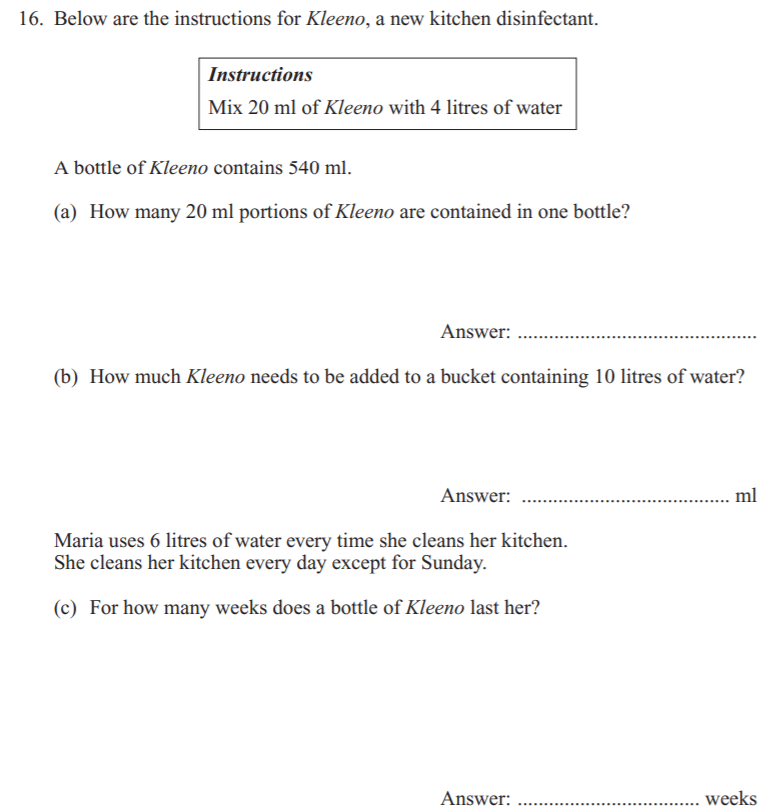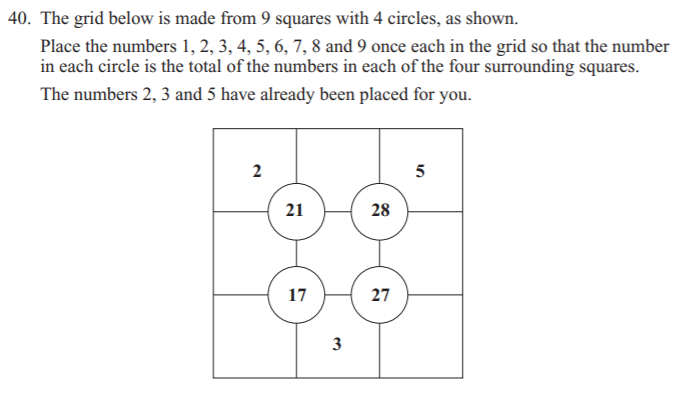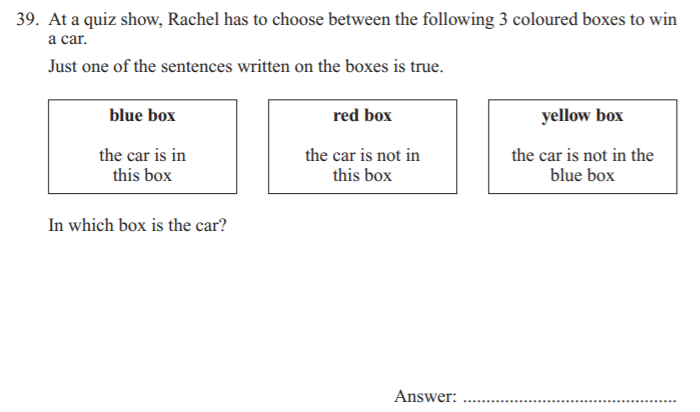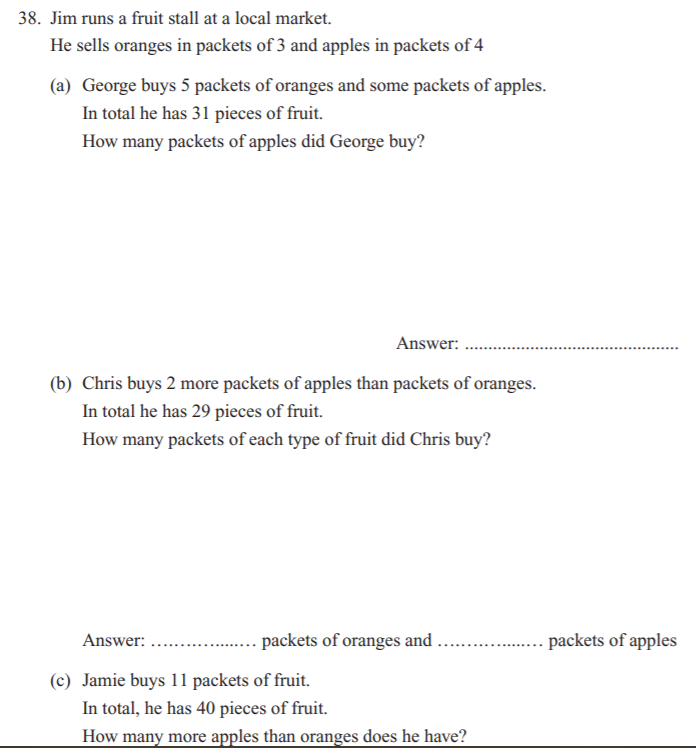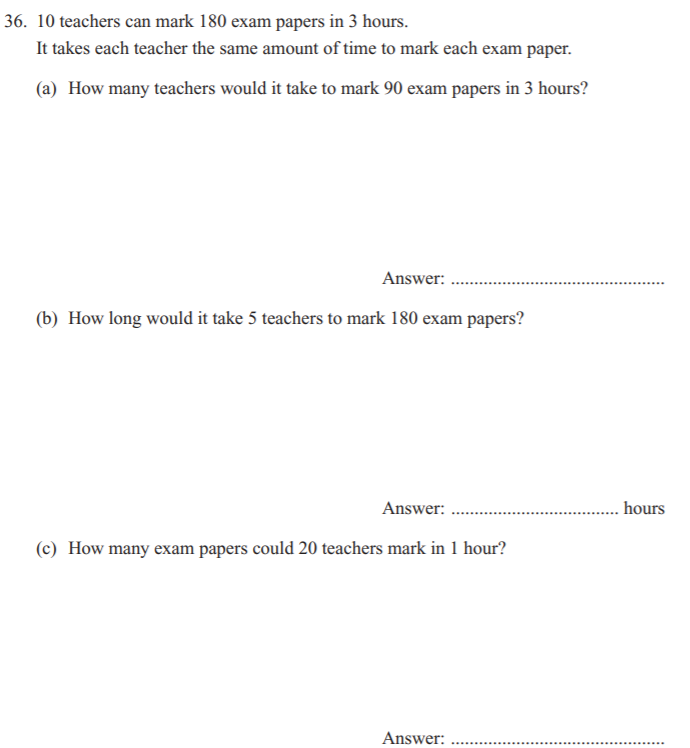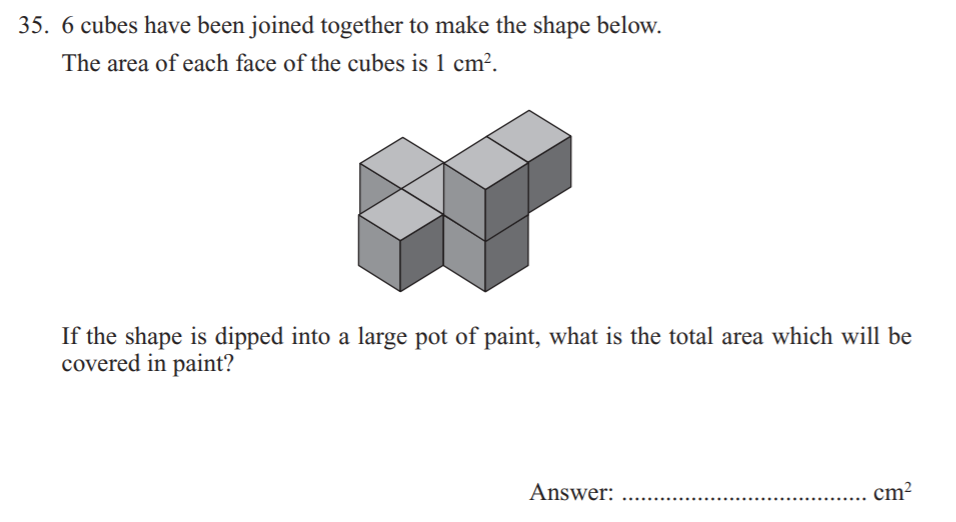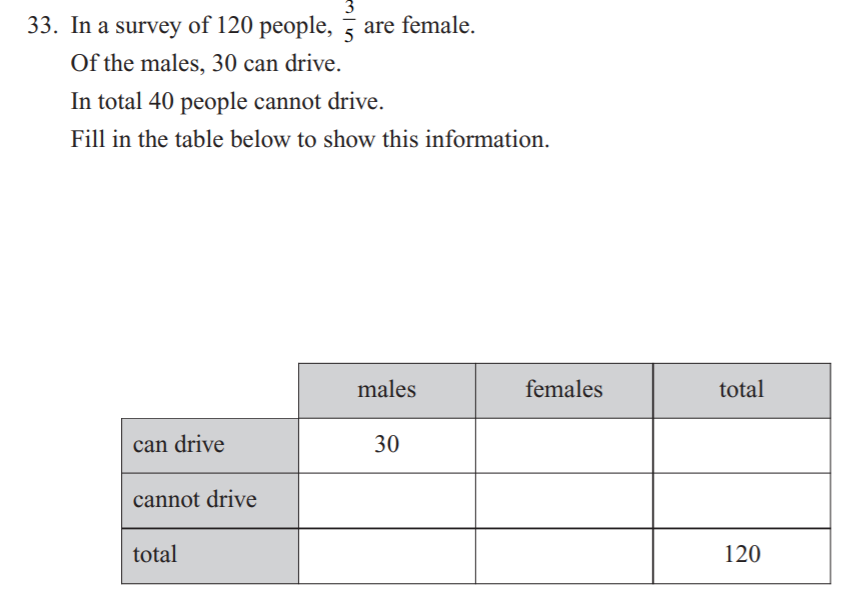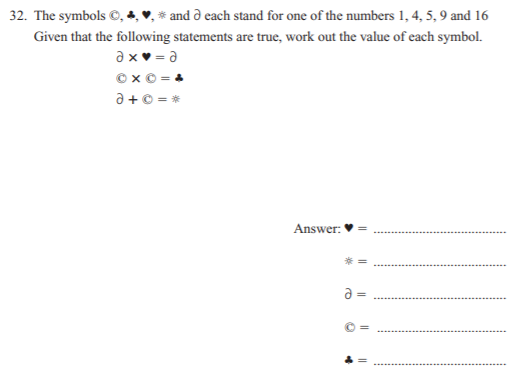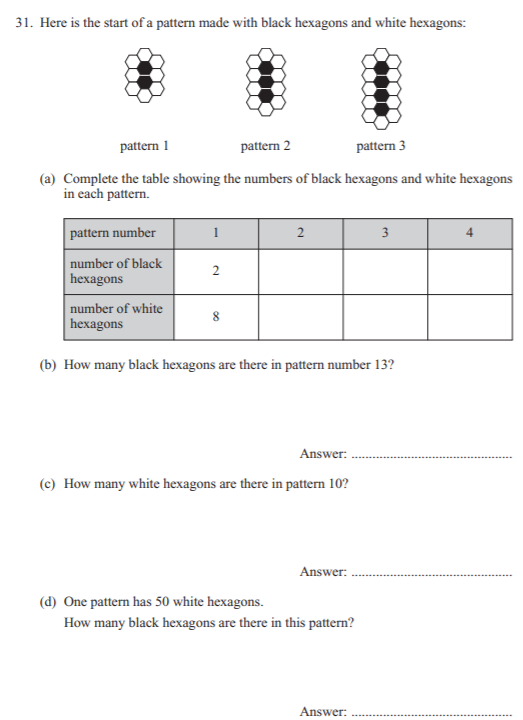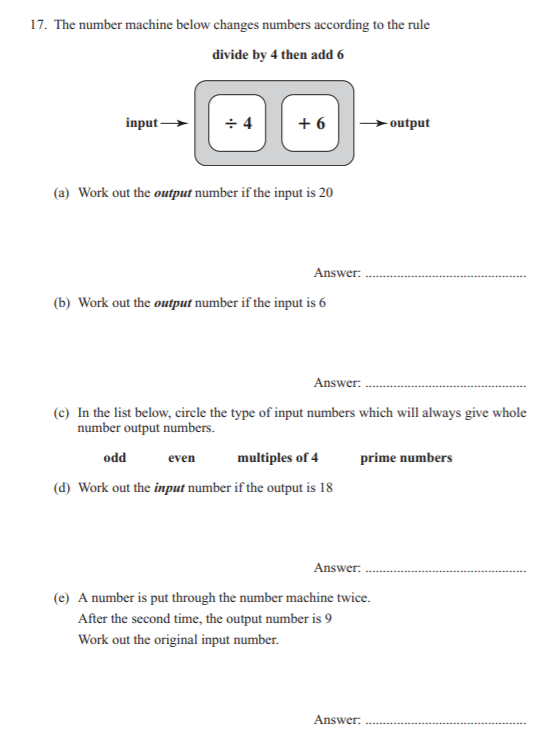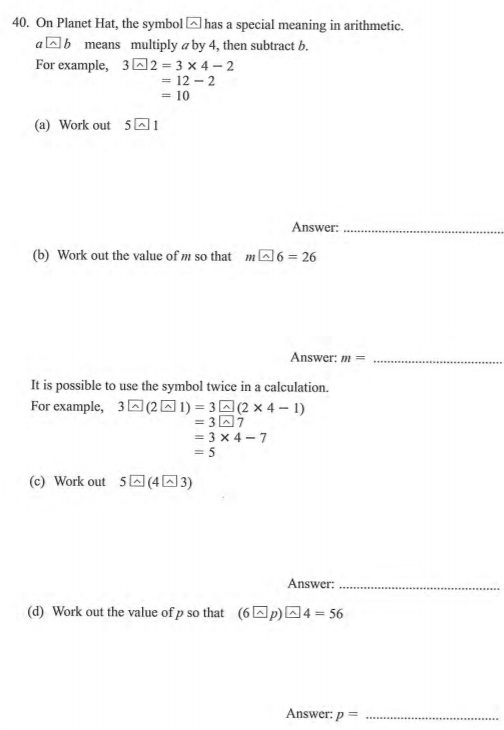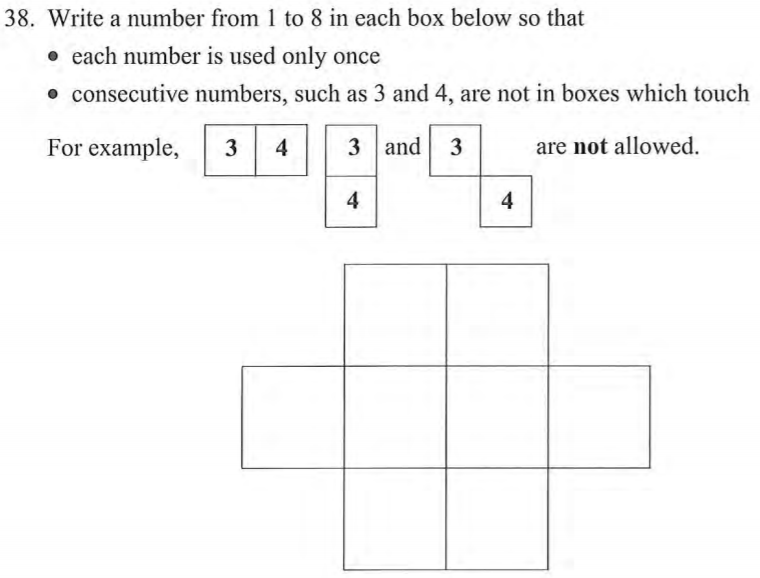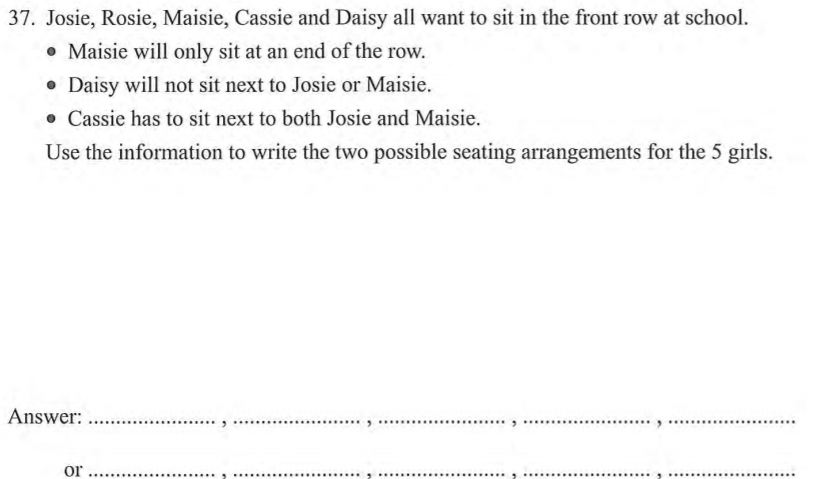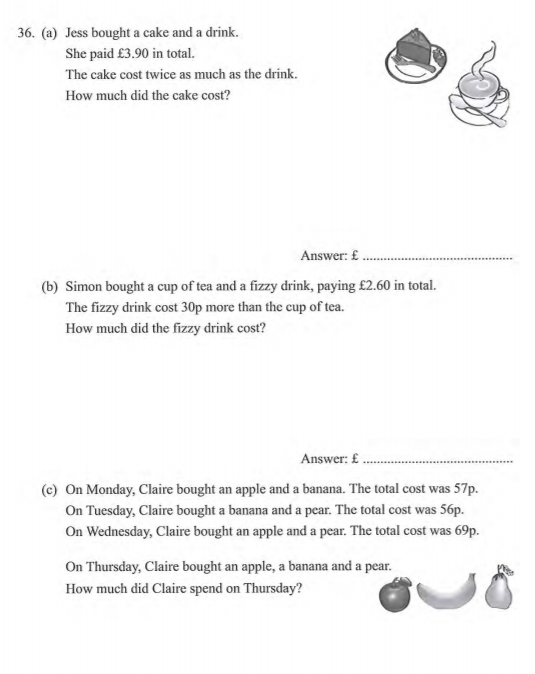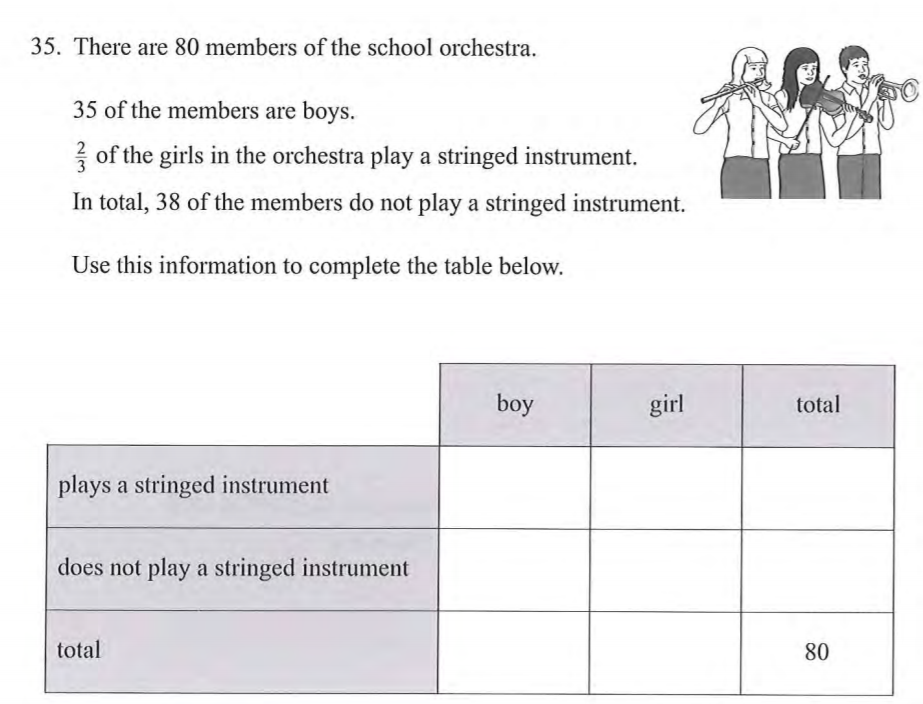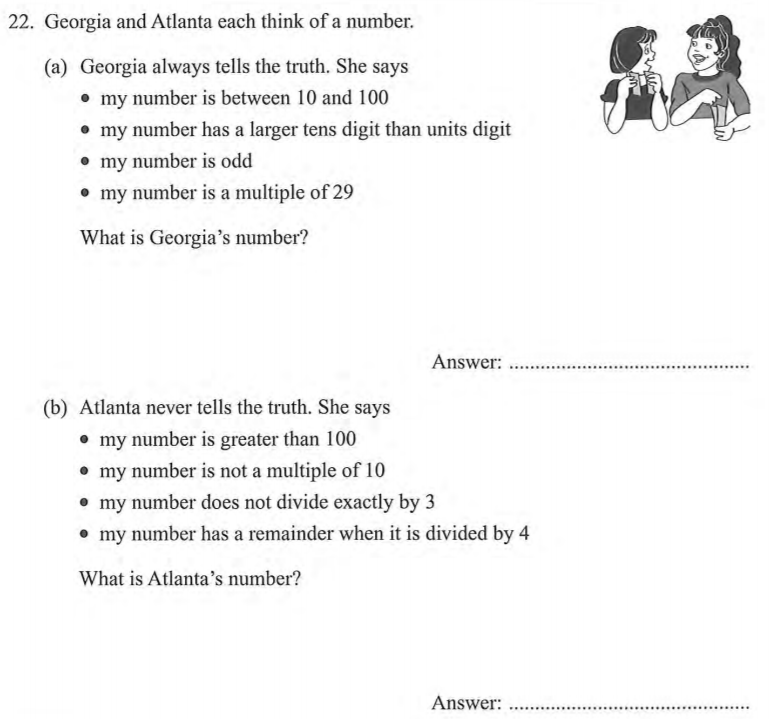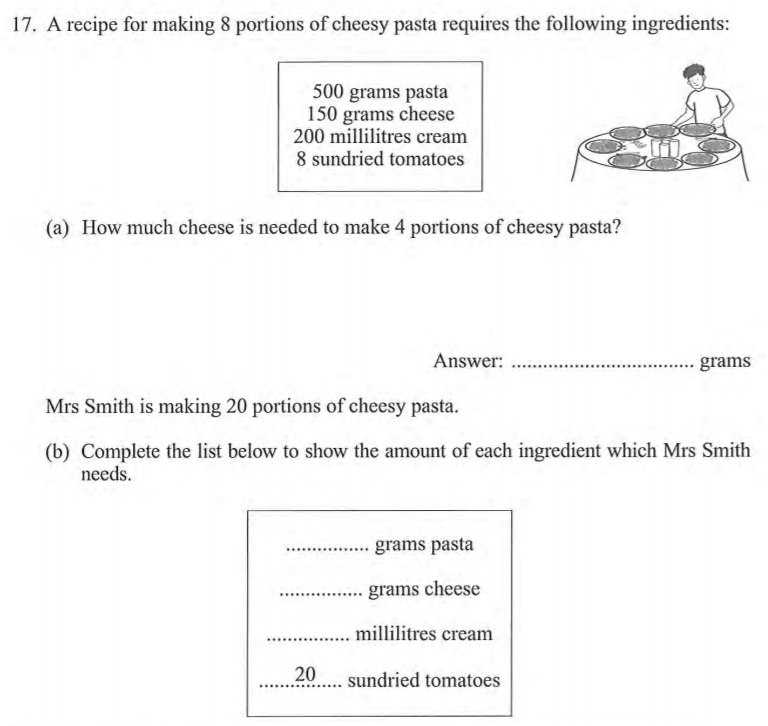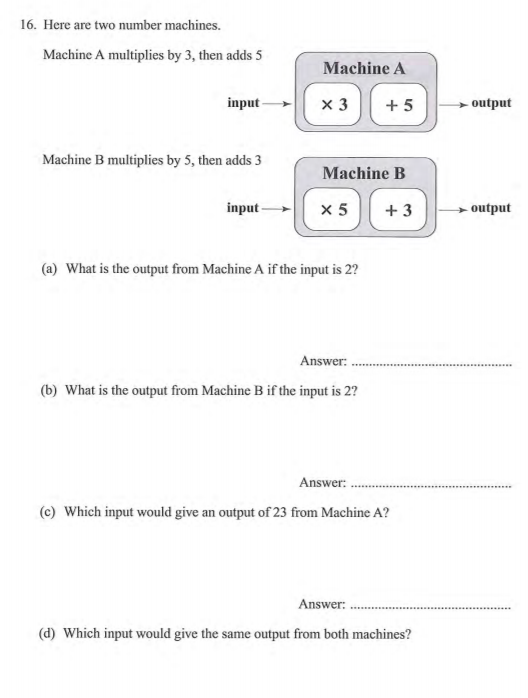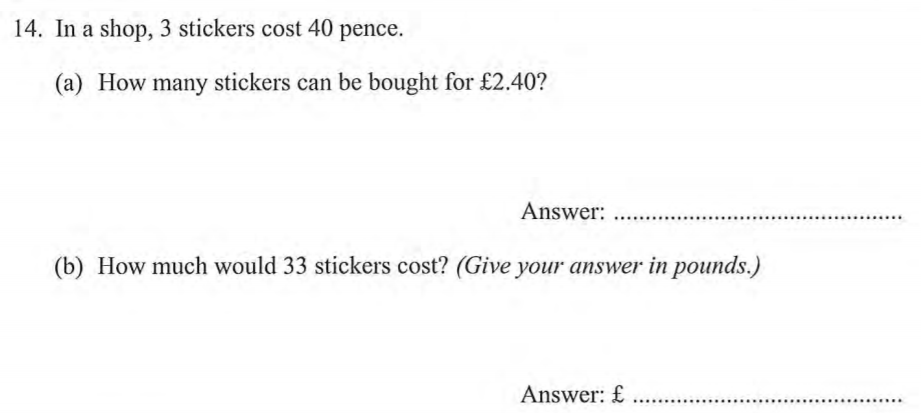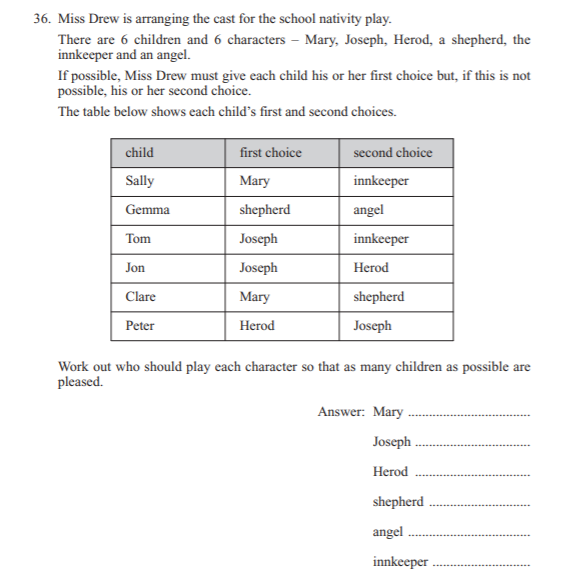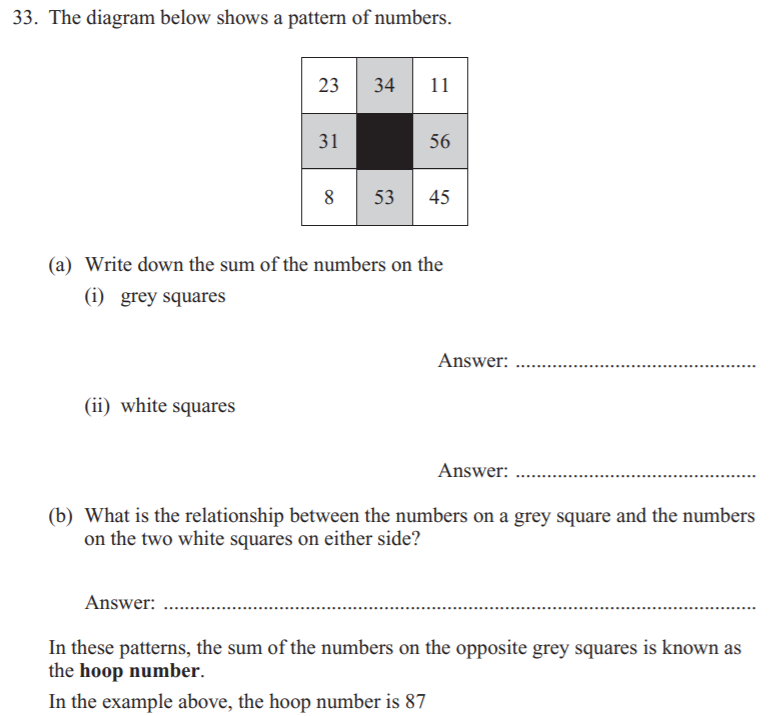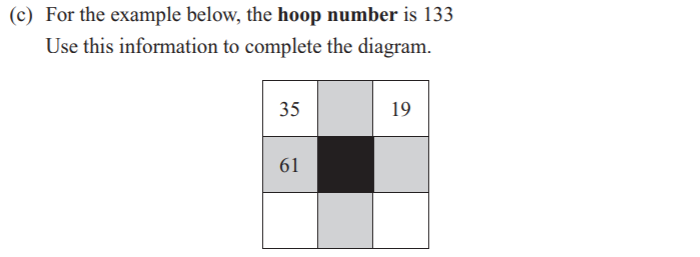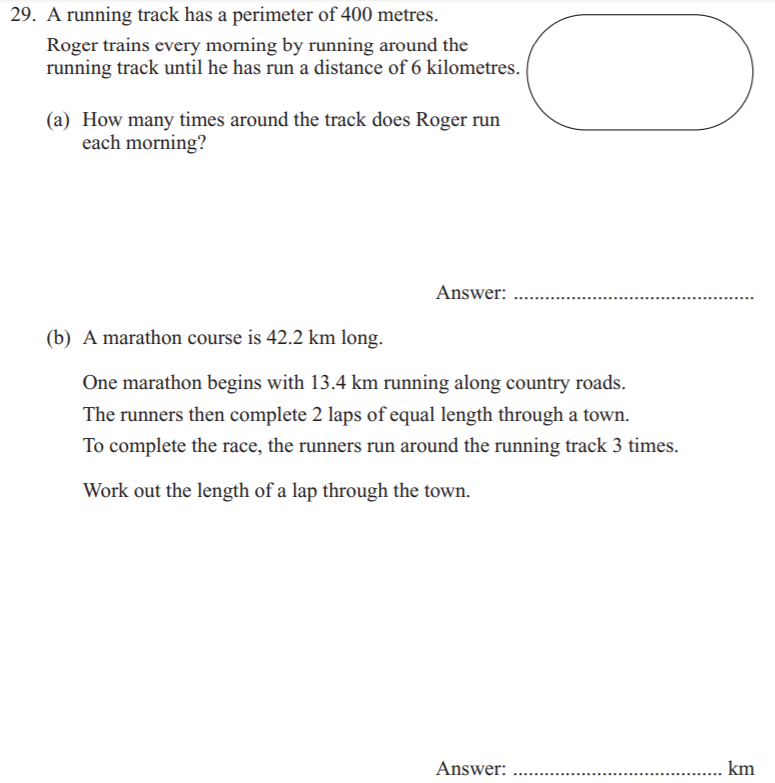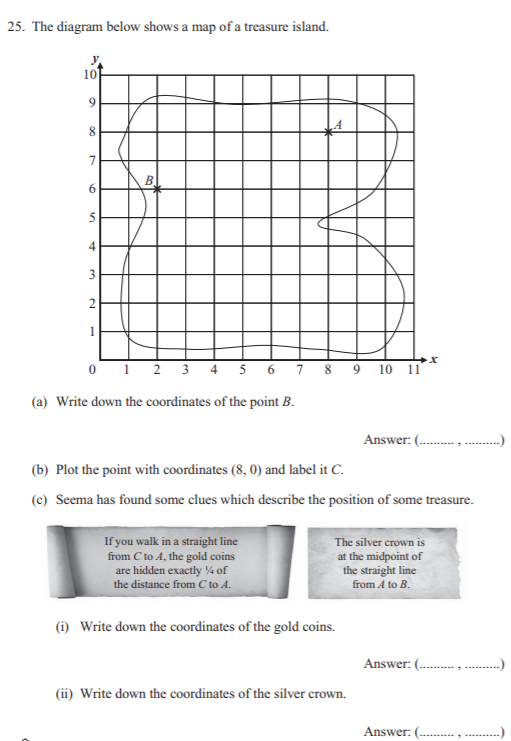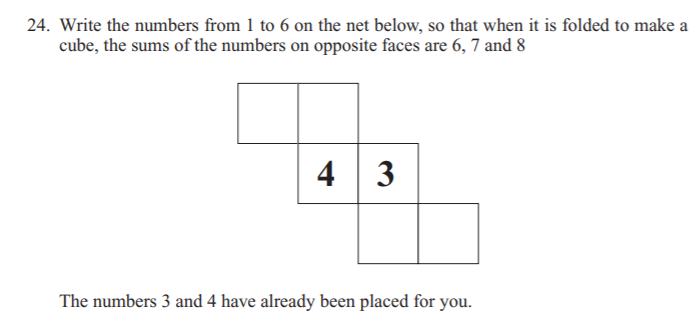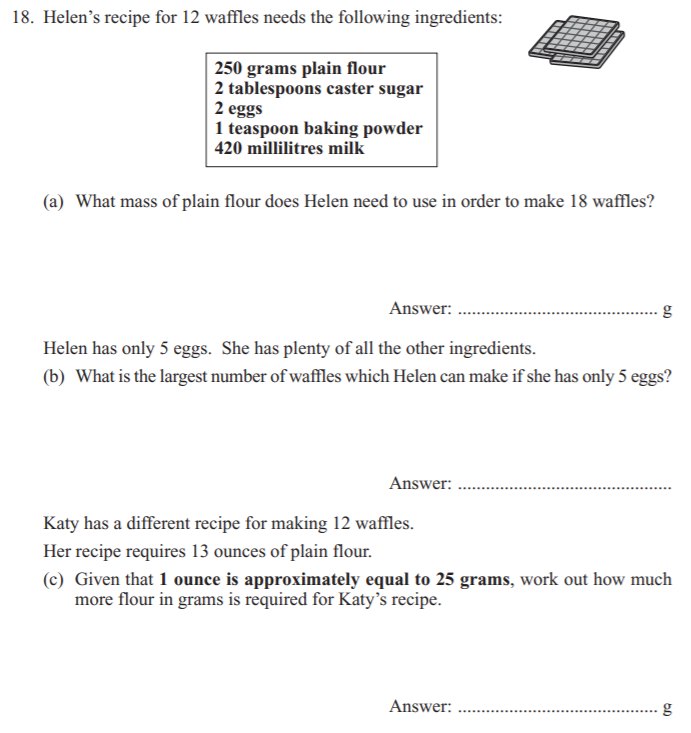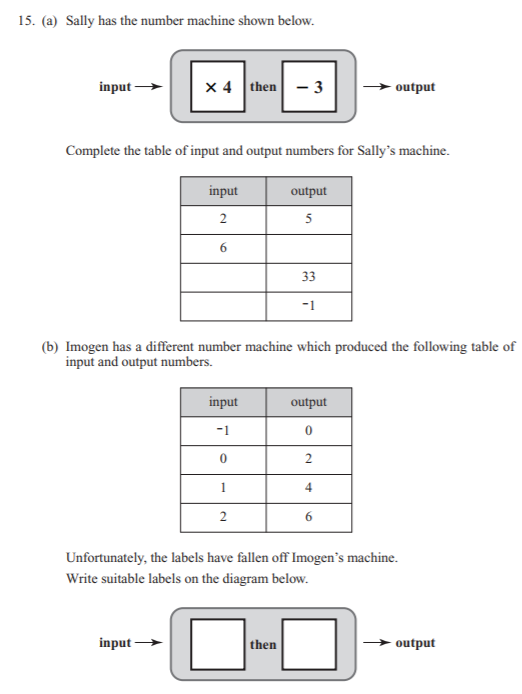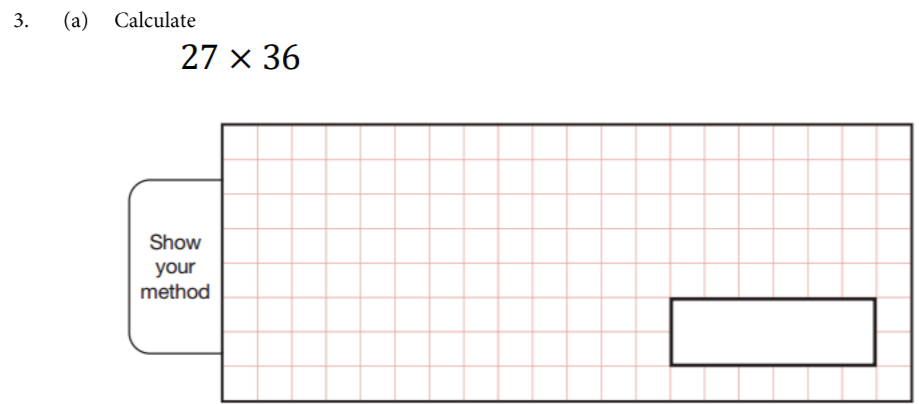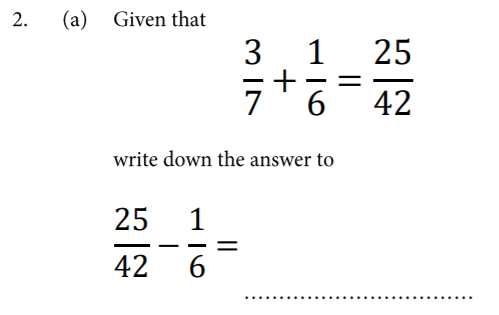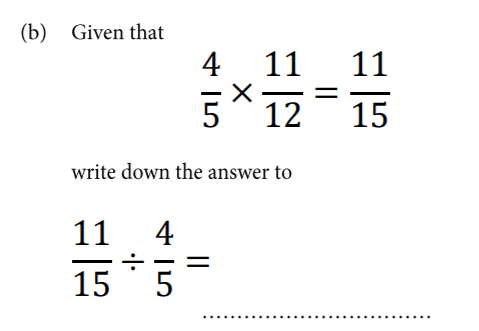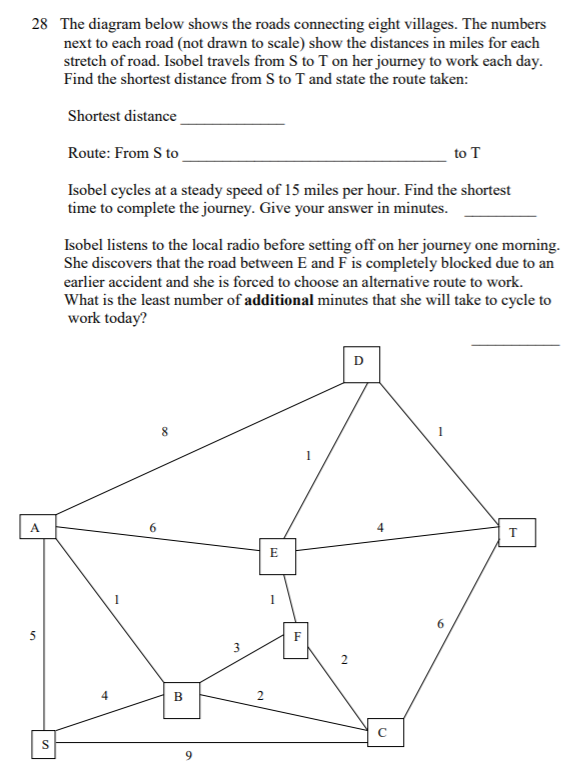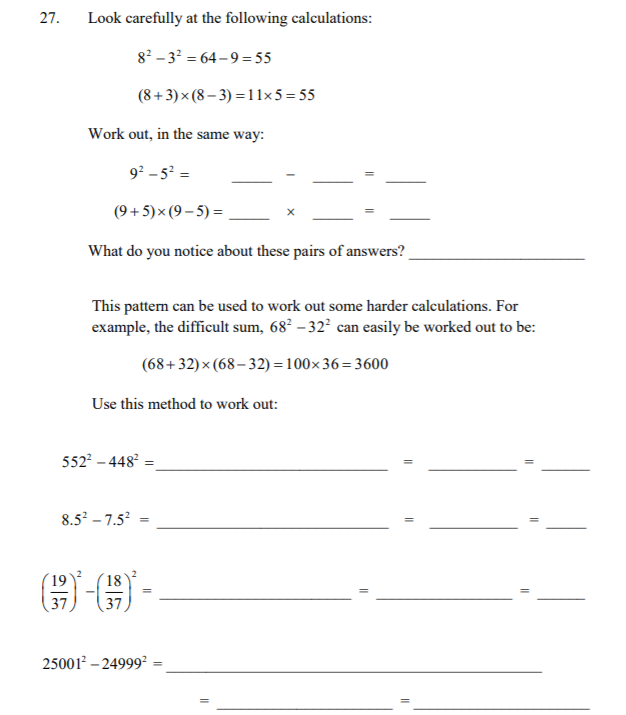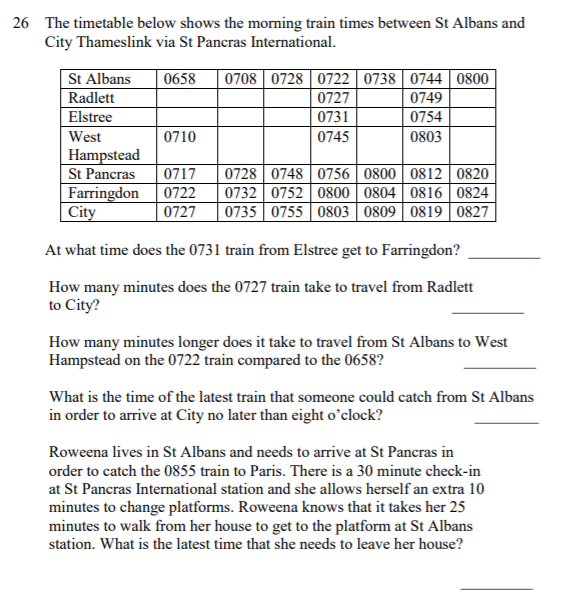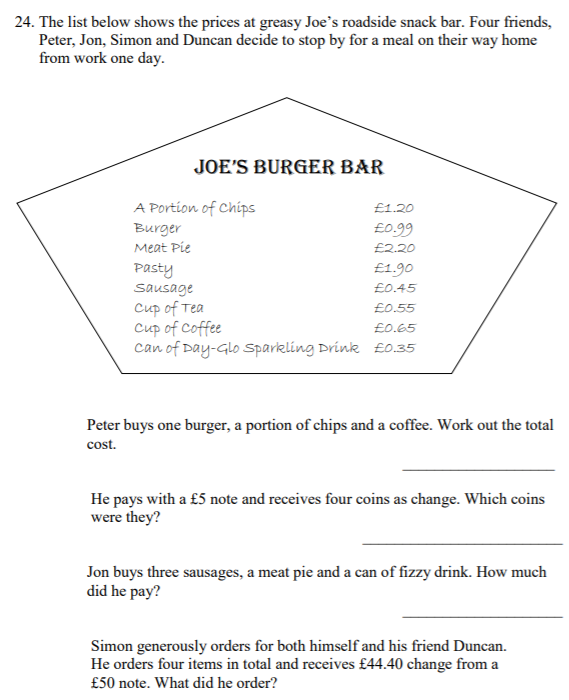48cm
Area of rectangle is 128cm²
So use algebra to solve (remember area of rectangle = LxW)
2x * x = 128 (where 2x = length and x = width. Use 2x given length is twice width)
3x=128
2x²=128
x²=64
x=8
So perimeter = (8*4 for the length + 8*2 for the width) = 48cm
10 Times
Monday Spaghetti & Apple Pie
Day 1 Tuesday
Day 2 Wednesday Spaghetti
Day 3 Thursday Apple Pie
Day 4 Friday Spaghetti
Day 5 Saturday nothing
Day 6 Sunday Spaghetti & Apple Pie
Every 6th day she eats both. So in the next 60 days, she eats both 10 times
B
A+C+D = 70%. Therefore, 30% chose B.
If 25% = 320, what does 30% = ?
The approach is to use HCF of 25 and 30 which is 5%. Work out 5% first of 320
This equals 64
Then 64 * 6 (given that 30/5% = 6 times)
Total is 384
a) 0.09
b) 0.05
c) 0.375
If not sure, you can use “reverse bus stop”. So for example, calculate per below:

17
Star = 4 from middle row.
Smilie Face = 7 from first column
Heart = 6 from first row (16-4) = 12/2
So heart + Star + Smilie Face = 4+7+6
24
Do inverse which is 624/26 = 24
a) 26
b) (32+9+6)=47 * (9-6) = 141 – (9-6) = 138
72cm
(15 * 4) + (3*4) = 60 + 12
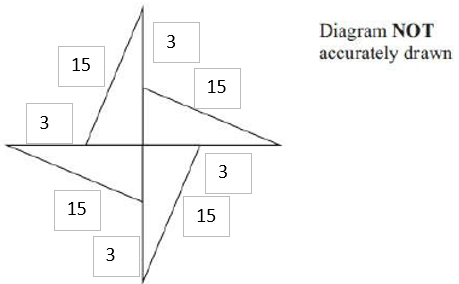
a) i) 31°
W = 180 – 107 – 42 = 31
180° in a straight line
a)ii) Reason is 180 in a straight line so its 180 less 107 less 42 to give the missing angle
b) x = 52°; y= 47°
For x…given JKL & MKN are straight lines, opposite angles in this set up are equal. Hence x = 52
For y….180 – 52 – 81 = 47°
13/40
- You have 1/4 shaded of the first square. 2/5ths shaded of the second square
- This is a question of being able to convert both fractions to the same denominator
- So this would be 20. 1/4 becomes 5/20 and 2/5ths is 8/20
- Then add both these together to get 13/40. Note its not 13/20 as you have to add the squares together which is unlike a normal fraction addition
17
130/8 = 16.25
Cannot buy 0.25 of a packet so need to buy 17 packets
a) See below

b) 41 Tiles
- Pattern 1 = 3Grey + 1White = 4 tiles
- Pattern 2 = 4Grey + 2 White = 6 tiles
- Pattern 3 = 5Grey + 3 White = 8 tiles
- So rule is (Pattern number + 1) + Pattern number = Total number of tiles
- (20+1)+20 = 41
c) 50
- The pattern starts at 4 tiles and goes up in 2s. But then you have to reduce it by 1 to get to the pattern number. So for Pattern 3, this is 8 tiles. 8 divided by 2 = 4. Less 1 = 3. Confirmed above that this is Pattern 3
- Therefore, if you have 102 tiles, then this is 51.
- 51 less 1 = 50
25
1 + 2 x 3 x 4 = 25
B
Number of grey tiles = 2*n where n=shape number
So for Shape 3, it would be 2*3 = 6 grey tiles
28 grey tiles = 2 * n so n = 14. Shape 14
For Shape 14, white tiles = (n+1) = 15
B
2Triangles = 1 Hex minus 1 Square = 6-4 =2
So a triangle = 1


A
Work backwards. 23 – 3 = 20. Divide by 4 and you get 5
A
1680 = 1680
Quick way is you are doubling the 24 to get to 48 on the other side. Then halving the 70 and getting 35 on the other side. So no calculations required in this question
a) 160cm
b) 168cm²
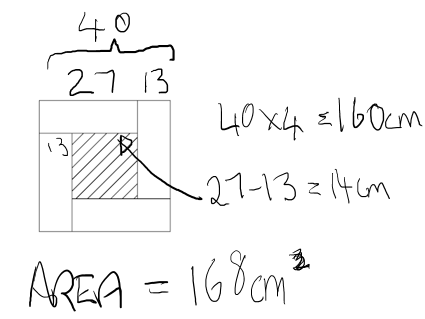
462cm
Large Triangle = 16cm * 3 (all sides same as its equilateral). So 48cm
Middle Triangle = 7cm * 3 triangles * 3 sides (7 small triangles of 1cm each on the horizontal base tells us its a 7x7x7 triangle). So 63cm
Next size Triangle of which there are 3 = 3cm * 3 triangles * 3 sides = 27cm. There are 3 of them so 27cm
Smallest triangle = 36 small triangles all of 1cm per side. So 3cm *36 triangles * 3 sides = 324cm
Total of all of these is 48 + 63 + 27 + 324
64cm
Perimeter = 14+3+4+6+7+2+17+11
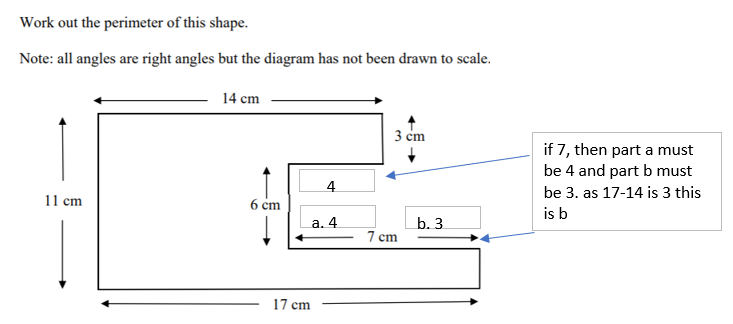
a) See below. 1.52

Convert to the same metric. So in this case, its better to convert to decimals
b) 0.3

For this, you should use reverse bus stop. So 70 goes outside the bus stop with 21 inside.
Then add zeros on so that you can work out the answer to 2 decimal places
Then change the answer by the number of decimal places you added. So if you added 2 zeros, then your answer of eg. 70 would become 0.7
1.08
- Sometimes, these questions can be done in 2 parts. First 6/6 and then 0.48/6
- 6/6 = 1
- 0.48/6. Treat this is 48/6 = 8.
- Then move 8 2 decimal places to the right. So 0.08
- So answer is 1.08
0.5 hours
- In one hour, Sachin can clean 1/3rd of the house
- In one hour, Peter can clean 1/6th of the house
- Convert to the same denominator which is 6
- So Sachin = 2/6 and Peter = 1/6
- Together, it takes 3/6 divided by 6/6 = 0.5 hours
15/26
When doing this type of question, you can’t answer 7.5/13 obviously. So the solution is to double each fraction and “force” a gap
So this becomes 14/26 and 16/26
Answer is 15/26
a) See below

b) 7 &10
a) 8
Mode = most common score. Scores were 9,6,8,4,8
b) 5
Range = 9-4
c) 7
9+6+8+4+8 = 35. Mean is average 35/5
d) 4
6.5 * 6 (6 being number of tests) = 39
French score is 39-35 = 4
e) 2/3
9/10; 6/10; 8/10; 4/10; 8/10; 4/10
He passed 4 out of 6 tests so 4/6 or 2/3
f) 35%
History score before was 4/10 – 40%
Now he scores 15/20 = 75%
Improvement = 35%
1/20; 1/5; 1/4; 6/20; 3/2
- Use estimation if needed. So this would involve converting all of the fractions to the highest denominator which is 20
- 6/20; 4/20; 30/20; 1/20; 5/20
- This makes it easier to rank them
6 DARK TOFFEES
Approach is to draw out the breakdown per below and start filling in one section at a time
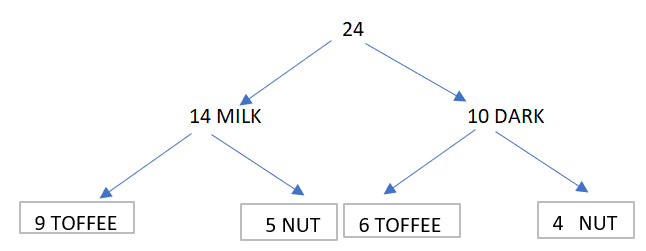
225
- In 4 nights, she ate an extra 25 + (25*2) + (25*3) so this is 150 more.
- Take this away from the total of 1050 gives 900
- So divide this by 4 and you get 225
- So day 1 225, day 2 250, day 3 275 and day 4 300
- Total reconciles back to 1050
267,120
742
53424
26748
- Add a zero on. So 267,120
- Its rearranging the formula so it becomes 742 = 26712/36
- Double the base answer of 26712 so it becomes 53424
- Add on 36 to the original answer. So its 26712 + 36 = 26748. (ie an extra 1 x 36 since number changes from 742 to 743)
Area of 1 rectangle = 15 x 5 = 75cm²
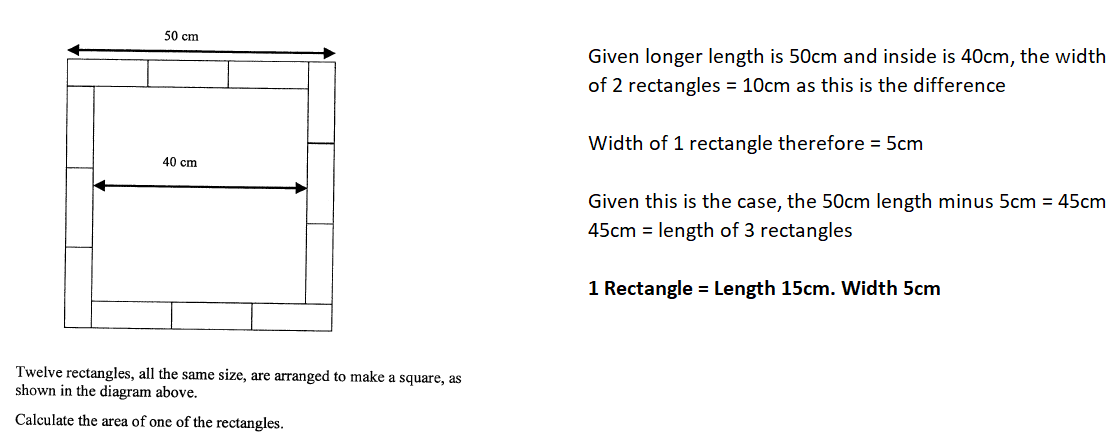
4 children
- 56 legs with 3:1 ratio dogs:children
- 12 dogs = 48 legs. 4 children = 8 legs. So thats 56 legs altogether
- For every 3 dogs there are 12 legs. For every 1 child, 2 legs. So leg ratio is 12:2 = 14 legs
- Then work up in 14s to get to 56 which takes you to 48:8
- So 8 legs = 4 children
11
- 24 people. 4 got off so this left 20. X people got on
- Assume zero got on for now at the last stop
- Second stop . 20 with 3 people getting on leaving 23
- If there were then 34 people, it means 11 people got on at the first stop
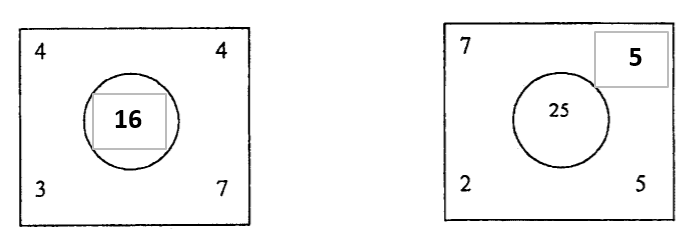
Work backwards for this section….
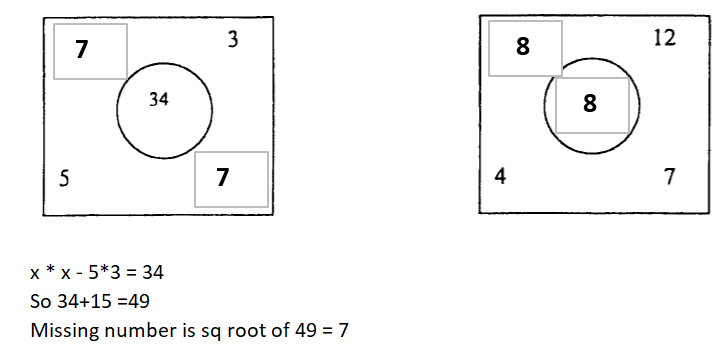
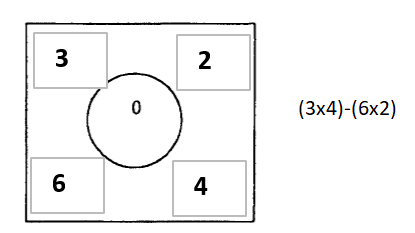
Then BC + A = BC + 4 = 37 so BC = 37 –> B = 3, C = 7. A=4
Checking, 43 + 7 = 50.
42
- Work through the multiples and add on the remainder where necessary
- 4 – So multiples with 2 added on would be 6,10,14,18,22,26,30,34,38,42
- 5 – So multiples with 2 added on would be 7,12,17,22,27,32,37,42
- 6 – 6,12,18,24,30,36,42,48
Sam 9 years
Ben 3 years
Frederick 16 years
Mylo 11 years
- Always write it down numerically as much as possible. This gives a clearer view on the workings required and/or the answer
- Sam + Ben = 12
- Frederick + Sam + Ben = 28
- Therefore, Frederick must be 16
- Mylo + Sam = 20
- Total of all brothers = 39
- Therefore, remaining ages total is 23.
a) 51,000
with 2 zeros added onto the equation, you just add 2 zeros to your answer
b) 255
halve the answer
c) 30
510/34 would give 15
Therefore 510/17 would give 30
1 and 4
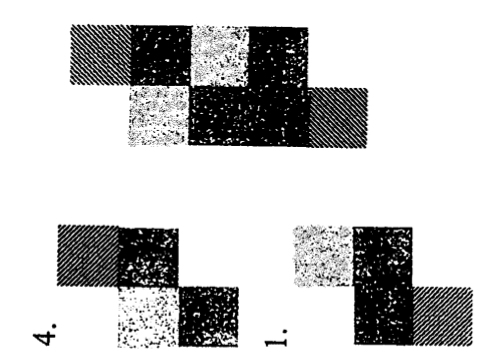
48
- Do your 3 x 4 times table to find a number in between 41 and 51
- So 12,24,36,48
- Answer is 48
8
- Convert £ to pence
- 300/36 = 8.33
- So 8 full bars
6 weeks
- Per week she gets (79p-44p) profit. So this is 35p per download
- 150 downloads per day = 150x35p = £52.50 per day
- £2000/£52.50 = 38.1 days
- So this is 6 weeks as this is 42 days as she gets paid at the end of each week so you can’t use part a week
6.25
probability (3,7) = 1/2
probability (1,2,3,4) = 1/4
To get 7, you would need 3 on the coin and 4 on the dice. So thats 1/2 * 1/4 = 1/8 times you get a total of 7. So 1 out of 8 times
6 times you would expect to get the total 7. As you would get 7 every 8th time. So then after 48 times you get 7 6 times
The 2 remaining roles you have a 0.25 chance of getting 6 .
So 6.25
96 tiles
3metres long and 4m wide = 12m² area
You will get 12 tiles in the width from 25cm tiles (3metres = 300cm. 300cm/25 = 12 tiles)
Across you will get 8 tiles in the length from 50cm tiles ( 4metres = 400cm/50cm – 8 tiles)
12 x 8 = 96 tiles
a) 64cm²
Perimeter = 32. Therefore, each side is 8cm
Area = 8 x 8 = 64
b) 48cm²

a) £27
Cost = ((8×3) + (3×1)) = 24+3 = 27
b) 2 adults. 3 children
Use £25 and work backwards taking off children until you get to a multiple of 8
So £16 would be the number
£25-£16 = £9. So thats 3 children
Leaving £16 so its 2 adults
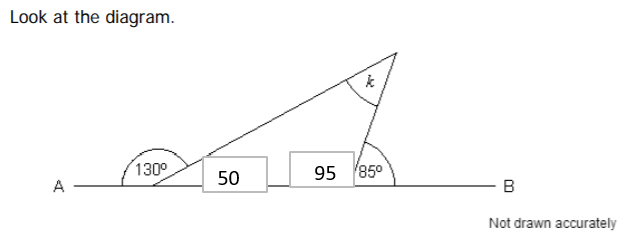
k = 180 -50-95 = 35°
39
- Catherine gets 22 sweets
- Alison gets 11 sweets
- Bhavini gets 6 sweets
3
- Work backwards
- 38 + 7 =45
- 45 /15 = 3
25,100 millimetres
- 25.1metres = 25.1 x 100 = 2,510 centimetres
- 2,510 x 10 = 25,100 millimetres
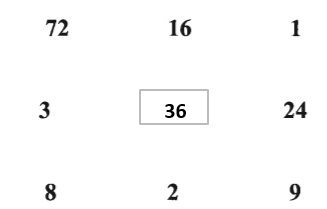
All the common factors of 72
100°
- At 4:40, hour hand will be 2/3rds of the way between 4 and 5
- Minute handle at 40
- So each hour or number on the clock is 30°
- From 4:40 to 5:00 the degree angle is 10°
- From 5:00 to 8 (Which is for 40 mins), the angle is 3 x 30 – 90°
- Add 10 degrees per note 4 and you get 100
20 students
- Work on basis 6 students = 30°
- Therefore, 2 students = 10°
- So, 100° = 20 students
32 minutes
- Convert time to minutes
- So 75 minutes – 43 minutes
Approximately 40°
An acute angle
a) 52
5 x 10 + 2
b) 127
5 x 25 + 2
c) 67
Work backwards. 337 – 2 = 335
335/5 = 67
d) Van = 2.5 metres; Car = 1.8 metres
Additional 5 metres = 2 vans
Van = 2.5m
If a van is 2.5metres, then using the first jump of 14 metres, we take 2 vans off this which is 5 metres leaving 9 metres.
Per car, this will be 9 metres/ 5 cars = 1.8m
3
- Convert to 10ths and then back again
- So that would be 6/10 + 3/10
- This would convert back to 3/5 + 3/10
7
- Work backwards.
- 16 + 5 = 21
- 21/3 = 7
33
- Use division so you get 6240/192 = 32.5
- So we need 33 trips
3/12; 2/8; 1/4
- Best way to compare fractions is to convert to the Lowest Common Denominator
- But this is tricky with tight timelines
- Therefore look for a common denominator where possible
- 3/12; 2/8 & 1/4
321
279
20
- It is one extra “21” So 321
- It is one less “21”. So 279
- It is 20
42857
It is possible to make the following equation:
3(100000 + x) = 10x+1
(Why? Well, adding 100000 puts a 1 at the front of a five-digit number, and multiplying by 10 and adding 1 puts a 1 at the end of a number)
Solving this gives:
10x+1 = 3(100000 + x)
10x+1 = 300000 + 3x
10x = 299999 + 3x
7x = 299999
x = 299999/7 = 42857
The answer is 42857 (142857 is three times smaller than 428571)
a) 127cm
Convert to cm. 214-87
b) 25 bags
290/12 = 24.2
Round up as you need to cover the “0.2” requirement. So 25 bags
D
250cm = 2.5m
A=1, B= 4, C=8
There is a bit of trial and error involved here.
When you work through some permutations, you know C can’t be 0-3. This is because you do need a number that drives some form of carry. This impacts the tens and hundreds columns
So its 4-9
b) 1089
For 4-digit numbers, let a, b, c, and d be the digits, so
9*(1000*a+100*b+10*c+d) = 1000*d + 100*c + 10*b + a
8999*a + 890*b = 10*c + 991*d
This implies that d = 10 - a, by looking at last digits, which we
substitute, and get
9990*a + 890*b = 10*c + 9910
When we divide by 10, we get
999*a + 89*b = c + 991
This implies that a = 1, so
89*b = c - 8
This implies that b = 0 and c = 8, and there is only one solution
9*1089 = 9801.
a) 12 seconds
- After 2 seconds, Gary is at 20metres which is when Andy starts running
- So Andy has 20 metres to make up
- It will take him 10 seconds to close this gap as he makes up 2 metres per second
- Add the initial 2 second start that Gary had over Andy
b) 120 metres
- Distance = Speed x Time
- Therefore = 12m/s x 10 seconds = 120 metres
a) 49cm
Length of cane that snapped off is 2.05m = 205cm minus 156cm
Converting all to cm makes the question much easier
b) 14
Would need 14 = 168m²
13 would give 156m² so not quite enough
D
- If the pen costs 50p more, then the way to start with this question is to assume they cost the same
- This would be 55p each
- Then take the difference of 50p and split it into 25p and 25p
- Add 25p to the pen and take 25p from the pencil
- So the pen would be 55p + 25p = 80p
C
- Logical Thinking. 17cm
a) 45
Fail = 15 boys = 1/4 of the pie or 90 degrees
Therefore, if 1/4 = 15, 3/4 = 45
b) Charlie is incorrect because you do not know how many boys and how many girls there are in Year 7. This is required to work out the answer. There may for example be 24 boys and only 5 girls. This would mean 6 boys fail the test and less than 5 girls fail the test.
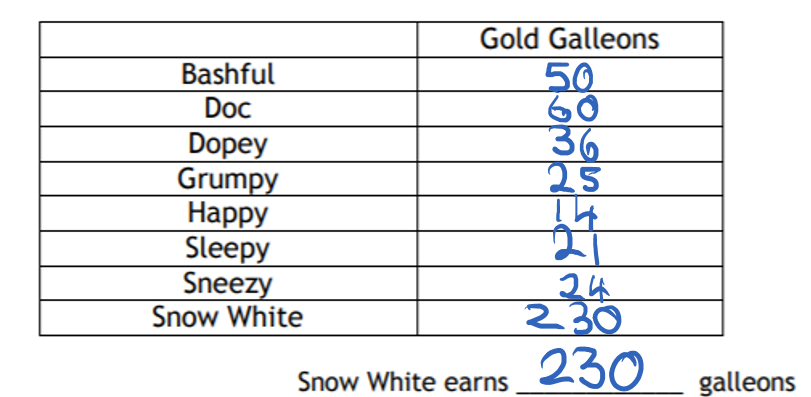
Start with Sneezy as this is given as 24 and work from there
Grumpy gets 1 more so is on 25 etc etc
16:27
- Logical thinking. Go in multiples of 10 until 6 is also a multiple of that number
- So this gives 30 minutes
- Next time both trains leave the platform at the same time is 16:27
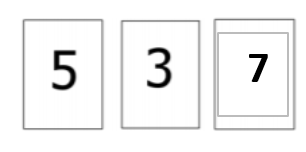
- The rule of thumb to see if a number is a multiple of 3 is to add up all of the digits
- So in this case, 5+3+7 = 15
- If all of the digits added divide by 3, then thats the number
- In this case we were going for the largest number. Smaller options would have been 534 and 531
5 Pens 4 Pencils
- Whatever you buy in pens, just end in a 5 or 0. So the only number this applies to between 0 and 55 is 35
- So its 5 Pens. This leaves 20p
- 20p is for pencils @ 5p each
- So 4 pencils
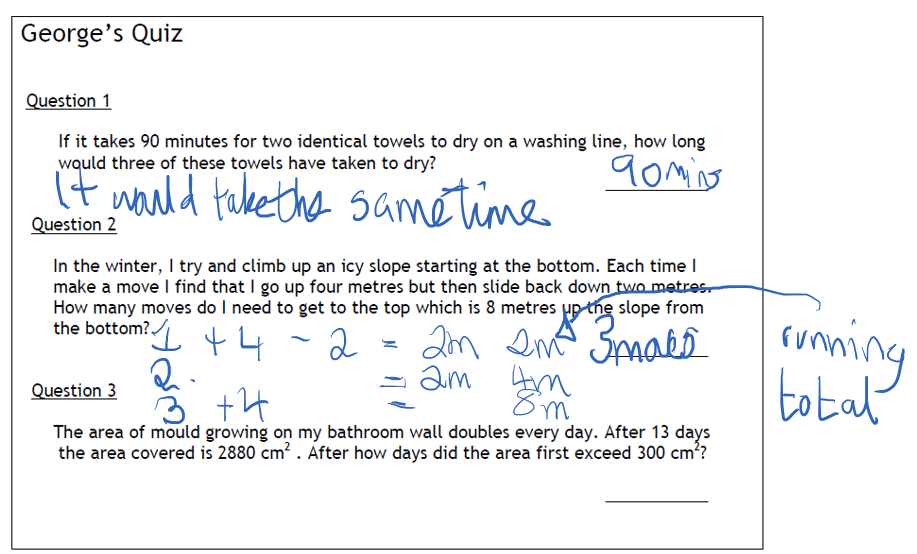
QUESTION 3….After 10 days

16
- We know that 7 years ago, H was 4 years old which is 11-7
- Mothers age would be 4 x 12 = 48
- Therefore, 5 years on, would mean H would be 11+5
- So 16 years old
19
75/4 = 18.75
Answer is 19 not 18. Because you need 19 boxes to ensure all 75 cakes are stored
See below
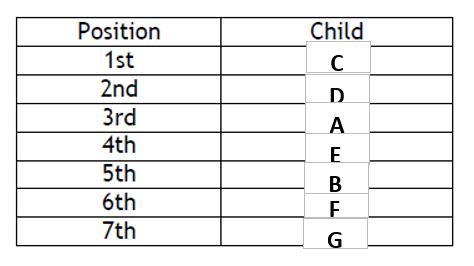
Just work through each child at a time starting with the most obvious…..the Winner
Then going from there. Only tricky one is A & E. Which one comes first? Well its A because of the statement that A x D = F. This can only be 2 x 3
See below
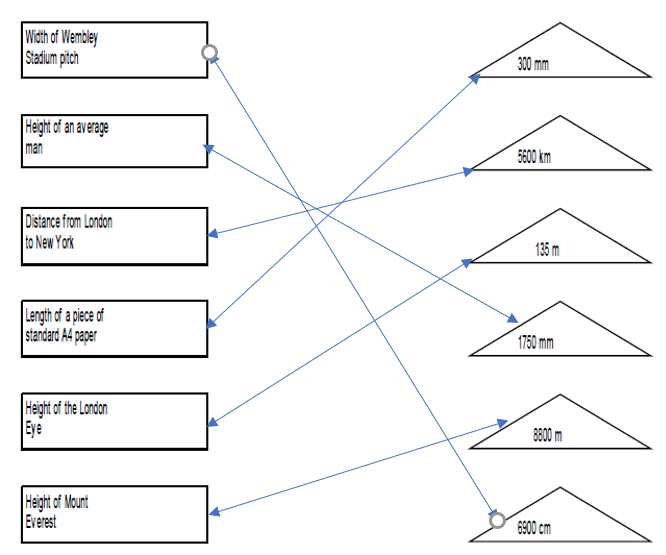
Because you can make coffee whilst the toast is in the toaster
Shortest time is 4 minutes
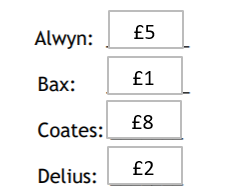
Work on the basis that everyone starts at £4. 4 people and they shared the bill equally. So £16 total bill. Then go from there and adjust each individual as required
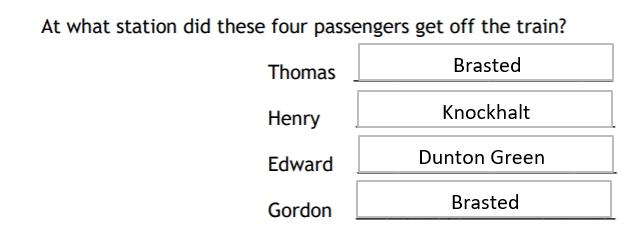
Need to work through each person to understand the possible options:
Thomas – Brasted, Westerham or Dunton
Henry – Knockholt or Dunton
Edward – Dunton or Sevenoaks
Gordon – Brasted or Knockholt
See below

The trick here is to substitute the actual scenarios with a given value. For example, assume the value costs £4.
Then use this figure in every single option to see which one works
48cm
- You have to think about times tables;
- So the shortest length will be the LCM of 6 & 8;
- This is 48cm
35
- Use the power of estimation. This is a crucial technique in maths
- As you are doing questions, try and estimate the answer.
- When you calculate your answer, you will have an idea if you are close to the answer
- In the above, round the numbers. So it becomes 7 * 5 (Given square root of 26 is approx 5)
- Answer will be 35
4
- Definately a logical thinking question
- What you do is cross cancel 56, 55 & 54 because they are on both sides of the brackets
- Therefore, the revised question becomes 57-53
a) 16
b) 24
(However many people there are, permutations are each number x each number. So for example if there are 3 people, possible permuations are 1x2x3 =6. For 4 people, its 1x2x3x4)
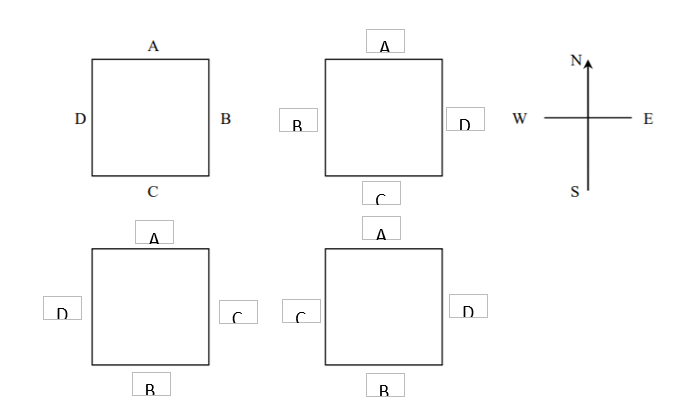
a) 5
b) 10
c) 1 & 8
Detail to be added
a) i See below

a) ii See below

b) 13,20,24
- 4=2² with difference as 2
c) 0,1,4 & 9
- 0²=0; 1²=1; 2²=4; 3²=9
d) See below
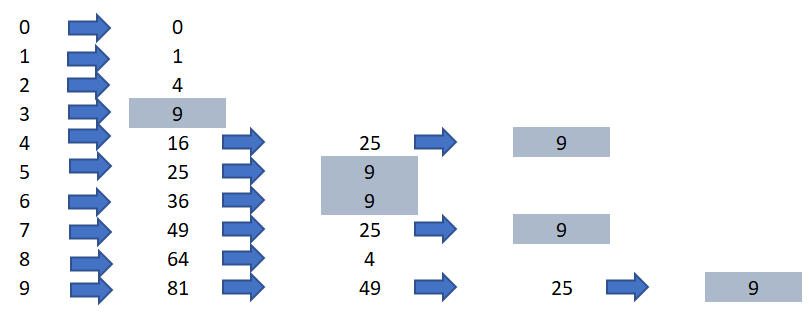
T=36,S=54,R=108
- Use a ratio style approach
- R=2xS. S=1.5xT
- So T=1; S=1.5; R=3
- Total parts = 5.5
- 198/5.5 = 36 (Use bus stop but you can do 55 into 1980 so that you do not have to deal with the decimal
- So T=(1*36); S=(1.5*36=54); R=((3×36)=108)
a) See below
b) From the table:
- Cone, Vanilla, Flakes
- Tub, Mint, Sprinkles
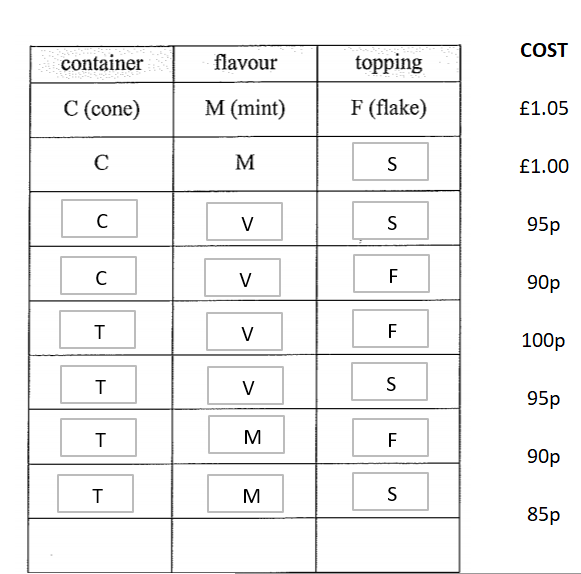
a) 48cm
See labelling below
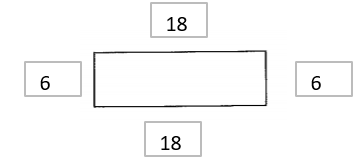
b) 108cm²
Area = WxL. 6×18
c) 18
In 18cm across, she can fit 6 (18/3). Given its 6cm tall, she can fit 3 high. So in total 3 rows each with 6 in each row 18
12
Consider the various options to multiply to get to 72.
2 x 36; 3 x 24; 9 x 8, 12 x 6
12 x 6 is the only option which meets the criteria
a) See below

Use the HCF Principle. This is the best approach. So HCF of 6 & 15 is 3. Therefore, work out what is needed for 3 people
Then multiply the result by 5 to get to what is needed for 15 people
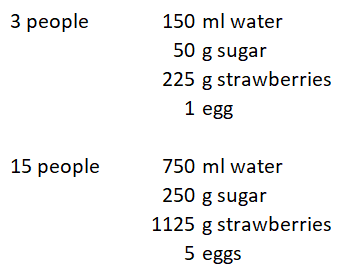
b) 60 people
If 100g is 6 people, then 1kg is 10x 6 people
a) 1,592
1554 + 38 = 1592
b) 777
Half of the original answer (37 * 42)/2
c) 3.7
37/10
See below. The clue as to how to complete it is given by the fact that the diagonals given add up to 15. So all horizontal, vertical and diagonals need to add up to 15

a i) 80
ii) 23
Work backwards. 120/4 = 30. 30 minus 7 = 23
b) x2 -6 OR -3 x2
3
Work Backwards. 56 / 8 = 7.
Then 7 minus 4 = 3
a) 2040
Move the decimal 2 places to the right when multiplying
b) 1050
- You can do the inverse operation here and multiply 1000 x 1.05 to get to the answer
- If not sure, then do the calculation in 2 parts:
- 1000 x 1 = 1000
- 1000 x 0.05 = 50 (Remember 0.1 = 10% = 100. So 0.05 = 5% = 50)
- Then add both numbers together
Start with 7 and the permutations for 7 and work from there
So (1,6), (2,5), (3,4) etc
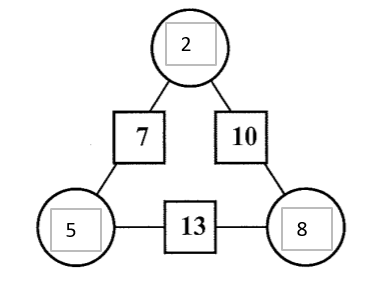
a) 14
9 in lower level, 4 in middle level, 1 at the top.
b) 30
- Observe the sequence. This question is simply sequences in pictures
- 1st tower is 1×1 on the base. 2nd is 2×2. 3rd is 3×3.
- 4th will be (4 x 4)+ (3×3) + (2×2) + (1×1) = 16 + 9 + 4 + 1 = 30
c) 55
Add on a 5 x 5 to the answer for b)
d) 100
Noting the comments for b), this therefore is a 10×10
a) 24
- Give that Cats = 48 = 120º
- Hamsters = 60º. Therefore, they are half of cats = 24
The true way to look at this question is to say if 120º = 48, then what is the HCF of 60 & 120. This is 60. Therefore, take the 120 and say how many 60s go into 120. This is 2. Therefore, 60 = 24
b) 60
- Cats 120º + Hamsters 60º + Other 30º = 210º
- Remainder is 360 – 210 = 150º
- Again, HCF principle. Given you know 60º = 24, what is 150º?
- HCF = 30. So 30 is half of 60 so it equals 12
- Then how many 30s into 150 = 5
- Therefore 5 * 12 = 60
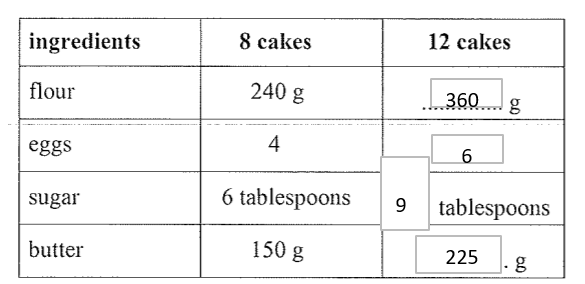
- The easiest way to complete these questions is to think about the HCF multiple.
- Look at how many cupcakes you have ingredients for. Its 8. You need to complete for 12.
- HCF of 8 & 12 is 4. Therefore, if you work out the ingredients for 4 cupcakes, then you can multiply up by 3x to get to 12
- So for 4, its half of what is required for 8
- So butter would be 75g.
- x3 would give you butter for 12 cakes etc
729, 927, 972, 792, 297
Different combinations = number of digits multiplied. So 3x2x1. So 6 combinations. 5 other ones listed above
15 & 25
- The technique here is to start with 40 and divide by 2. So thats 20
- Then to give a difference of 10 between the 2 numbers, you have to deduct 5 from one of the 20s and add 5 onto the other 20
- So this gives 15 and 25
6
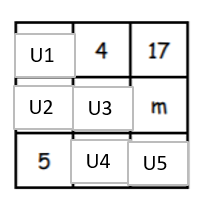
Where “U” stands for Unknown. So Unknown 1 is “U1” etc
U1+4+17 = U2+U1+5
Rearrange:
21 = u2+5
u2=16
Given this, 5+17+u3 = u2+u3+m
22 = 16 + m
m = 6
Zara
Follow it logically step by step:
Glen > Florence
Florence > Ahmed > Zara
Oliver < Glen > Zara
Yasmin < Glen
Ahmed > Oliver
Florence < Yasmin
If Florence is less than Yasmin and given Yasmin is greater than Glen and Glen is greater than Zara, Zara is the youngest
1,3,6,9
- Multiples of 3 being 3,6,9, (12 is not possible to include as the total of the cards is less than 20)
- Odd cards being 1,3,5,7,9,11
- This leaves 1,3,6 & 9 because the total of these is 19 so less than the target total of 20
10
The simple formula is (5×4)/2
Where 5 represents the number of teams. 4 represents the maximum number of games each team can play against. 2 being the required denominator
a) 68cm²
- Firstly we need to count the number of cubes. This is equal to 30
- For the 30 cubes, these can be split as follows:
-
- There are 12 cubes….the steps if you look from South East to North West angle. 2 sides visible so thats 24 in total
- Next the cubes at the side looking from South West to North East angle. There are 6 visible cubes and in total, 10 surfaces. This is the same on the other side so its 20 visible sides in total
- Finally, 6 cubes have 4 sides showing
- Total therefore is 68 sides showing
-
b) 3 cubes left
Easier than part a for sure!. 30 cubes in part a and 27 in part b
a) 8 small boxes in the bottom layer
- Given the height of the cube is 2cm, a total of 3 high can fit in the larger box
- The bottom layer of the larger box would therefore occupy 2 x 5 x 9 = 90cm³
- But some space would be left around the base. Below is an aerial view

b) 24 small boxes
- As mentioned above, 3 layers in total
- Therefore 8 x 3 =24
- A 1 x 1 would be left as empty space as you would not be able to break a small box and fit it into the sides
a) 11 balloons
- Always best to convert to the same denomination.
- If she has a 4metres, then this is 400cm. Each string 35cm, then the total is 400/35 = 11.4
- Total number of balloons = 11
b) 15cm
- 11 balloons would take 11 x 35cm of string
- This is 385cm
- Therefore, 15cm is left over
30
A classic question on the concept of fractions. If Ravi is left with 12 sweets and this equals 2/5, then you have to calculate what 1/5 equals. This is 12/2 so it equals 6 sweets
Therefore, each 1/5 = 6 sweets. There were therefore 30 sweets to start with in the box
40 metres; 10 wooden trays; 160 nails
The approach:
- There are 2 approaches.
- Work out what it would be for 1 bird table and then multiply up by 10 to get the total for 10 bird tables. However, this approach means that you start to deal in decimals as you would need 0.4 wooden trays per bird table. This can sometimes cause errors down the line
- Therefore, the approach I advocate is HCF.
-
- Look at the core numbers which is that you have the “requirements” for 4 bird tables and need to work out what is required for 10
- The HCF of 4 & 10 is 2
- Therefore, calculate what is needed for 2. In this case, that would be halving what you need for 4.
- So for 2 you need 8 metres of wood, 2 wooden trays and 32 nails
- Then work out “how many batches of 2s” you need to get for the required 10 tables
- So this is 5 batches
- The answer becomes (5 * 8 metres of wood); (5 * 2 wooden trays) and (5 * 32 nails)
-
9
Work backwards:
35 – 8 = 27. Divide by 3 = 9
a) 144
The last number in Row 12 will be 144. Spot the pattern which is that its the row number squared to equal the last number
b) 39
Again the patttern. (Row Number x 2) -1 . So for Row 20, it will be 20 x 2 -1
c) 10
Work backwards. Take away 1 and then divide by 2
d) 91
e) 855
A = 8; B = 1; C = 6; D = 4; E = 9; F = 3; G = 5
Detailed solution to follow
a) 5
Applying the rules, = 3 x 3 – 4
b) 6
Working backwards, 32+4 =![]()
So 36 = 6 x 6
c) 9
Slightly trickier. But you need a multiple of 72 with one option being 9
x² – x – 72 = 0
a) x = 2cm, y = 6cm
x = 2cm (8cm – A – B)
y = 6cm (14cm – E)/2
b) 52cm
Perimeter starting at point A = 2+6+2+2+2+6+4+14+4+6+2+2
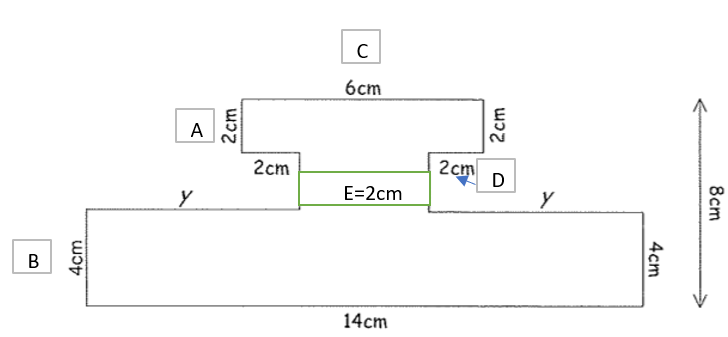
c) 72cm²
Area = (14×4) + (2×2) + (6×2) = 56 + 4 + 12
59
- When you have 2 pages next to each other in a 64 page paper, the 2 pages will add up to 65.
- Eg 1 & 64 or pages 2 and 63 and so on
- It will be a page towards the back of the paper. So 6 + x = 65
- Therefore, rearranging, 59
a) B E C
b) A E C & C A D
c) 14 different ways
a) 2
b) 5
c) 11
- With this question, you have to work backwards by each statement
- “He eats one more and gives the last one to Sean”. So before he did this, he had 2
- “He then eats another and then shares the rest out equally between himself and Detti”. So if he shared equally per sentence 2, then he had 4 before he ate one to start with. So this gives 5
- “He eats one and then shares the rest out equally between himself and Emily”. He had 10 before he ate one at the start of sentence 4. So he had 11
a) 50
- Substitute into the “rules” per the example. So this would give (10 x 10) / (1 + 1) = 100/ 2 =50
b) 5
- First solve (3☺4) = (4×4) / (3+1) = 16/4 = 4
- Then (4☺5) = (5×5)/ (4+1) = 25/5 = 5
c) 7
- Have to solve with algebra. 6 ☺ y = (y x y ) / (6 + 1) = y² / 7
- So y² / 7 = 7. Therefore, rearranging,
- y² = 7 x 7 . So y² = 49
- Therefore , y =7
6
Xp + Yp = 38. Where X = 4 page letter and Y = 3 page letter
- Some points to remember. The 3 page letter number of penpals should be an even number of penpals. This is because a 4 page letter * any number of penpals will always given an even number. Therefore, the 3 page letter can only be * 2, * 4, * 6 or * 8.
- The answer is * 6 (So 6 * 3 = 18) + (5 * 4 = 20) = 38
a) See below

b) 21
- Its important to recognise the relationship.
- So with 9 Dark Squares, there would be (2*d) + 3. This is the pattern there for 1 to 5
- So for 9 it will be (2 * 9) + 3 = 21
c) 10
- You have to work backwards given W=(2*d) + 3
- Given w=23, 23 = (2d) + 3. Rearrange to 23-3 = 2d
- 20=2d. So d must equal 10
d) 31
- If a pattern has 45 squares in total so again the trick is to recognise the pattern that derives the total
- First calculate dark. So Dark = (Total/3 – 1 ). = 45/3 -1 = 14
- Given this, white must equal (2*d) + 3 = 31
a) 12
b) 13
- Meera always tells the truth. Given this, David is 12. Since he said he was 13 and he never tells the truth.
- Meera is 11 since David is older than Meera
- Anne has to therefore be 13
a) 7 squares
- There are 2 patterns at play here. Firstly, the shapes alternate. So circle, x, square, plus sign etc. So the next shape will be a square
- Second pattern is that the number of each shape increases by 1. So 1 circle, 2 x, 3 squares etc. So the next one will have 7 squares
b) + sign
- This is because after adding the squares above per a), this takes you to 28 shapes. The next shape will be 8 + symbols. So number 30 will be a + sign
C
- This is similar to a prior question in this paper where we talked about visualisation and nets.
- The image is on the top left and if you unfold it and open it up, there will be a box on each edge. So its B or C
- There will be a triangle on each page so it has to be C
Change from £5 = £5-£1.39 = £3.61
55p + 84p = £1.39
500g of Sugar. £1.10 per kg. Therefore 500/1000 = 1/2 so 1/2 * £1.10 = 55p
750g of flour. £1.12 per kg. Therefore 750/1000 * 112/1. Think of HCF though. The HCF of 750 *& 1000 is 250. Therefore, given you know what 1000g (1kg) costs, you can work out 250g.
This would be £1.12/4 = 28p per 250g
So 750g of flour = 28p * 3 = 84p
a) See below

b) The pattern that is there at present (1,4,9,7,7,9,4,1,9) continues to repeat. The way to test this is to apply the same digital root test for 10², 11², 12² and you will see the pattern continue
c) 1
d) 4
e) 9
- A number that is a perfect square never ends in 2, 3, 7 or 8. If your number ends in any of those numbers, you can stop here because your number is not a perfect square.
- Obtain the digital root of the number. The digital root essentially is the sum of all of the digits. If you’re lost, don’t worry, we’ll go over each step in more detail below.
- All possible numbers that are a perfect square have a digital root of 1, 4, 7, 9.
a) 555
Given 6*37 answer and 9*37, 15 * 37 will be these 2 answers added together
b) 888
(9*37 + 3*37) * 2
c) 499.5
(9*37)*3 = 999.
999/2
d) 962
(6*37) * 4 = 888. So this is 24 lots of 37. To get another 2 lots of 37, you take 1/3 of the answer for 6 * 37.
So 222/3 = 74. Then 888 + 74
a) 20
W 10 – 5 =X + 5 = Y * 2= 10 + 10 = Zoe
b) 2
Work backwards: Zoe calls out 4. Take away 10 as she added 10 to the number. This gives minus 6. Therefore, Yana must have had minus 3. Xanthe must have had 2.
c) 6.5
If Yana whispers 3, she was originally given 1.5. Xanthe must have had 6.5 from Wendy
d) 0
e) 9
f) 16
7
jj = jupiterian jellyfish
Summarise the question in algebra format. It will make it easier to solve. Total Tentacles:
(jj x 25 ) + (20 – jj) * 8 = 279
25jj + 160-8jj = 279
17jj + 160 = 279
17jj = 119
jj = 7
a) 27
540 ÷ 20
b) 50ml
20ml is added to 4 litres of water. Therefore, think in HCF of 4 & 10. This is 2. So first calculate 2 litres which would be 10ml. Therefore, 10 litres would be 5 * 10ml = 50ml
c) 3 weeks
6 litres of water would be 30ml of Kleeno per day. Therefore if a bottle contains 540ml, this would be equivalent to:
540 ÷ 30 = 18 daily cleans.
Given that the floor is cleaned every day apart from 1 day, then 1 week is 6 days of cleaning. Therefore this represents 3 weeks of cleaning
Answer to follow. To be added by David
Given that only one statement is correct:
- If the ‘car’ was in the Blue Box, that would mean that the statements on the Blue Box and Red Box were both correct.
- Similarly, if the car was in the Yellow Box, that would mean the statements on the Red and Yellow were both correct.
- However if the car is in the Red Box, then the only statement which is true is the one written on the Yellow Box ‘The car is not in the Blue Box’
a) Number of packets of apples = 4
Oranges = x. Apples = y
5(3x) + ?(4y) = 31
15 + ?(4y) = 31
?(4y) = 16
?y = 16/4
Number of packets of apples = 4
b) 3 packets oranges and 5 packets of apples
3y + x = 29. = 12 + 3 = 15 pieces of fruit. He needs a further 14. Therefore, the combination would be a further 2 packets of oranges and 2 packet of apples. This equals 5 packets oranges and 3 packets apples
c) 16
Given apples = y,
40 pieces
4y + 3(11-y) = 40
y+33 = 40
y = 7. Therefore, with 4 apples per pack, thats 28 apples. You therefore have 3 oranges per pack and in total 12 oranges. Therefore, apples > oranges = 16
a) 5
10T = 18 papers per teacher over the 3 hour timeframe. Which equals 6 papers per teacher per hour
To mark 90, requires total of 15 hours. Therefore 5 teachers
10/180 * T/90 = (10*90)/180 = T. T=5
b) 5
3 x 10 = T x 5 = 30/5
c) 120
6 papers per hour * 20 Teachers = 120 papers
26cm²
Area covered in paint if all 6 cubes are dipped in paint is W*L*D = (1*1*1) * 6 sides * 6 cubes = 36
However, there are 10 covered faces. (remember to count those back to back faces as 2). So in total, 10cm²
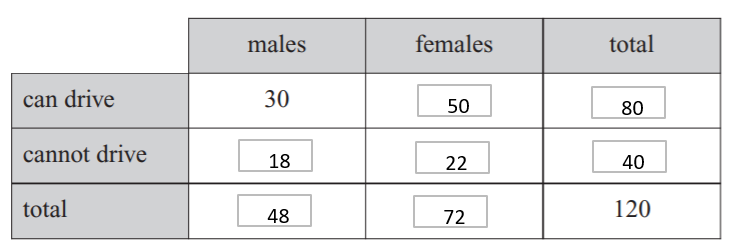
Just complete one section at a time. 3/5 female. So 3/5 * 120/1 = 72 female. So this leaves 48 male
If 30 males can drive , 18 cannot
If 40 cannot drive, this means 22 females cannot drive as we already know 18 males cannot
This leaves 50 females who can drive and a total of 80 males and females
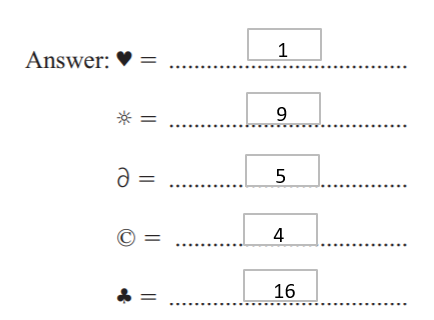
The easiest one to start off with is ©. Given that ? x? = ♣, you have to use a square number. 4 x 4 = 16. So this fills in the answer for © and ♣
Given ∂ + © = * then given we know © = 4 and the numbers available to use, ∂ is 5. So, * = 9. Finally, ♥ = 1
a) See below

b) 14
There is always one more hexagon than the pattern number
c) 26
The relationship is that you multiply the pattern number by 2 and then add 6 to get the number of white hexagons. So 2pn + 6. (2*10) + 6
d) 23
Work backwards. 50 white less 6 = 44. Divide by 2 gives you 22. So this represents the number of black hexagons
Given the rule in b), it has to be 23
a) 56
Work backwards. 20 MINUS 6 = 14 MULTIPLY BY 4 = 56
Sense check and work through from 56. 56/4 + 6 = 20
b) 7.5
6/4 = 1.5 + 6
c) even and multiples of 4
d) 48
18 minus 6 = 12. Multiply by 4 = 48
e) 216
Work backwads twice. 9 MINUS 6 = 15 X 4 = 60. Then again. 60 minus 6 = 54 x 4 = 216
29
He has 20 bars which means he gets 6 free bars. So 20/3 = 18 Remainder 2
He then has 6 free bar wrappers + 2 reminder = 8 bars
He then uses these 8 wrappers to get 2 free bars and this also leaves a remainder of 2
Then he uses the 2 remainder + 2 new wrappers he gets from the 2 free bars to get 1 more bar
So total is 20 + 6+ 2 + 1
a) 19
(5 x 4) -1
b) 8
Remember that normally, it would be takeaway 6 on the left hand side. If you take this to the other side, it will become addition. So lets do this:
m ? = 26 + 6
m ? = 32. So given its ? x 4, ? must be 8
c) 7
5 ? (4 * 4 – 3)
5 ? – (13) = 5 * 4 – (13) = 20 – 13 = 7
d) 9
[(6 X 4) – p ] x 4 = 56
[24 – p] x 4 – 4= 56
96 -4p-4 = 56
-4p=56-96+4
-4p = -36
p=9
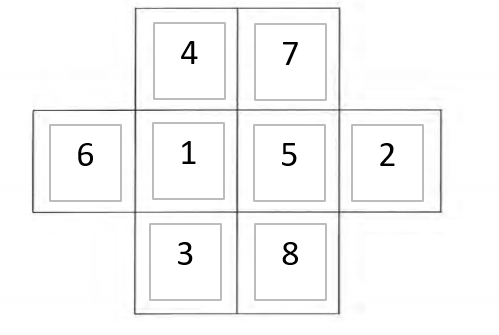
Another solution or approach is that the middle 2 squares touching a lot of squares have to be 1 and 8 since they have only 1 adjacent number which allows you to put more numbers around them… once you start there, the puzzle virtually solves itself
M,C,J,D,R
D,R,J,C,M
a) £2.60
Questions which mention something is “twice as much as something else” or a multiple of something else, requires a few possible approaches. One is to use ratios. So Cake:Drink is 2:1
There are 3 parts altogether. So £3.90/3 = £1.30 per part
Cake is 2 parts so cost is £2.60
b) £1.45
Tea + Fizzy drink = £2.60
Fizzy drink 30p more. So £2.60/2 = £1.30 if it was an equal price. To get a 30p difference, you add 15p to one and take 15p to the other. So Fizzy drink will cost £1.45 and revised cost for Tea will be £1.15
c) 91p
A+B = 57p
B+P = 56p
A+P = 69p
Therefore, there are 2 apples, 2 bananas and 2 pairs. If you add all of the above together and x2, you get £1.82
Divide by 2 gives 91p
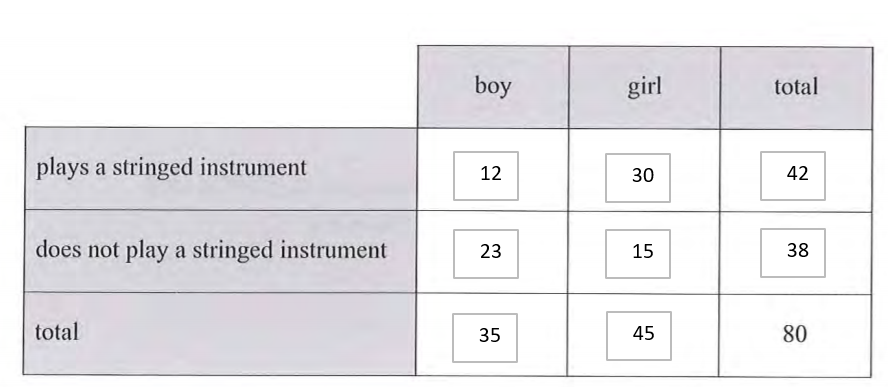
Just read one statement at a time and use it to complete the table where possible
- 35 Boys. Therefore , 45 girls
- 2/3 of girls play stringed instrument. So 45 x 2/3 = 30. Which means 15 do not
- 38 do not play stringed instrument. Therefore, for boys, its 38 – 15 = 23
a) See below
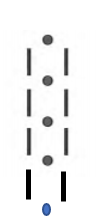
b) See below

c) 9
Always one more than the pattern number
d) 15
Spot the pattern? Divide lines by 2 to get to the pattern number
e) 60
Formula would be : (Dots x 2) – 2 = number of lines. 31 * 2 = 2 = 60
a) 87
She always tells the truth and the answer has to fulfill each statement. Given that its a multiple of 29 and is <100, its logical to start with going through multiples of 29. So 29,58,87
b) 60
She never tells the truth. So:
The number is less than 100. It is a multiple of 10. It does divide by 3 exactly and it has NO remainder when divided by 4.
Think of multiples of 10 and those multiples that divide exactly by 3 and are less than 100. These are 30,60 & 90. Of these the only number that is a multiple of 4 leaving no remainder is 60
a) 75g
150g required to make 8. Therefore, to make 4, it is half of this
b) See below
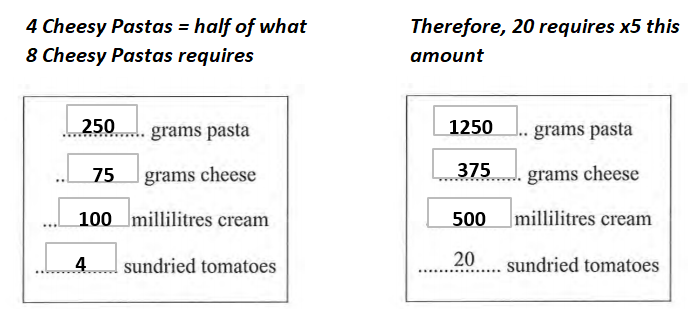
With these questions, its vital to think of HCF. What is the HCF of 8 (in the start of the question) and 20 portions? The answer is 4. Therefore, if you can determine the amount required for 4 Cheesy Pasta’s , you can then calculate the amount required for 20 as it will be x5 what you have for 4 Cheesy Pasta’s
a) 11
2 x 3 + 5 = 11
b) 13
2 x 5 + 3
c) 6
Work backwards. Output = 23 minus 5 = 18. Divide by 3
d) 1
a) 18
3=40p. Therefore, number of 40p’s in £2.40. 6 times.
b) £4.40
If 3 stickers cost 40p, then 3’s into 33 = 11x . Therefore 40p x 11
Mary, Angel, Innkeeper, Joseph, Shepard, Herod
a)
i) 174
ii) 87
b) Sum of the white squares either side of the grey square equals the grey square total
c) See below
Hoop number is defined in this pattern as the opposite grey squares adding up to 87
Complete the hoop for 61 which would give 72. Then complete the sum of 72 which is the 2 white squares
Work your way around the grid
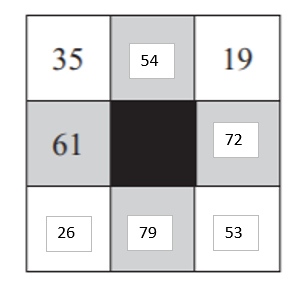
a) 15 laps
Convert the 6km to m which gives 6000m. 400 into 6000
Remove like for like zeros to make it easier to work through. So it becomes 4 into 60. This gives 15 laps
b) 13.8km
Always step by step on what you know:
- Marathon 13.4km
- Running Track 3 laps @ 400m = 1.2km
- Total of the above is 14.6km
- This leaves 42.2-14.6 as the town run. Which is 27.6km
- Half of this town run (as its 2 laps) would give 13.8km per town run lap
a) (2,6)
Read horizontal axis always first when reading coordinates. Then Vertical axis
b) See below
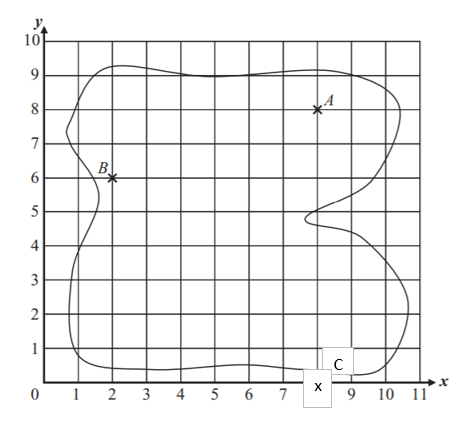
c) i) (8,2)
A quarter of the distance from C to A would be from (8,0) to (8,8). Therefore, the difference in spaces is 8 on the vertical axis from C to A. 1/4 of this is 2 so the revised co-ordinates would be (8,2).
c)ii) (5,7)
A is (8,8) and B is (2,6). The difference between the coordinates is (-6,-2). Therefore, you move half of this from the point A which means you move by (-3,-1) from point A. This would give revised co-ordinates of (5,7) for the Silver. You apply addition and subtraction techniques in Coordinates
Answer below
The trick here is to start with what goes opposite 4 and in which box? This is because you need to get either 6,7 or 8. It can only be the number 2 given that 3 is next to 4 rather than opposite 4. So 4 pairs opposite with 2. Then continue from there

a) 9,180
The approach is to take 17 x 2. Given that you already have 17 x 538, its just another 17 x 2 that needs to be added onto the answer. So add 34 to 9146
b) 14,526
The change is from 17 to 27. So just take the difference of 10 and multiply by 538. This is 5380. Add this to the original answer
c) 269
Re-arrange the formula. 9146/17 = 538. So 9146/34 is half of the prior answer
a) 250/2 = 125g (amount for 6 waffles) x 3 = 375g
Think about HCF for 12 waffles v 18 waffles. The HCF for 12 & 18 is 6. Therefore, the best approach is to take 250/2 (to give 6 waffles). Then x that result by 3
b) 2eggs = 12 waffles. Therefore 1egg=6 waffles. 5 will therefore = 30 waffles
Again think about HCF of 2 & 5 which is 1. Therefore, the best way is to work out how many waffles you get for 1 egg and proceed from there
c) 75g
1oz = 25g. So 13oz = 13 * 25 = 325g
325 – 250 = 75g more
a) See below…
(6×4)-3 = 21
(33+3) / 4 = 9 (need to work backwards so therefore, reverse the signage)
(-1+3) / 4 = 0.5
b) x2 + 2
Try with the bottom line first as these are positive numbers so slightly easier to work with
704
Similar to a prior question. Try a simpler example to see what happens. 25X4=100. So , substituting this into the question means 100/2=50
The divide by 2 is halving the prior number of 4 because in the question, 100 is halved to 50. Applying this approach, gave us 704 because we take 352 x 2
a) 972
Simple operations question. But a trick here is for students to “sense check”/ estimate their answer. So perhaps round 27 up to 30 and 36 down to 30 just to make sure you are “very broadly” in the right ballpark. This would give you 900. So its just to ensure you haven’t for example left out the zero when you are doing the second line of the Multiplication calculation. Or any other major error
b) 486
Students should see that 18 is half 36. So the calculation is not 27/18 but in your workings, should be 972/2
c) 9.72
Simply add the number of digits after the decimal place in the question. This is 2. Then move the decimal from (972. ) in your answer to 9.72
a) 3/7
The way to look at this is how you would approach a simpler question: Lets say….10+6 = 16. So 16-6=10
Therefore, the same approach says that 3/7ths is the answer. Proven, you can do the following:
25/42 – 1/6 = 25/42 – 7/42 = 18/42 = 3/7
b) 11/12
Same test using Example numbers. 3X7=21. Therefore, 21/3 = 7 .
The examples given above are simply that. Its easier to think of the same principles using examples and then substitute in the real question numbers rather than think of the question as a tricky fractions question and try and work it out.
i) 10 miles
ii) S to B to F to E to D to T
The thing to note here is that the map is not drawn to scale so extra attention has to be paid to the miles between different points
iii) 40 minutes
Time = Distance/ Speed. So substituting into the formula, Time = 10/15 which = 2/3 of 1 Hour (10/15 x 60). So thats 40 minutes
iv) 8 minutes
The revised route is S-B-C-T. So an extra 2 miles
This means 12/15 of 1 hour so 12/15 x 60 = 48 minutes
Difference being 8 minutes
Completed blanks in the following order
81-25=56
14×4=56
They are the same. (NOTE: This is a nice trick to remember). Follow the example guideline.
(552+448)x(552-448) = 1000 x 104 = 104,000
(8.5+7.5)x(8.5-7.5) = 16 x 1 = 16
(19/37+18/37)x(19/37-18/37) = 37/37 x 1/37 = 1/37
(25001+24999)x(25001-24999) = 50,000 x 2 = 100,000
NOTE: The above is a great approach to remember for future questions.
i) 0800
The best way to read tables is always to read them horizontally and vertically. Use a ruler if needed to ensure no misalignment in reading
ii) 36minutes
Read across from 0727 Radlett until you align and then move down to the City in the same column
iii) 12minutes
Firstly evaluate St Albans to West Hampstead 0722 which arrives West Hampstead 0745. 23 Minutes
Secondly, similar for 0658. Arrives West Hampstead 0710. 12 Minutes
Work out difference
iv) 0728
Work backwards. Look at last train to get to the city before 0800 which is the 0755. Then work vertically up to see time it leaves St Albans
v) 01719
Work backwards again on this:
0855 train she needs to catch. Less 30 minutes check in means 0825. Less 10 minutes platform change means 0815. So the train arriving before 0815 at St Panceas is the 0812 train. She therefore needs to get the 0744 from St Albans
Less the 25 minute walk means that she should leave home at 0719
i) 1 burger £0.99
1 chips £1.20
1 coffee £0.65
Total £2.84
Do your workings neatly by aligning the columns for each digit
ii) Change £5.00
– £2.84
= £2.16
4 coins therefore being £2 coin, 10p, 5p, 1p
iii) 3 Sausages £1.35 (£0.45 x 3)
Meat Pie £2.20
Drink can £0.35
Total £3.90
iv) £50 – £44.40 = £5.60 spent
2 Meat Pies £4.40 (£2.20 x 2). Leaving £1.20 to spend
1 Coffee £0.65
1 Tea £0.55
Total £5.60
The above is by some trial and error. It is worth adding in the larger ticket items first. ie the Meat Pies. Then understanding where that leaves you. The answer should then be clear as being 1 coffee and 1 tea
i) 10am 31st January
ii) 1pm 1st February
Like prior questions, work through this question one step at a time.
i) If its 11pm in the UK on 30th January and Australia is 11 hours ahead, then one way is to add 12 hours to 11pm and take 1 hour away. So the time in Australia will be 10am. Its then the following day there so its 31st January
For number of days in the month, remember the knuckle test.!
ii) Its easier to break this down into 2 phases. Start with the time in Australia when Matilda leaves the UK:
She leaves at 10am 31st January.
Then add on the flight time of 27 hours which will be 1 day + 3 hours
So in total it will take you to 1pm on 1st February
Try and do one element at a time. Students who try and add 27 hours straight onto 10am make mistakes. So breaking it down into 1 day and then separately 3 hours, makes it easier
5 large
13 small
Total 18 crates needed.
Question requires breaking down the words and going statement by statement
L = 12 cartons
S = 4 cartons
(5 x 12) + (20 x 4) = 140 capacity
To store 110, you would use all the large crates first:
- 5 large used = 60 cartons. So 110-60 = 50 left to find crates for
- 50/4 = 12.5. So you need 13 crates of which the 13th will have 2 cartons in there. The other 12 will be full with 4 each. So 48

